The left that was

This story originally appeared in the February 6, 1967 issue of Sports Illustrated. Subscribe to the magazine here.
For a few moments on the night of February 6 in the garish surroundings of the Houston Astrodome, Muhammad Ali may seem to teeter on the edge of defeat by Ernie Terrell, the WBA champion of the boxing world who is challenging him for the real world-heavyweight title. But Terrell's dream of an undenied championship will be short-lived. Between perhaps the seventh and ninth rounds of the fight, Muhammad will knock him out.
Physically, Terrell is the most formidable opponent Ali has met since his knockout of Sonny Liston in Lewiston, Me. on May 25, 1965. Though taller than most heavyweights, he is a solid man equipped with the tools needed to fashion a victory: confidence, a long, jolting left hand, the ability to fight well and destructively inside and the capability of accepting a hard punch to the head without coming apart. So much for the credit side. Unfortunately, Terrell, like so many of his predecessors, cannot hope to equal Ali in hitting speed or speed afoot. Unfortunately, too, he is a high-strung, nervous man.
"He's the scariest heavyweight I ever saw," a fight manager said not long ago. "I don't mean he's afraid. But he's so tense before a fight that when he walks down the aisle to the ring he's used up so much energy it's about the same as if he had gone six rounds already. So he runs out of gas after maybe seven rounds. Then he can't keep that long left hand up or out, and he can be hit over it. That can be a disaster against Clay."
Curiously enough, Terrell may be more confident against Clay than he has been against less formidable foes. His confidence stems from a previous experience in the ring with the champion. Back in 1962 Terrell was a sparring partner for Clay when the latter was preparing for a bout with another heavyweight—Don Warner. Jimmy Jacobs, the world four-wall handball champion, who has possibly the most comprehensive collection of fight pictures in the world, filmed a few rounds of the two fighters working together in the Fifth Street Gym in Miami Beach, and the film shows that Terrell bullied Clay. Much bigger and stronger, he hit Clay often with his left and sometimes crowded Clay into a corner, where he ripped him with damaging punches to the belly.
"I wasn't the same then," Ali said in Houston recently. "What did I weigh in 1962, Angelo?"
"Eighty-six," said Angelo Dundee, his manager. "You were pretty green. You weren't the same fighter. But the pictures don't show everything. You remember you bombed him later."
Whether Angelo's version of what happened is accurate or not, Clay did not keep Terrell around for long.
"They cut him off," says Sam Solomon, who trains Terrell. "He called me in Chicago from Miami Beach and said they cut off his hotel money and wouldn't pay him eating money, and he needed something to get home. I guess that shows how they felt about him."
Terrell has his own interpretation of his relationship to Clay—then and now. It is a good box-office interpretation, and Terrell may even believe it. "I wasn't the same fighter then," he says. "I didn't have the left hand I have now. I couldn't hurt people with it. He was a punk then, and he's a punk now. He wasn't a complete fighter then, and he's not a complete fighter now. He's where he is because of management. They made sure he never fought a tough fighter.
"Sure, he's fought the same names I've fought, but he didn't fight the same bodies. Liston was a good fighter once, but he had to be 45 when Clay beat him. Patterson was far past his prime. Clay specializes in has-beens, old men and nothings. I fought all the tough guys when they were still tough, and every fight was life or death for me. I don't want to take anything away from him. I'm not saying all his fights were setups, but they were smart picks by his managers. No tough fights.
"He had all that money behind him, all that money for training, to get the best trainers, the best sparring partners, to keep Old Man River away from the door while he was learning his trade. I learned mine in the ring. Every time I fought, Ernie Terrell was going to war, every fight was tough competition—Amos Lincoln in 1962, Cleveland Williams when he was healthy in 1962, Zora Folley when he was 31 years old in 1963 and Cleveland Williams again. Four years ago Zora Folley was tough, and you didn't see Clay fighting him. I beat the best at their best and lots of times I was the underdog, but you didn't see nobody write about that. I'm not bitter, but the press hurt me. They took the jingle out of a lot of my purses. Now I'm the WBA champion and that's the only champion, but I got to take the small end of the purse."
Terrell is a touchy, morose man who feels keenly the lack of attention he gets as WBA champion. He threatened to pack up and leave Houston when he discovered that the posters for the fight had Clay's name in bigger type than his and were graced with a large drawing of Clay. "I got a grandmother has more sense than to do a thing like that," he said. "Rademacher even got the same notice" as Patterson when they fought, and he was just an amateur. Why would they do a thing like that?"
The fact that he is getting less money rankles, but he can justify accepting it.
"Sometimes, the best things are cheap," he says. "I got the short end, but it's still pretty good. I figure maybe half a million bucks is enough for the satisfaction of beating Clay. The nicest thing I can think of is beating Clay. All I am worried about is that he is so controversial that in a flash he can say something that would knock the fight out. When I think about that, I double up with a cramp. That's how much I want him."
Terrell's belief that he can beat Muhammad Ali is based entirely on what he did against the young Clay in Miami Beach and on comparative performances against fighters like George Chuvalo and Doug Jones. In fact, there is little to choose between how badly Clay chopped up Chuvalo and how badly Terrell beat him. Admittedly, Terrell, in a lackluster victory over Jones in Houston, was a trifle more impressive than was Clay against the same man in Madison Square Garden, but for Clay that was long ago and he truly is a different man now—physically and mentally.
Riding out to his training site in Houston recently, Clay expounded on the difference—the physical difference. The mental difference is explicit in his relationship with a small coterie of Black Muslim hangers-on who surround him.
"The first time I fought Jones," he said, "I was new. I hadn't been in the ring for eight championship fights. They have made me a different man. After Terrell fought Jones in Houston, I boxed with Jones in an exhibition in Atlanta. I did like this. Tap, tap, tap. Little light left hands and right hands on the head. Tap, tap, tap. Whenever I wanted to. No trouble."
He demonstrated the tapping by rapping the dashboard of the Lincoln Continental with a left, then a right. As the radio played, he stopped to listen.
"Hey," he said. "Listen to that. Ain't that Terrell?" He listened quietly for a moment. "Yeah," he said, after a few moments, "that's Terrell." The music was rock 'n' roll or a folk song, and he tapped his fingers on the dashboard appreciatively for a while.
"He sing good," he said.
He worked out languidly, letting his sparring partners crowd him into a corner and pound him at will to the belly. Once, while Mel Turnbow, a big man, was belaboring him, he looked up at the spectators and smiled.
"I'm tired," he said. "I'm just resting." When he felt like it, he moved around the ring with all the speed and grace one has come to expect of him, and his hands—left and right—were faster than those of most middleweights.
Terrell was working out in the same place, and when Clay finished he wanted to wait long enough to create one of the scenes that have become the trademarks of his fights in the United States. When a member of his party demurred, he became truculent.
"You ain't the boss," he said irritably. "I'm the boss."
But Terrell came late, and Clay missed an opportunity to bug him.
"He starts a fight real early," Terrell said. "Before the bout is signed. Gets under your skin. Maybe that's his best talent, being a master of psychological warfare. I got nothing against him or his religion, but he's an extremist and all extremists are great at twisting things. He does it to take your mind off the fight. You don't get on national TV and say a man is Uncle Tom when you know it's a lie, but he did. He wants me to worry about what people think about me, wants to confuse the issue. But it is dangerous to be distracted. I'll just concentrate more."
Terrell has a somber face, and he thought about Clay's prefight antics with a brooding expression.
"He wants you to think about crazy stuff," he said. "The ankle punch, the Ali shuffle, now it's the double-clutch shuffle [see cover]. That's all nonsense, but it worked against Liston and Williams and Patterson. He drove Patterson crazy with it. But me, I dig him. I understand what he is up to with that absurd nonsense."
In his suite on a day off, Clay listened with pleasure to a recording of a tune called The Ali Shuffle while he explained how he would beat Terrell.
"It depends on how the fight go," he said. "Maybe I'll go right out and take him. Then maybe I'll wait a while, move around, pop, pop, hit him with the left hand, wait until I'm ready. Way I feel now, a good quick knockout is too good for him. Maybe I better punish him."
Clay is not the fresh-faced, ingenuous young man who prepared with trepidation to face Liston in Miami Beach three years ago and listened to advice humbly. In his suite one of his coterie offered a suggestion and his face, grown mature and tough, became severe.
"You the boss?" he asked, angrily. "You the boss? I'm the boss."
While his new-found (and relative) independence may not make him a more ingratiating personality, it does have a definite value in the ring. Except perhaps for Karl Mildenberger, Clay has dominated his recent opponents almost from the time he stepped through the ropes. He certainly will try to dominate Terrell. He does not always do this aggressively, as he did with Liston in their second fight when he met Sonny in the middle of the ring with a stinging right hand to the face. Against Floyd Patterson in Las Vegas, for instance, he spent the first round moving and ducking and proving that it would be impossible for Patterson to hit him. He may do the same thing with Terrell.
"Move and move and pop, pop, pop," he said. He had just come from a personal appearance at a department store, and he was nattily dressed in a dark suit, striped shirt and dark tie. He moved around the living room of the suite, jabbing with his left hand and dancing from side to side.
"He'll move from side to side against Terrell's left," said Dundee, watching him. "Give him a target that's hard to hit. Then he'll counter over the left with his right hand."
"When I get him timed," Clay said, "then he shoots the left, and I start the right at the same time, and he can't hit as fast as I can hit. Nobody can."
Clay is, indeed, one of the best fighters in history at scoring with a right-hand counter over a left-hand lead. He probably will hit Terrell with the right-hand counter, but how much force it will carry depends upon whether he can set himself to deliver it. Punching from a flat-footed stance against Cleveland Williams, Clay was powerful. When he hits while moving and on his toes, his blows do not carry as much authority.
Dundee tends to discount the obvious advantage of Terrell's height and reach.
"They'll be the same height in the ring," he said. He was in the Fifth Street Gym in Miami Beach when he said this, and he walked over to one wall upon which a series of pencil marks climbed over six feet.
"Here's Clay," he said, reaching up to point out a mark at about the six-foot three-inch level. He called over a towering young heavyweight who was working out in the gym and had him stand with his back to the wall. He marked his height and said, "And this is about how tall Terrell is. But you look at him in the ring. He gives away his height. He doesn't fight straight up. He has a real wide stance, and that makes him maybe a couple inches shorter. Then he leans over when he jabs, and that brings his head down even farther. People who figure Clay will have trouble because he will be punching up at an opponent for the first time are wrong. In the ring, they'll be about the same."
Clay, of course, is a stand-up fighter who does not crouch even when avoiding a punch. But even if he does stand as tall as Terrell in the ring, he will be inches short of Terrell's extraordinary reach.
Terrell's strategy will be to keep Clay moving with the left hand, to crowd Clay much as he did in their sparring sessions in Miami Beach.
"You see the Mildenberger fight?" Terrell said last week. "You see how he kept busy in the first two minutes of each round? He kept jabbing, jabbing. It wasn't important if the blows landed or not, or if they were strong. He kept tapping and touching Clay on that pretty face, and Clay couldn't handle it. He kept feeling that pitty-pat in his face, and he couldn't get untracked.
"With me, he's gonna think my left glove is tied to a heavy-duty spring. It's gonna be all over his face and his body. I can move the left around good, real good. Ask Chuvalo about that. I mixed him up fine. When he got his right up to protect his face, I went under it to his body with the left and you could hear him holler 'Oof!' I'll do that to Clay."
Terrell is confident that Clay will not be able to reach him.
"I'm six six and he's six three," he says. "I got longer arms, and I use them for an advantage. You talk about styles? He's made to order for me, and mine is the worst possible for him. He's good at pulling back from a punch, but I don't throw just one. I come in with a double and triple jab. Maybe the first won't land, but the second or third will when he runs out of the ring. And I'm apt to hook off the jab in mid-stream, too."
He stood up and turned sideways, left arm extended, in his fighting stance.
"You take a book of matches," he said. "Stand it up facing you and flick at it with your finger and you gonna hit 10 out of 10 times. Now you turn the edge toward you and try again, and it ain't that easy to hit. That's the kind of target I am. I'm edge on to Clay, I'm like a tall, skinny pencil he can't hit. I'm not tailored for him to beat like Liston or Williams or Patterson. He calls me a one-armed bandit and a giraffe and things, and I'll go along with him if it builds a pile of money. But when we fight, he's gonna have to take it for the first time—I'll be hitting him from outside his range to hit back, and I'll tie him up in close. That side-to-side move don't bother me—I've had that before. Chuvalo got to Clay, and if he can do it I'll do it easy."
If Terrell is as confident as he seems, he'll probably come out hard, jabbing Clay and keeping him off balance for the first few rounds. He has trained very hard for this fight, running twice as much as usual, so he may keep his strength for a longer time. If he can reach Clay consistently with his pistonlike jabs, he has at least a chance. If Clay dances safely out of range on the periphery of Terrell's attack, then he will win in the middle rounds when he has timed his counters to Terrell's hand speed.
Terrell is a pleasant, soft-spoken and gentle man, and he would make an admirable champion. He is, you might say, a prince among fighters. Unfortunately, he is fighting the king.
Good night, sweet prince.
SI's 100 Greatest Photos of Muhammad Ali
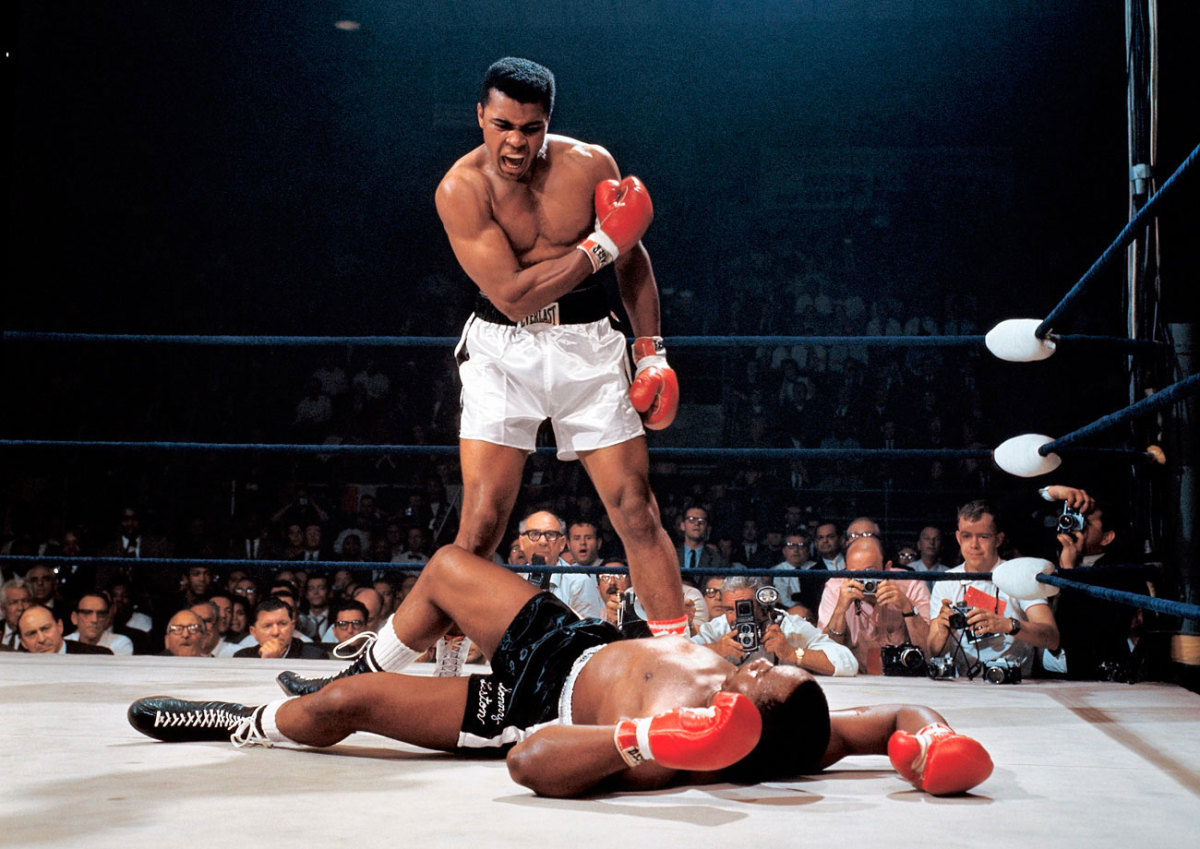
In one of the most iconic and controversial moments of his career, Ali stands over Sonny Liston and yells at him after knocking the former champ down in the first round of their 1965 rematch. Skeptics dubbed it "the Phantom Punch," but films show Ali's flashing right caught Liston flush, knocking him to the canvas. Refusing to go to a neutral corner, Ali stood over Liston and told him to "get up and fight, sucker."
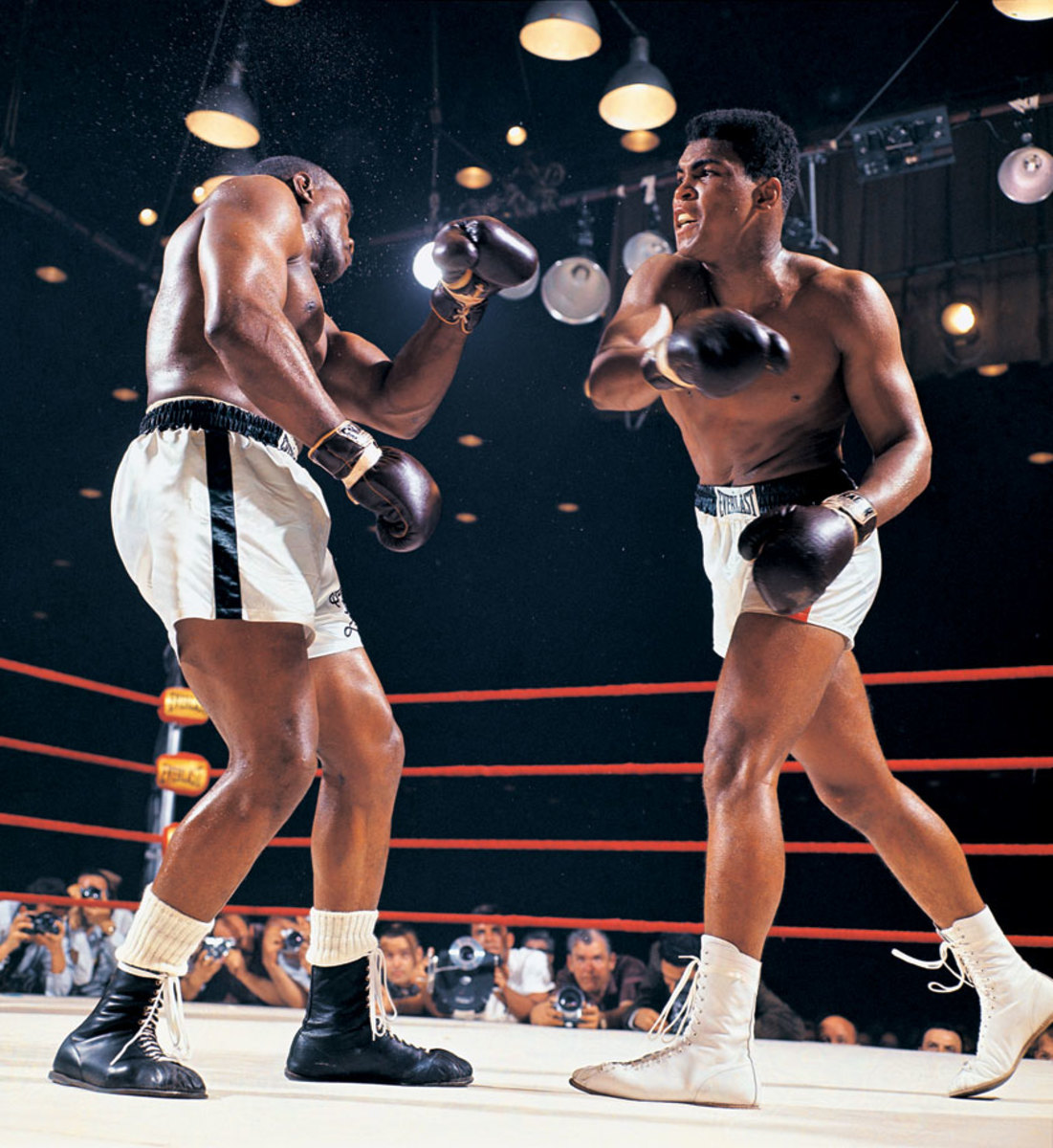
At 22-years-old, Cassius Clay (Muhammad Ali) battered the heavily favored Sonny Liston in a bout that shook the boxing world. The fight ignited the career of one of sports' most charismatic and controversial figures, whose bouts often became social and political events rather than simply sports contests. At the peak of his fame, Muhammad Ali was the best known athlete in the world. Liston, one of the most feared heavyweight champions in history, was a 1-8 favorite over the young challenger known as the Louisville Lip. But Clay, here stinging the champ with a right, used his dazzling speed and constant movement to dominate the action and pile up points.
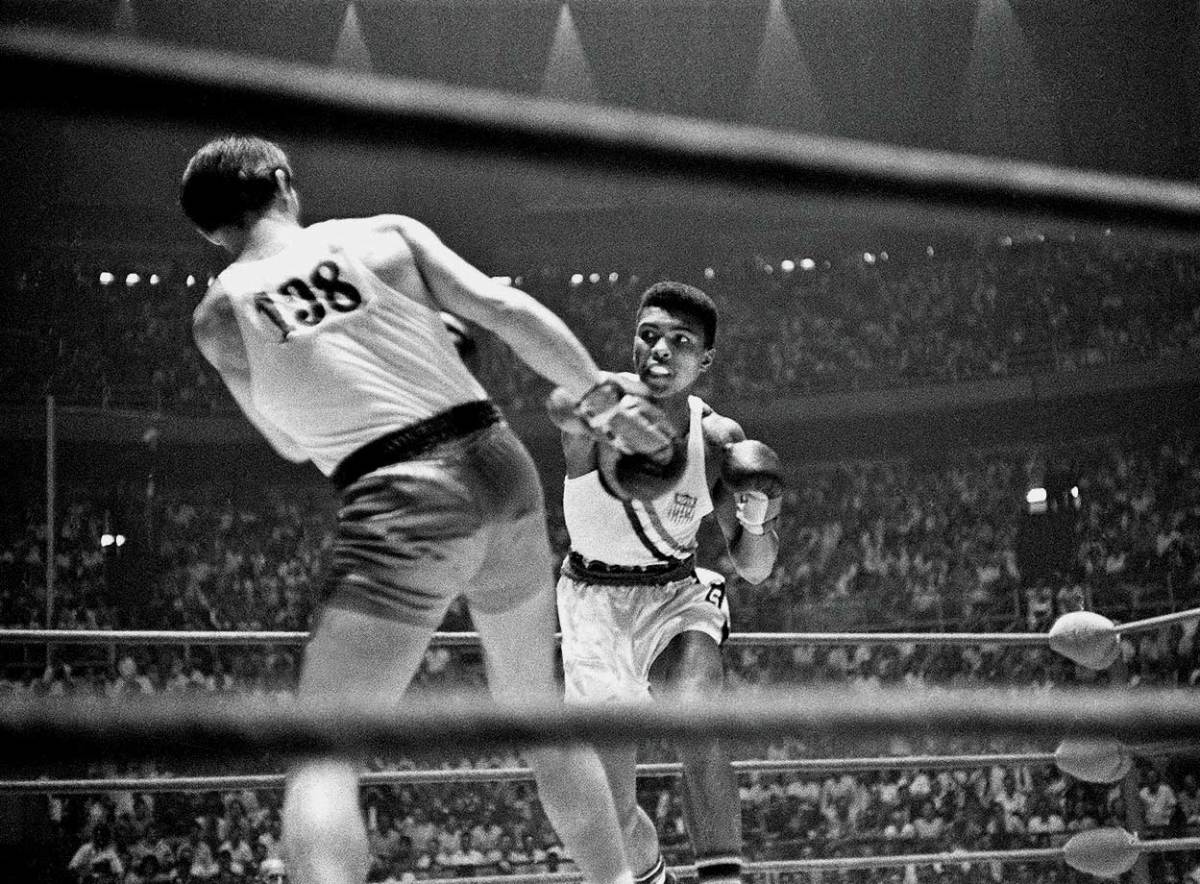
Cassius Clay punches Zbigniew Pietrzykowski of Poland during their gold medal bout at the 1960 Rome Olympics. Clay defeated Pietrzykowski 5-0 for the light heavyweight gold medal.
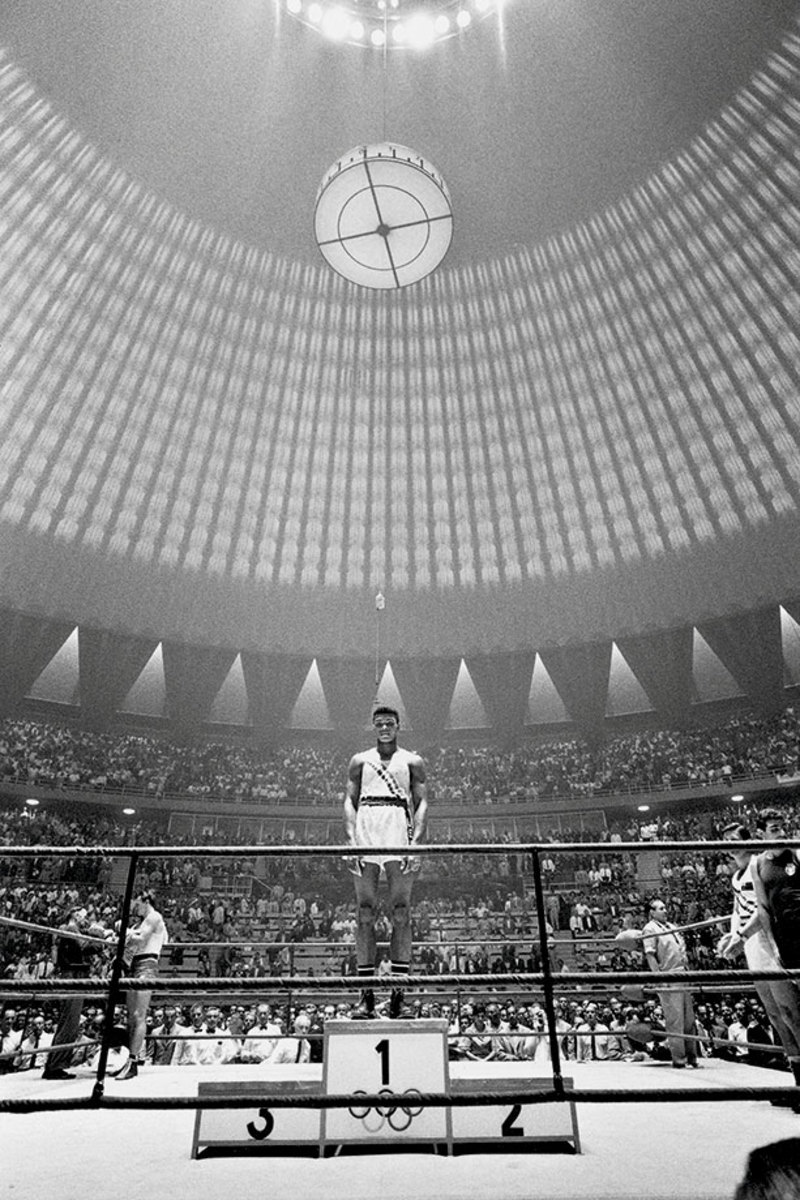
For the 18-year-old from Louisville, here atop the medal stand after his Olympic victory, all roads led from Rome. Clay finished his amateur career with a record of 100-5 and made his professional debut two months after the Games.
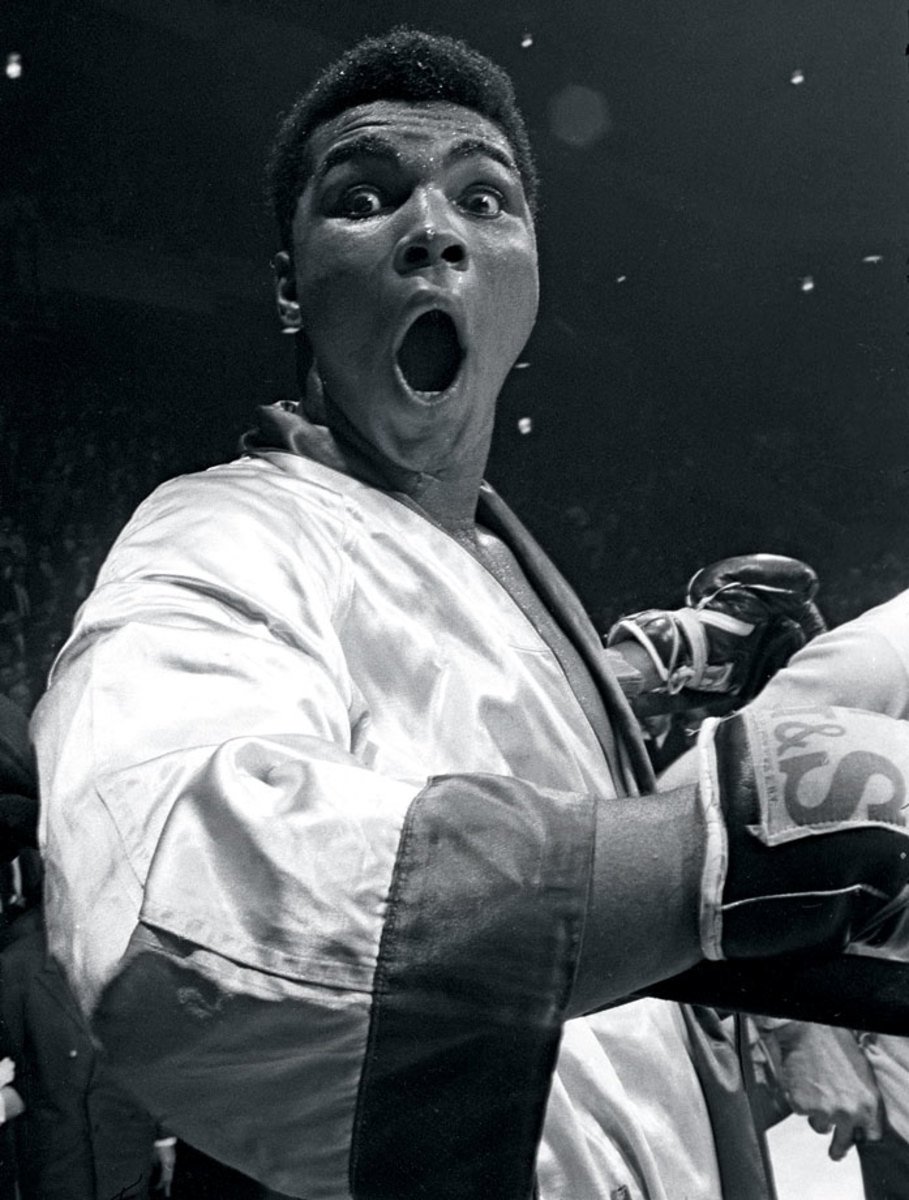
Undefeated in his first 17 pro fights, Clay mugged for the camera before the start of his 1963 bout against Doug Jones in Madison Square Garden.
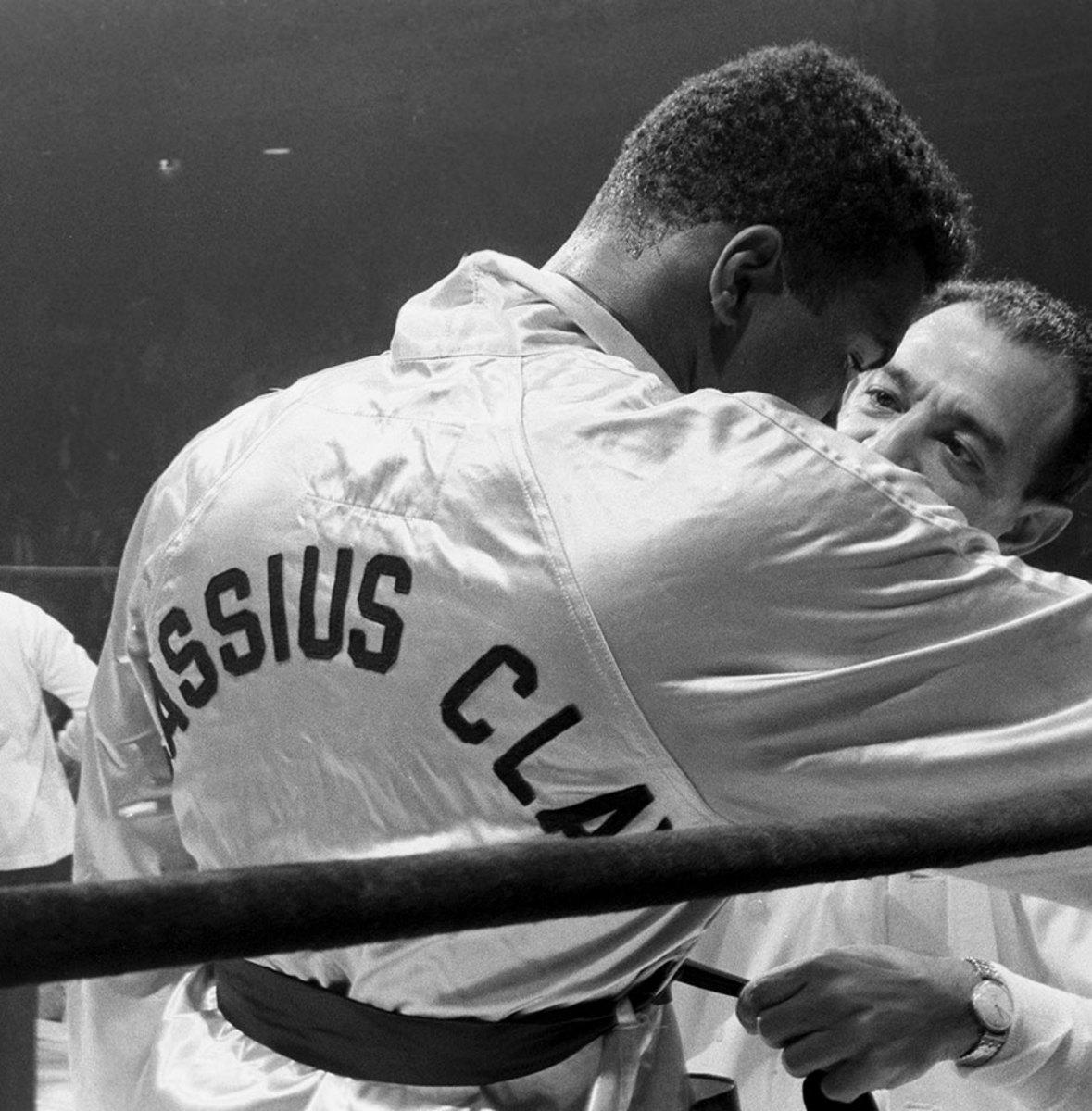
Trainer Angelo Dundee urged his young charge to get serious before the opening bell against Jones. Clay followed instructions and emerged from a tough fight with a unanimous decision victory. Three months later he would stop Henry Cooper and close out 1963 at 19-0.
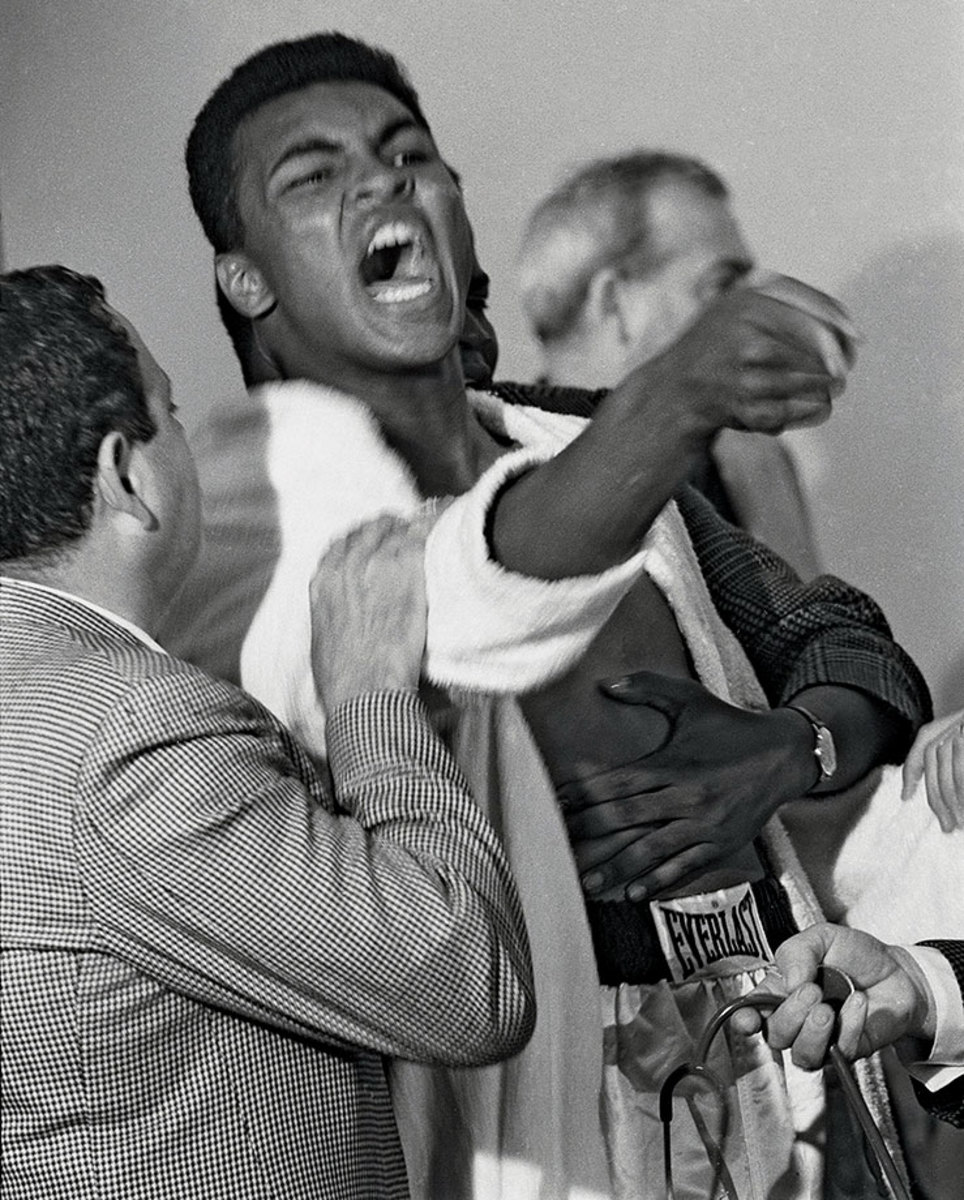
A seemingly hysterical Clay taunted Sonny Liston during the pre-fight physical for their 1964 bout. He had consistently baited the Big Bear during the lead-up to the fight, saying he was going to "use him as a bearskin rug ... after I whup him." The Miami Boxing Commission would fine Clay $2,500 for his outburst at the physical.
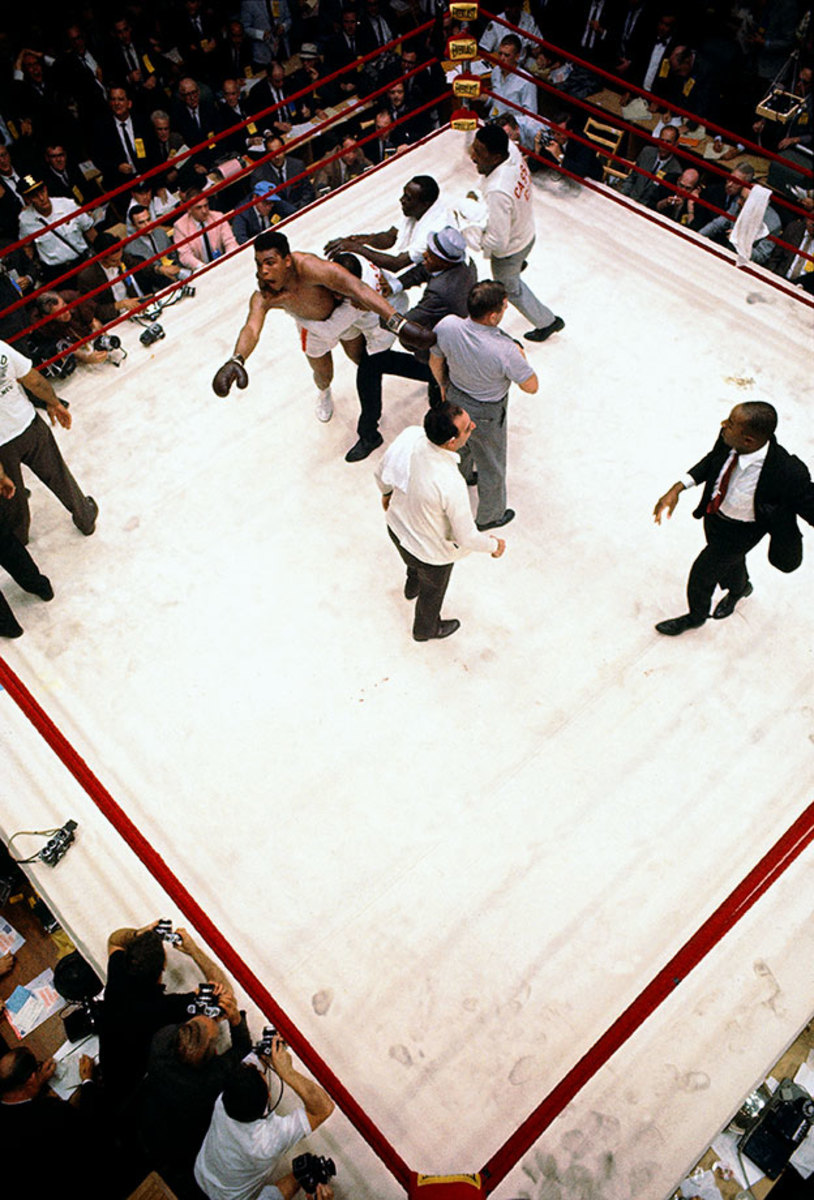
"I shook up the world!" an emotional Clay hollered to ringside reporters after his shocking defeat of Liston. And he did just that, claiming the heavyweight title at age 21 after a clearly beaten Liston, complaining of a shoulder injury, failed to answer the bell for the seventh round.
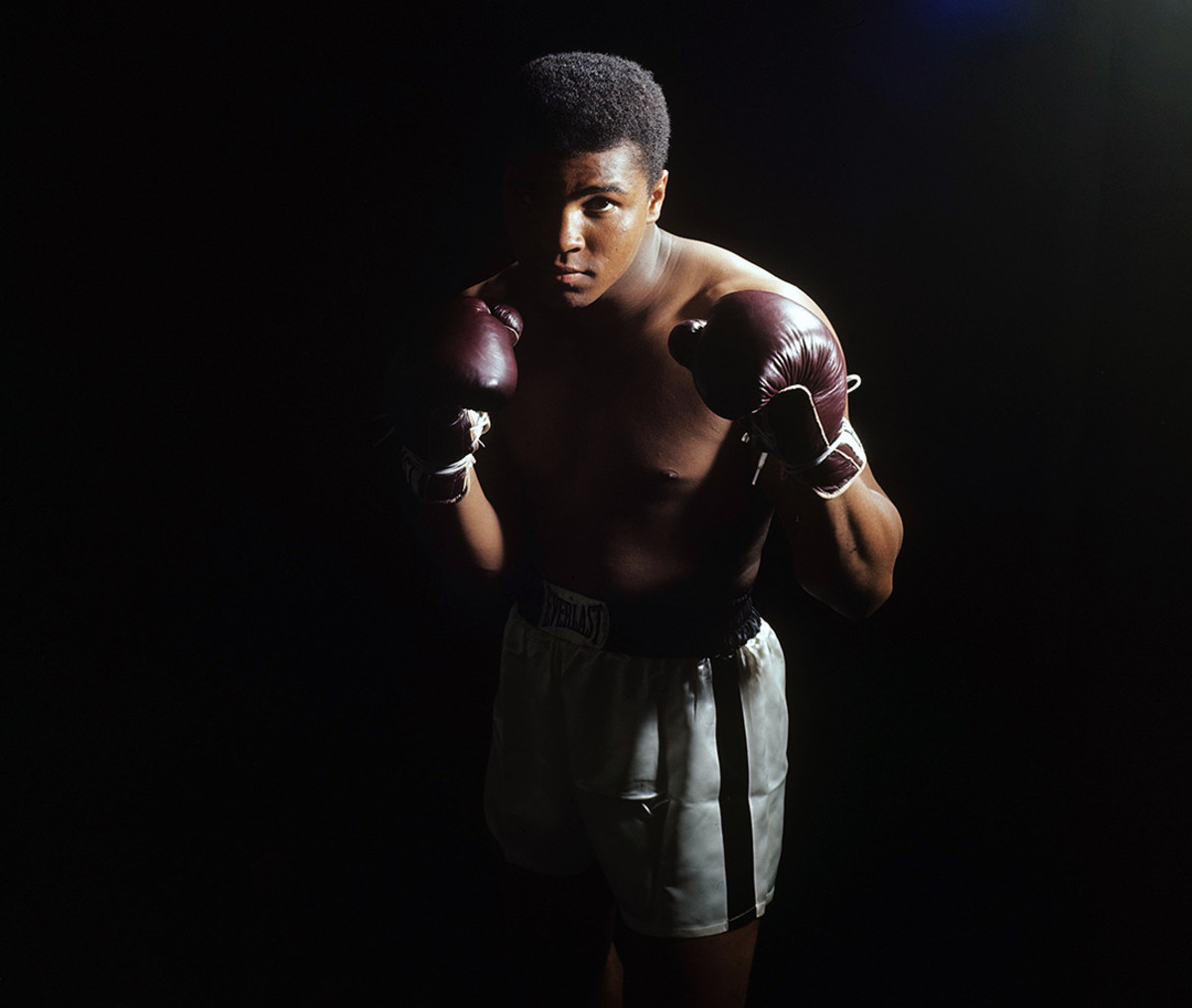
Draped in shadow, the young king — now known as Muhammad Ali — stared down the camera during a photo shoot in April 1965, one month before his rematch against Sonny Liston.
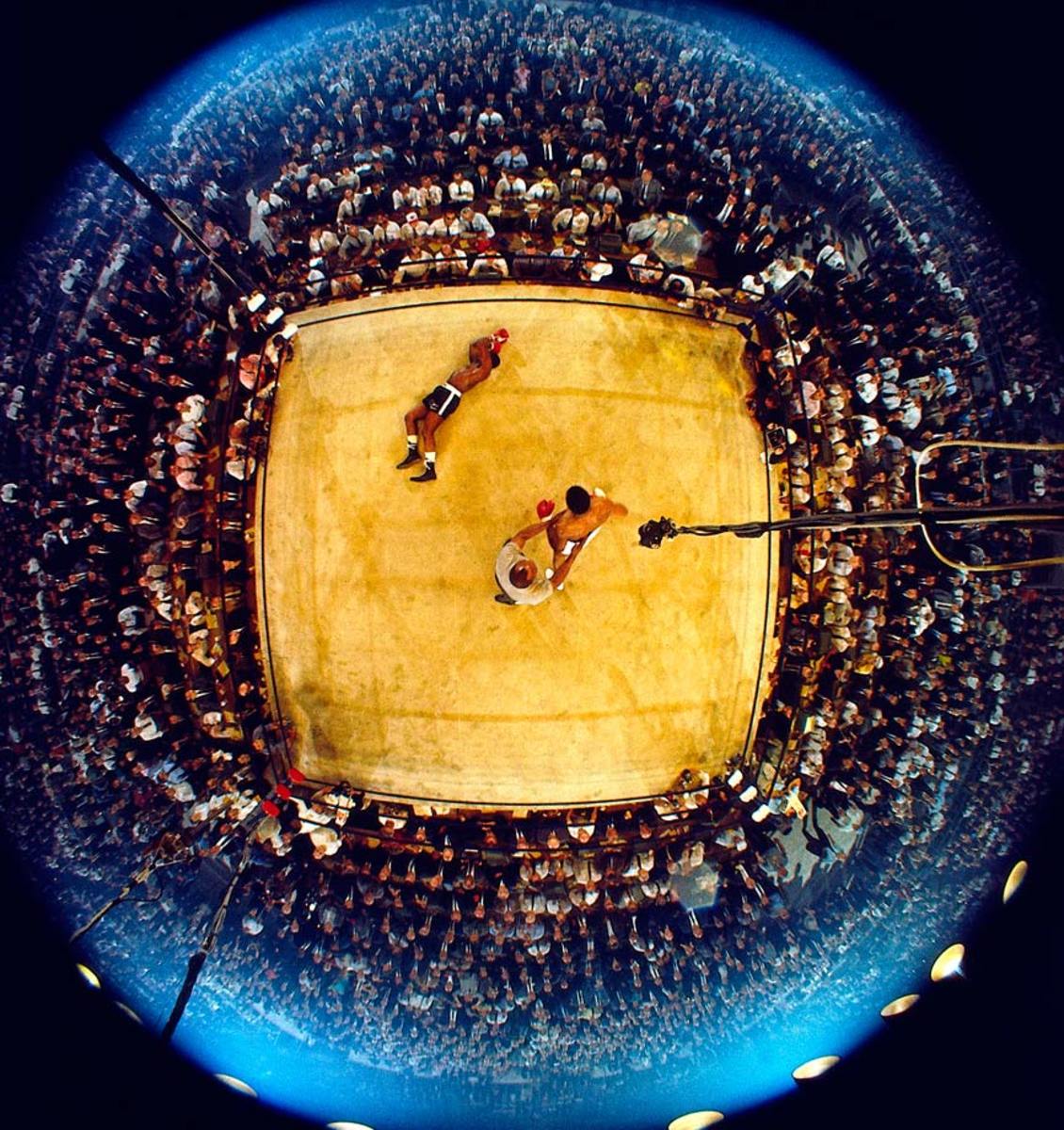
As Liston lingered on the canvas and the referee, former heavyweight champ Jersey Joe Walcott, tried to control Ali, the 2,434 spectators on hand in the Lewiston, Me., hockey arena — a record low for a heavyweight championship fight — tried to make sense of what all that had happened in less than two minutes after the opening bell.
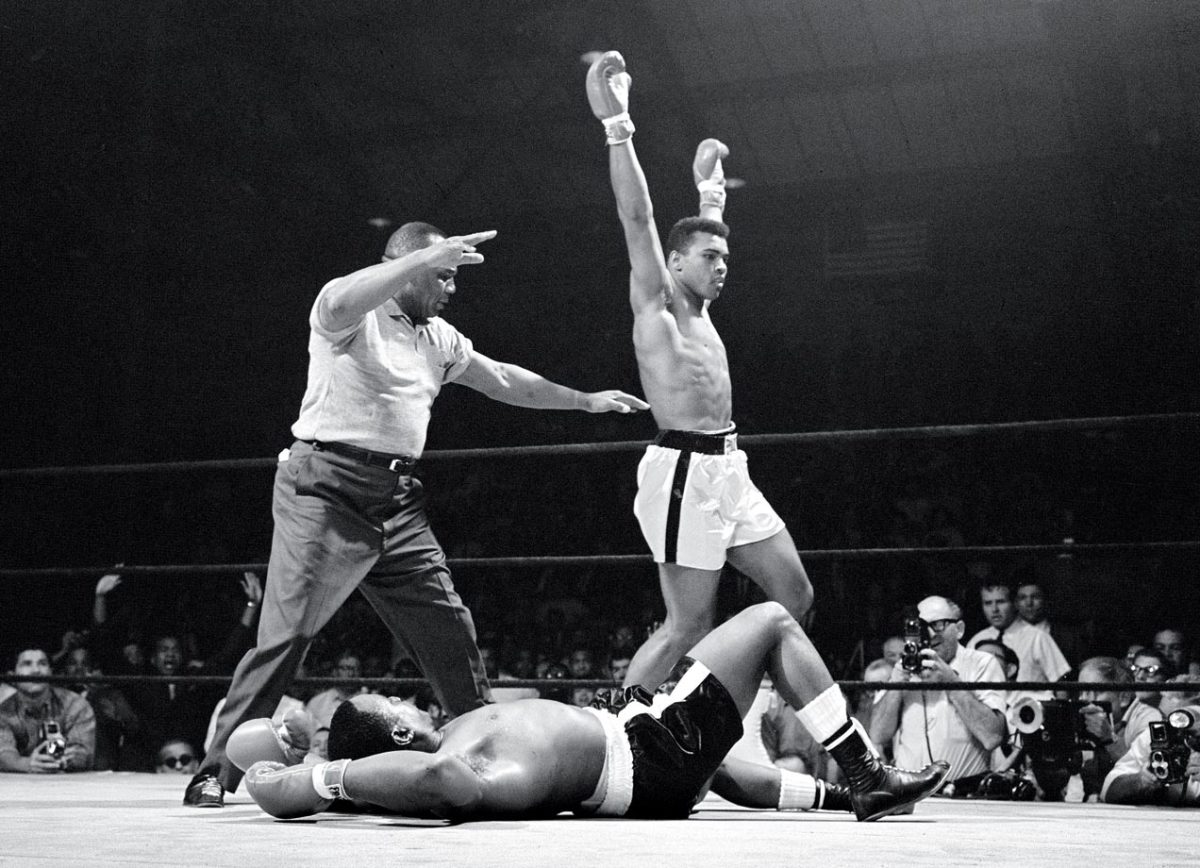
The celebration over Liston continued. In a chaotic ending, Ali was awarded a knockout when Nat Fleischer, publisher of The Ring, informed referee Jersey Joe Walcott from ringside that Liston had been on the canvas for longer than 10 seconds after Ali knocked him down. The bout remains one of the most controversial in boxing history, with many observers insisting that Liston took a dive.
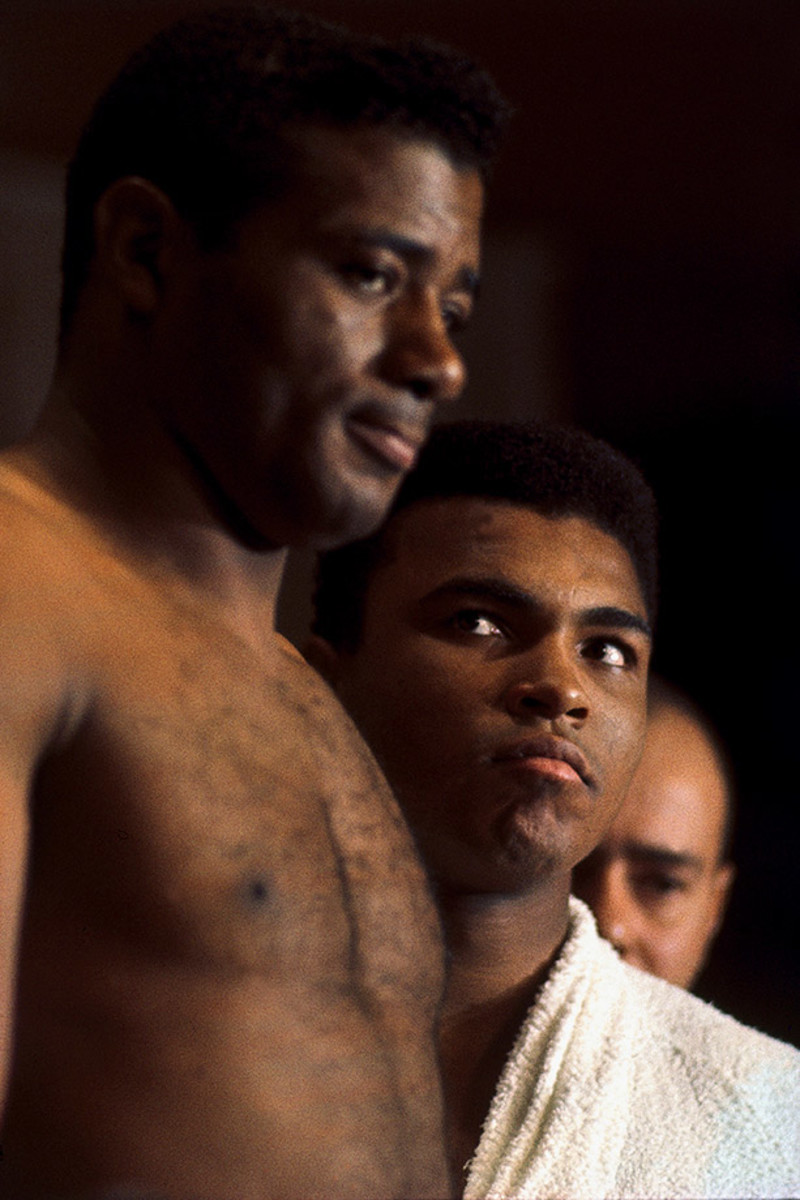
Ali's second title defense came in November 1965, against former two-time heavyweight champion Floyd Patterson. During the build-up to the bout, the normally soft-spoken Patterson earned the new champ's wrath by refusing to call Ali by his Muslim name. At the weigh-in, Ali's glare made it clear that he intended Patterson to pay for the disrespect.
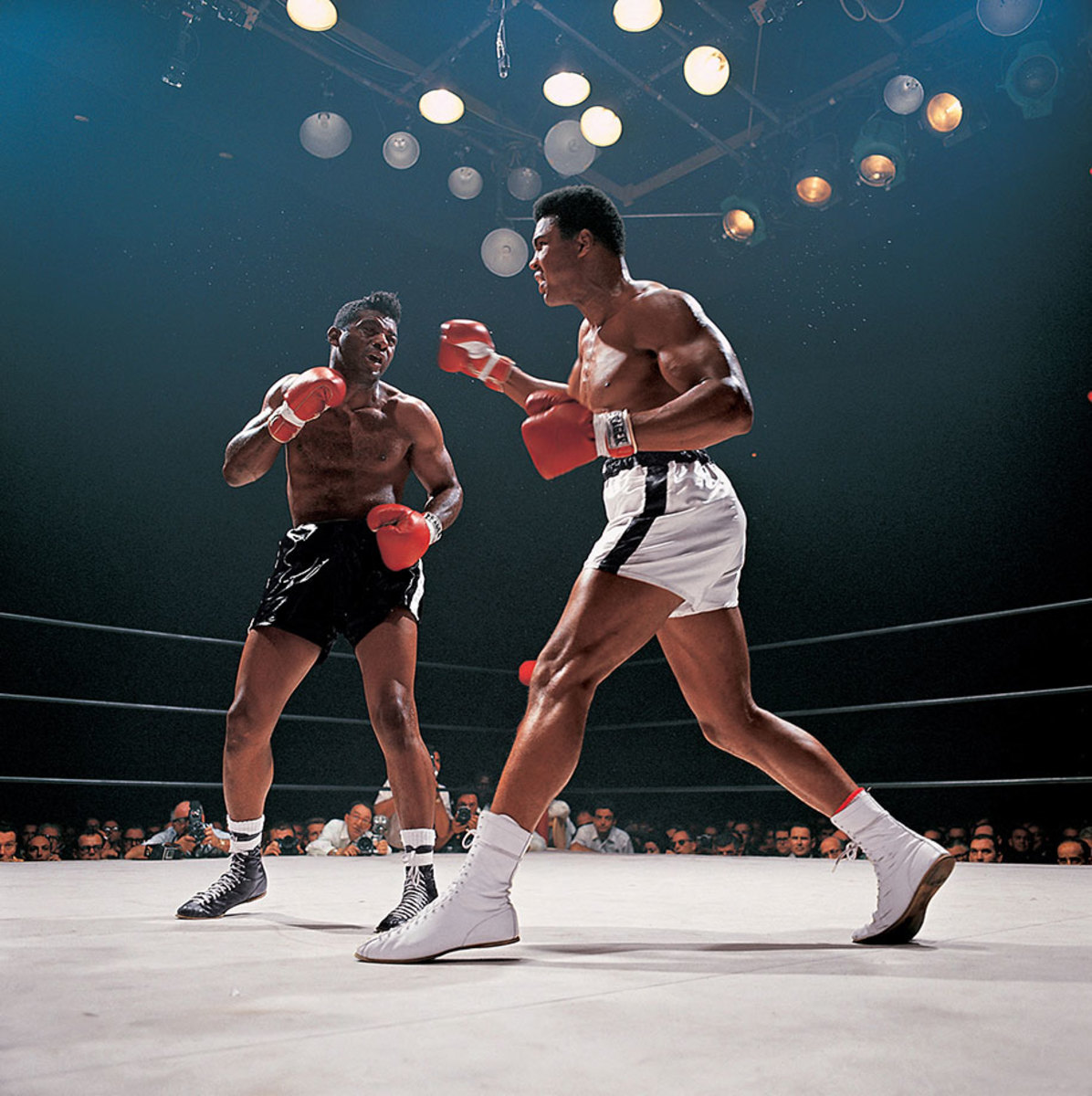
In cruelly efficient performance, Ali punished Patterson — who was hobbled by a painful back injury — seemingly toying with the former champ throughout the bout, hitting him at will and calling, "What's my name?" before finally winning on a 12th-round TKO.
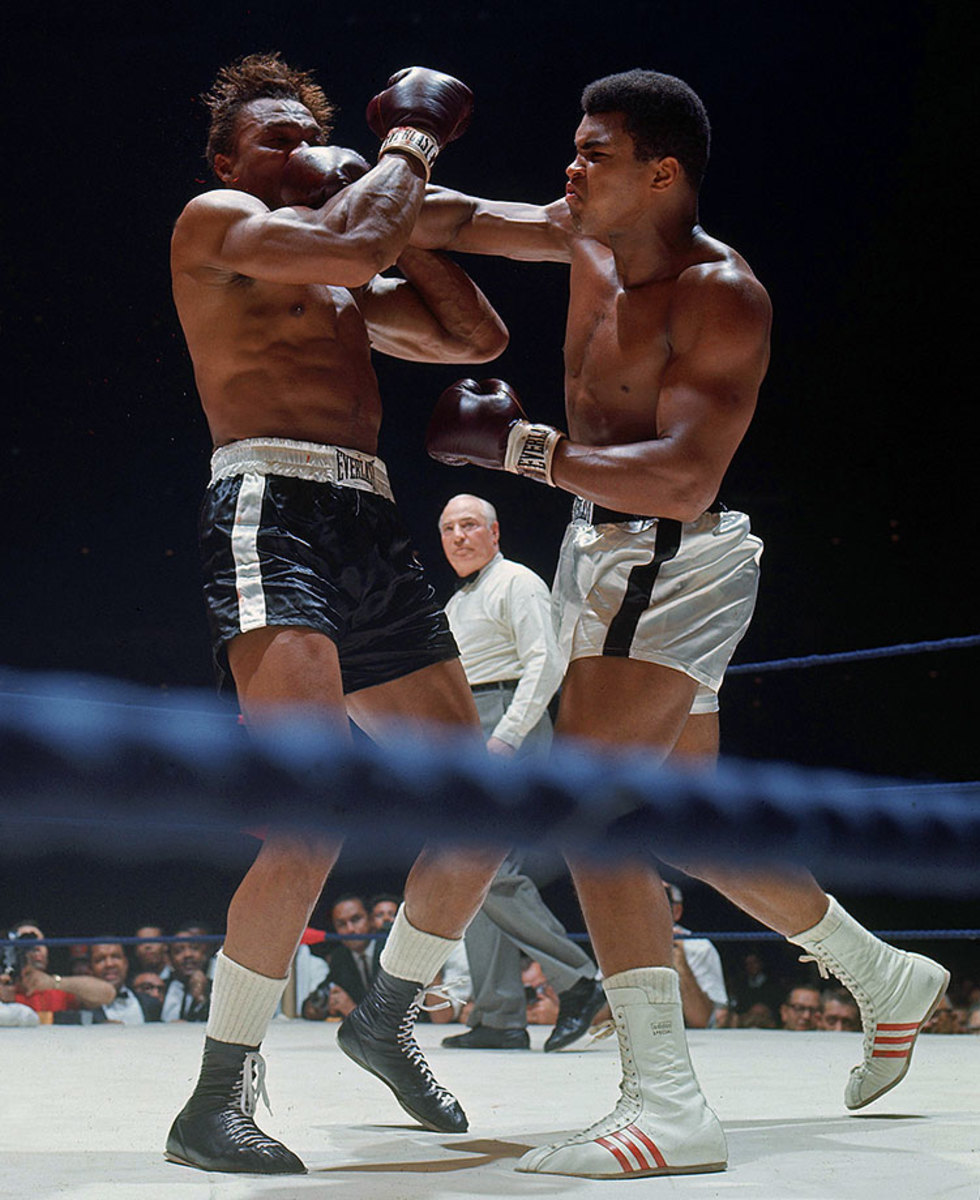
Capping off a five-fight campaign in 1966, Ali faced Cleveland Williams in the Houston Astrodome on Nov. 14. Known as the Big Cat, the heavily-muscled Williams was a power puncher who had racked up 51 knockouts in 71 fights. But he was also 33, barely recovered from a gunshot wound sustained the year before, and up against a young champion very much in his prime. Ali wasted little time in unleashing a withering attack.
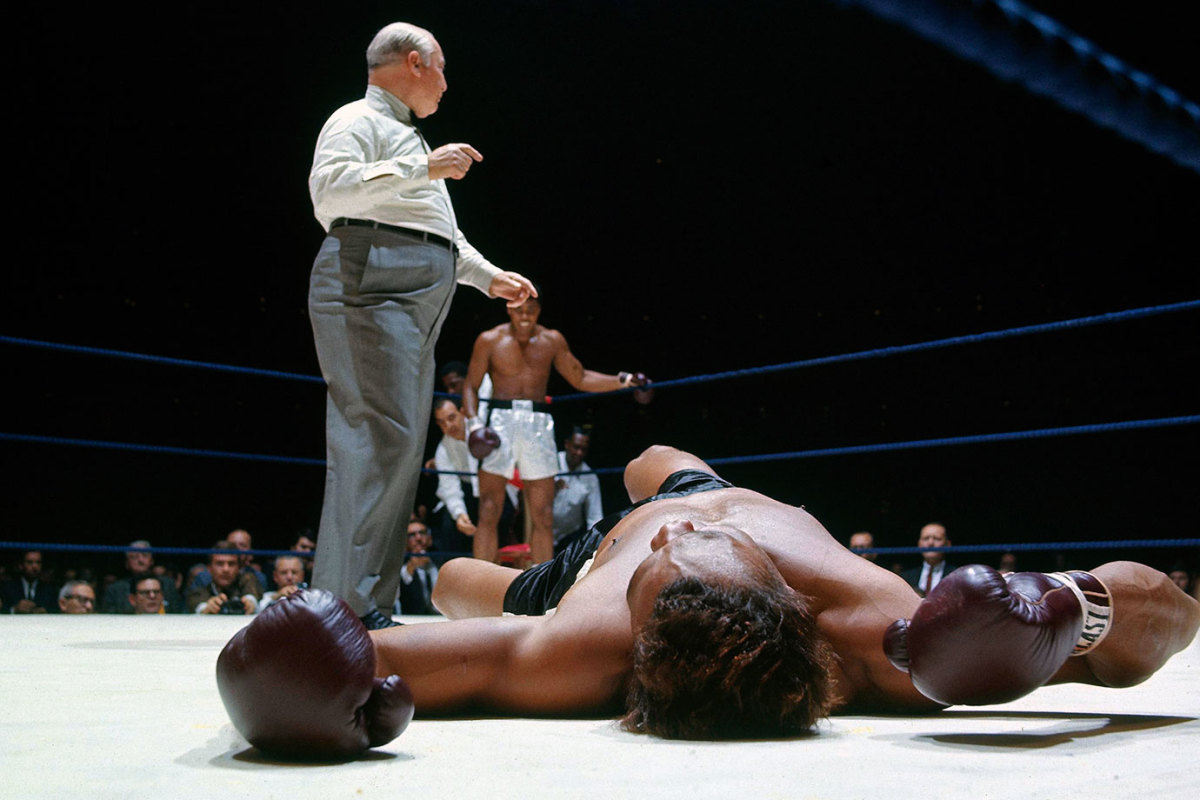
Float and sting: In a display of speed and combination punching unmatched in heavyweight history, Ali overwhelmed Williams from the start. The challenger, here down for the third time in round 2, would be saved by the bell before referee Harry Kessler could count him out, but it would only postpone the inevitable.
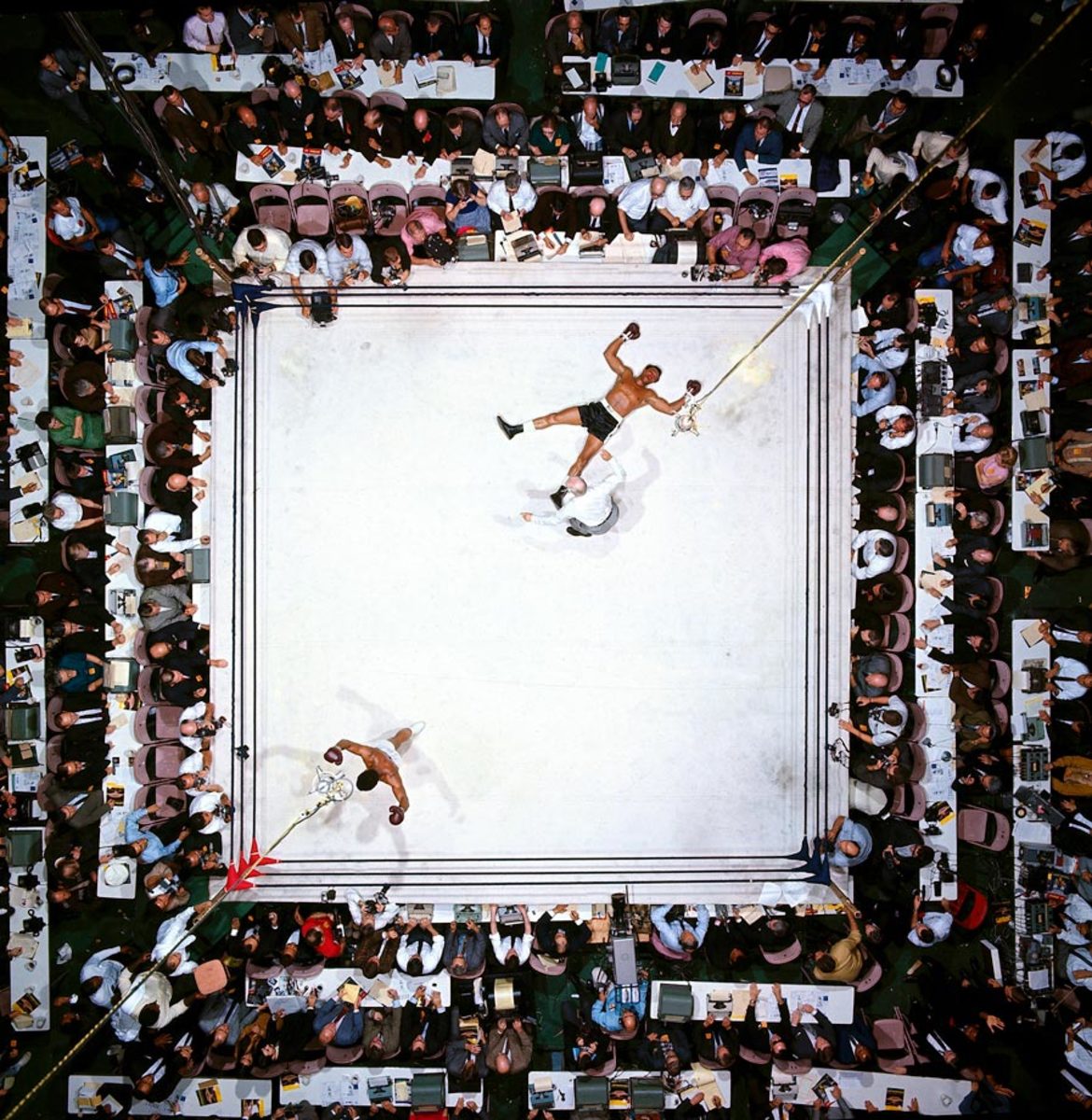
Ali dropped Williams again early in the third round, and Kessler waved the mismatch over at 1:08 of the third.
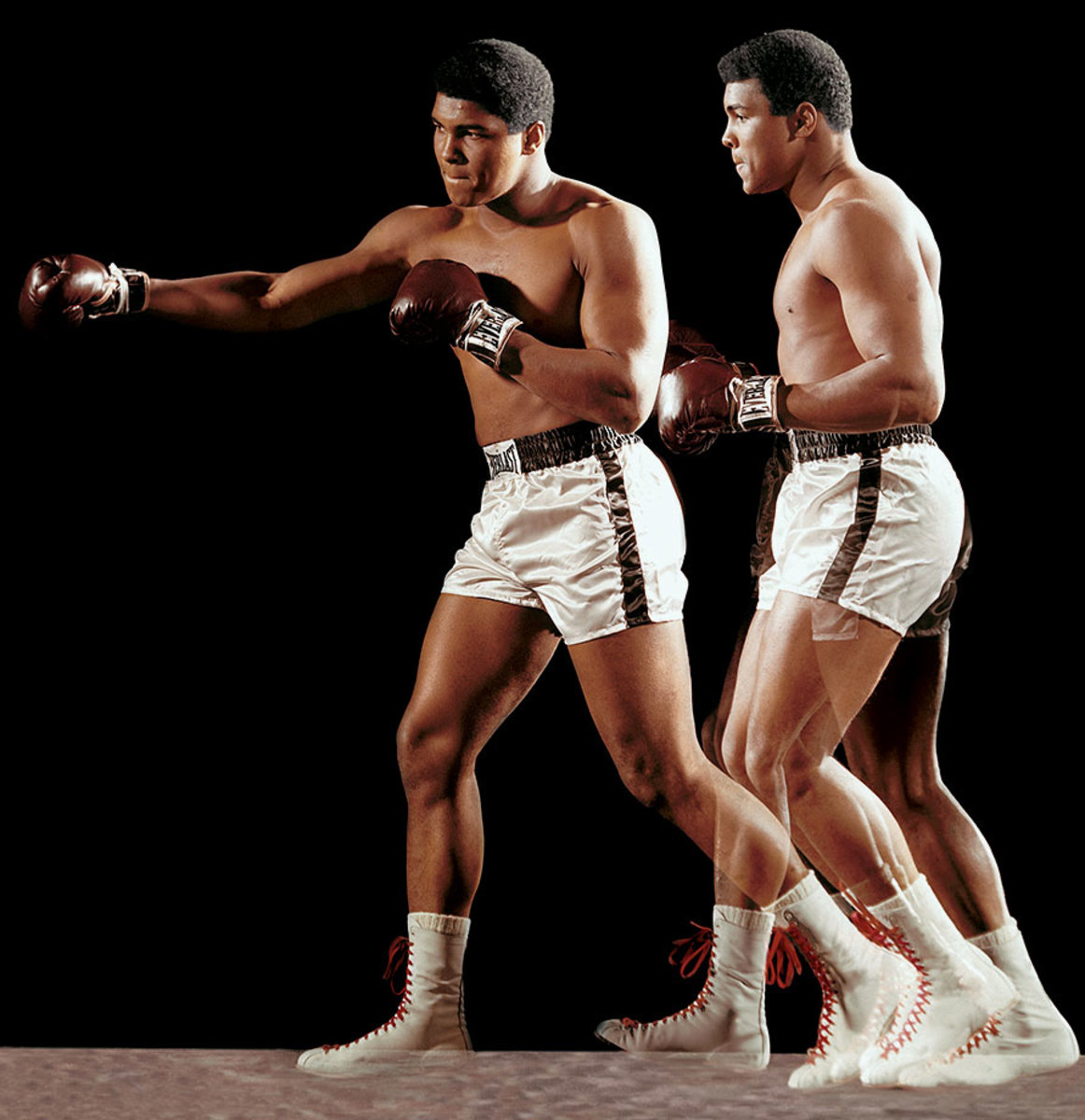
In a multiple-exposure portrait, Ali demonstrates his signature double-clutch shuffle during a photo shoot in December 1966.
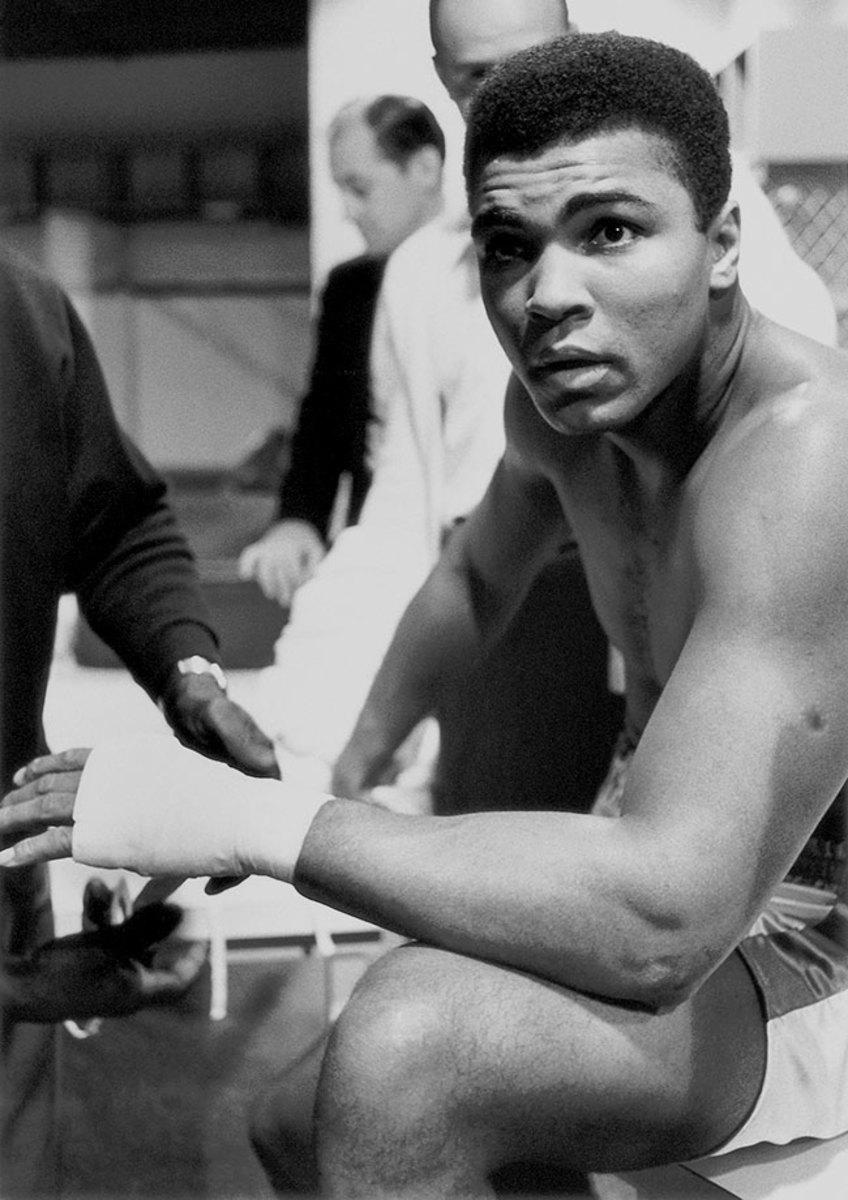
Ali sits in the locker room before his February 1967 fight against Ernie Terrell. Like Patterson before him, Terrell refused to call the champion by his Muslim name. Also like Patterson, he paid a stiff price, as Ali punished Terrell for 15 ugly rounds before winning by unanimous decision.
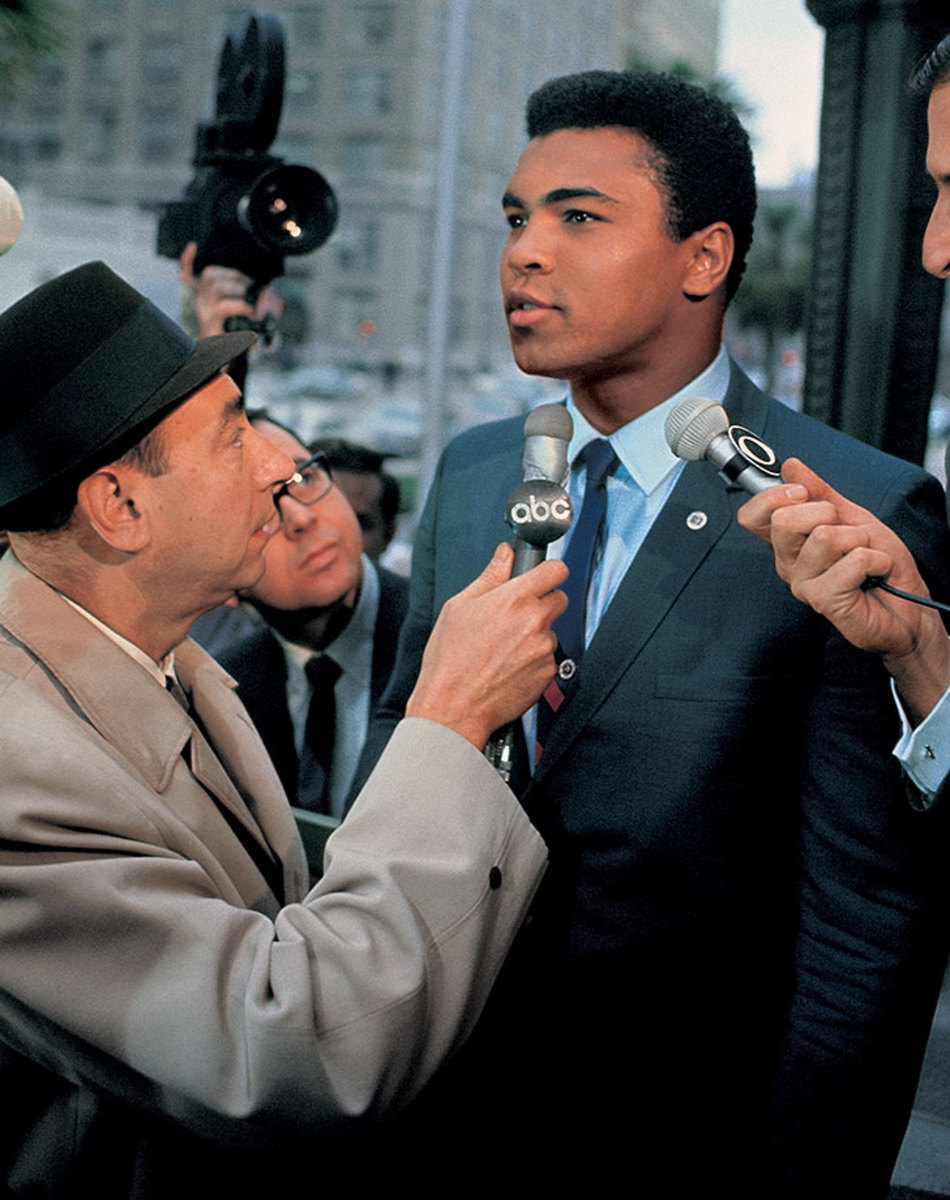
Outside the Armed Forces Examining and Entrance Station in Houston in April 1967, Ali spoke to the press about his refusal to be inducted into military service. Among those on hand was ABC's Howard Cosell, who would be a staunch supporter of the fighter's stance. The decision cost Ali his boxing license and his heavyweight title, and he was sentenced to five years in prison but remained free pending an appeal.
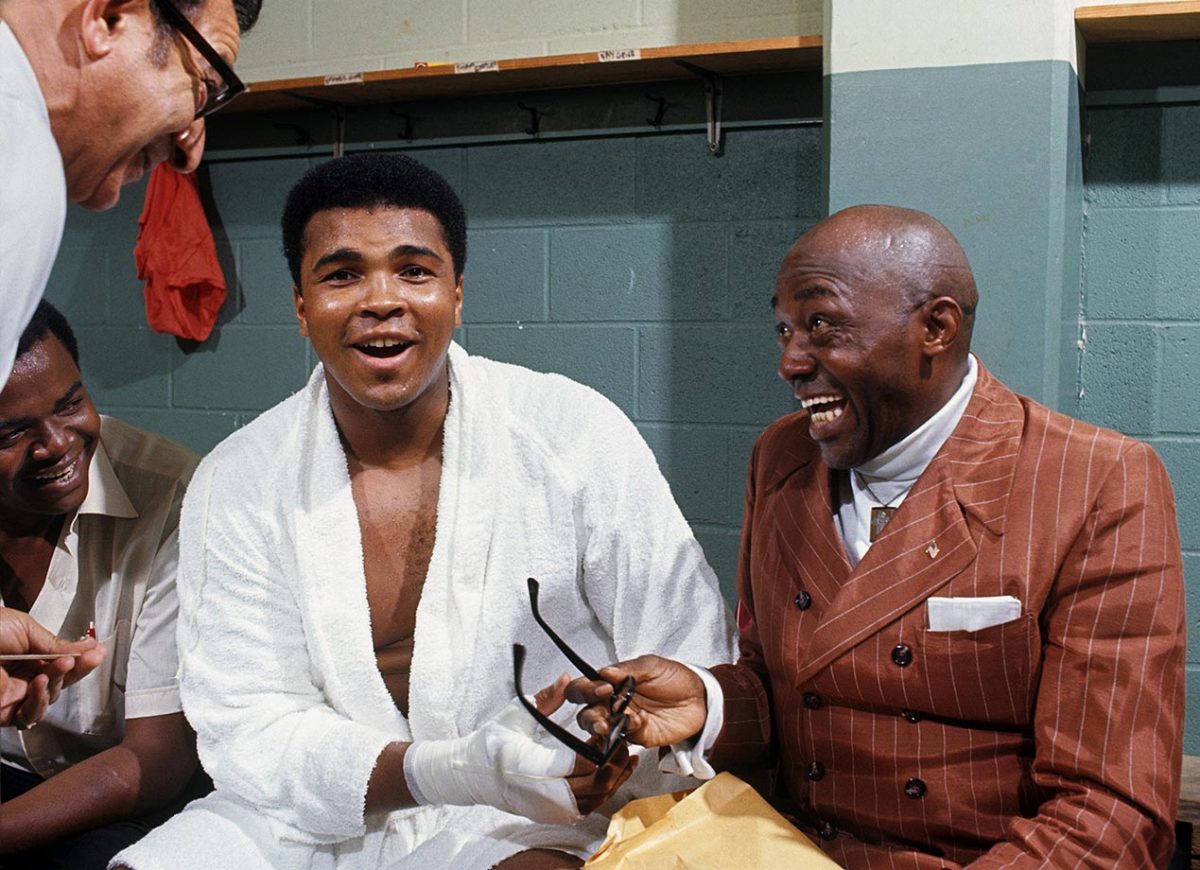
In professional exile for three and a half years because of his draft case, Ali sought to return to boxing in 1970. He began with a night of exhibition bouts at Morehouse College in Atlanta, where before going into the ring, he shared a locker room laugh with actor and comedian Lincoln Perry (right), better known by his stage name of Stepin Fetchit. The friendship between the two black icons would later be examined in an acclaimed play by Will Power, Fetch Clay, Make Man.
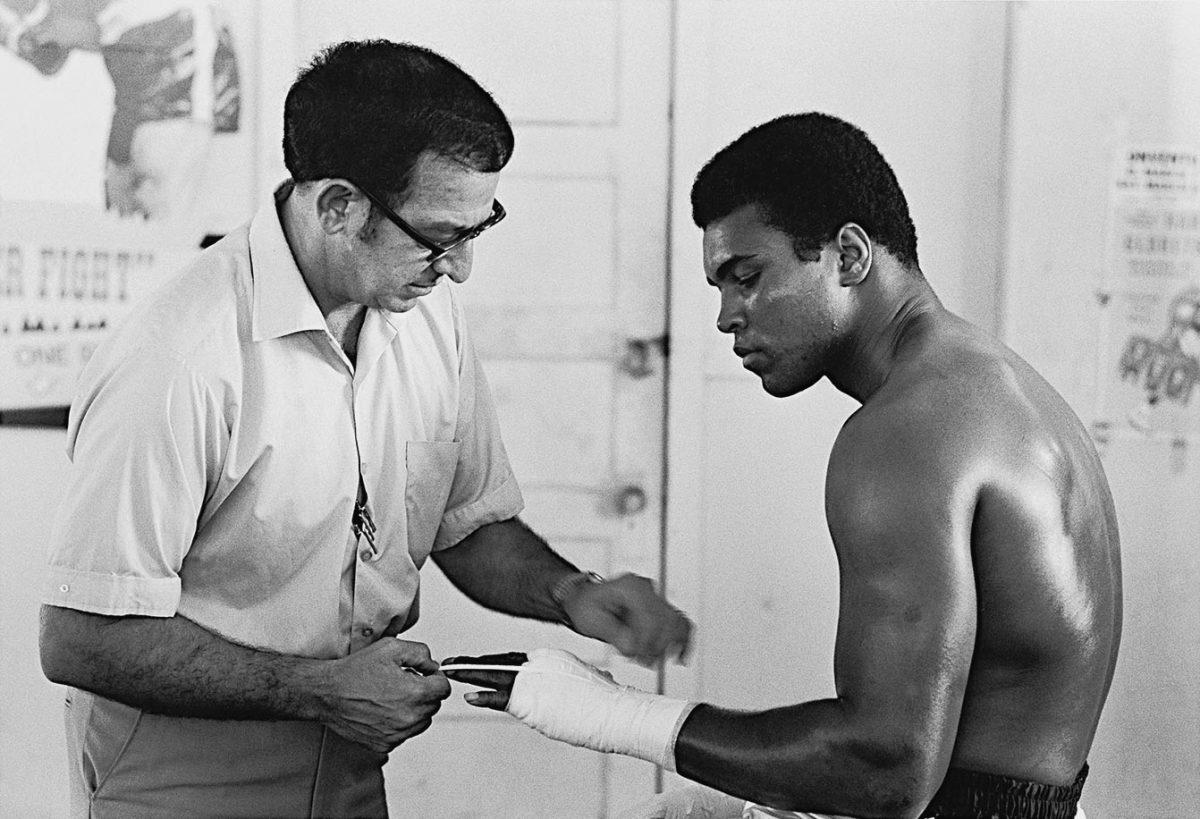
After the Atlanta Athletic Commission at last granted Ali a license, the deposed champion went back into serious training. He was, as ever, in the capable hands of trainer Angelo Dundee, here wrapping boxing's most famous fists at the 5th Street Gym in Miami in October 1970.
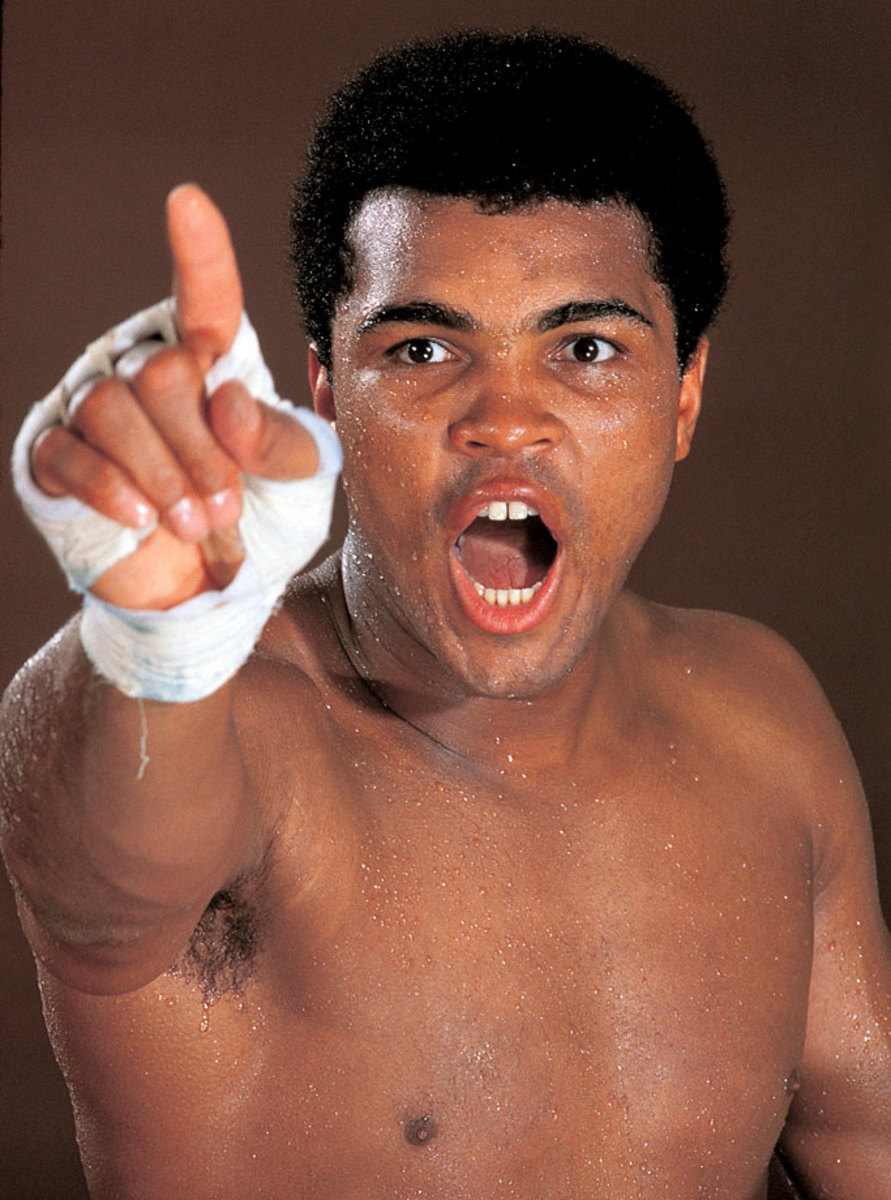
With his return to the ring scheduled for Oct. 26, 1970 in Atlanta, against dangerous contender Jerry Quarry, Ali made it clear to all who would listen that he was on a mission to reclaim the title that had been stripped of him.
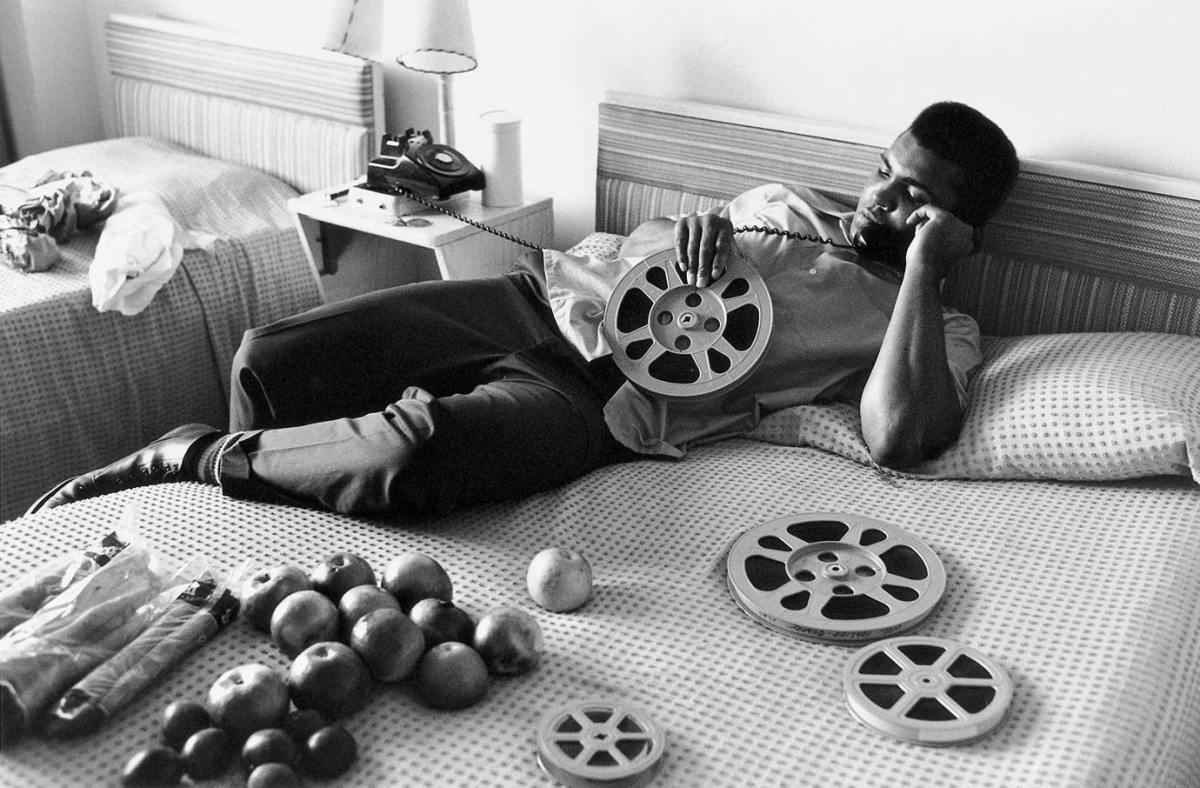
Reel to spiel: For the ever-loquacious Ali, even a rare moment of down time — like this afternoon in 1970 in a Miami hotel room — was a chance to do some talking.
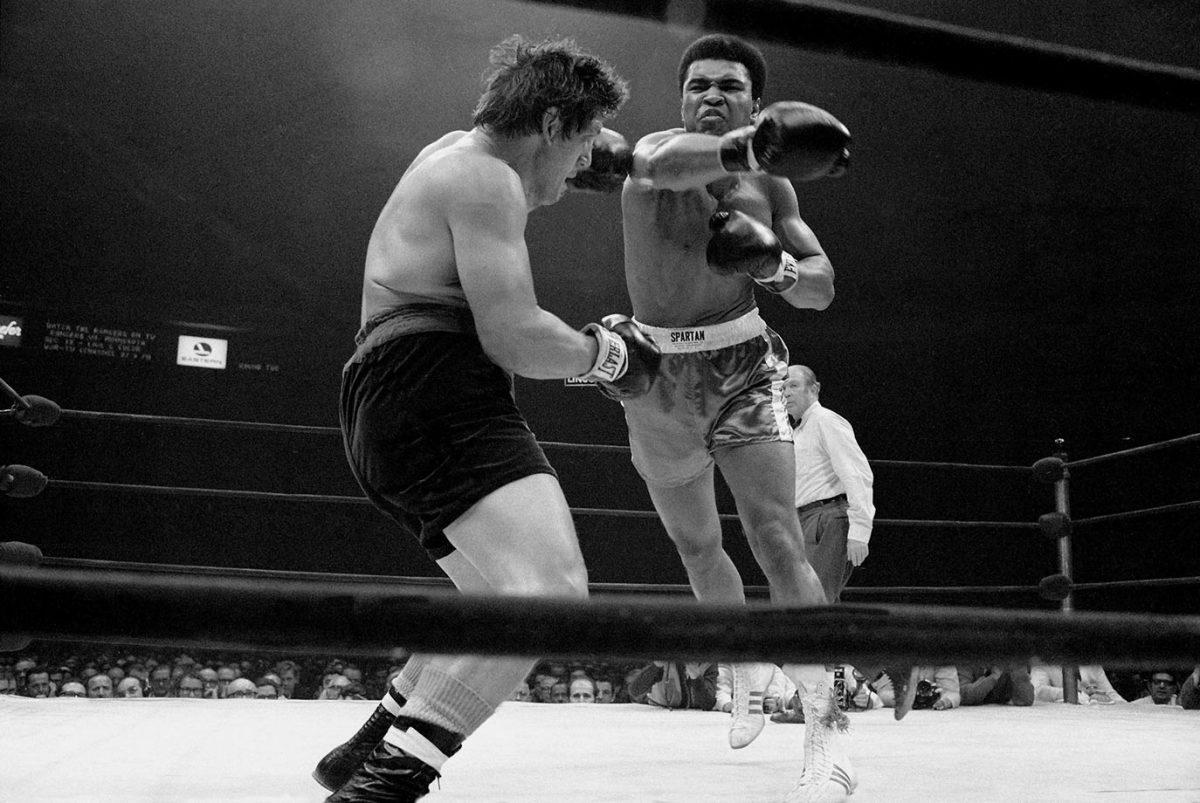
Despite Ali's long layoff, his comeback campaign would include no easy tune-up bouts. He stopped Quarry in three rounds on Oct. 26, 1970, then, just six weeks later — an unthinkably short interlude by today's standards — took on Argentine contender Oscar Bonavena in Madison Square Garden. Here, Ali fires a right at the rugged and awkward Bonavena, who took the fight to the former champion all night.
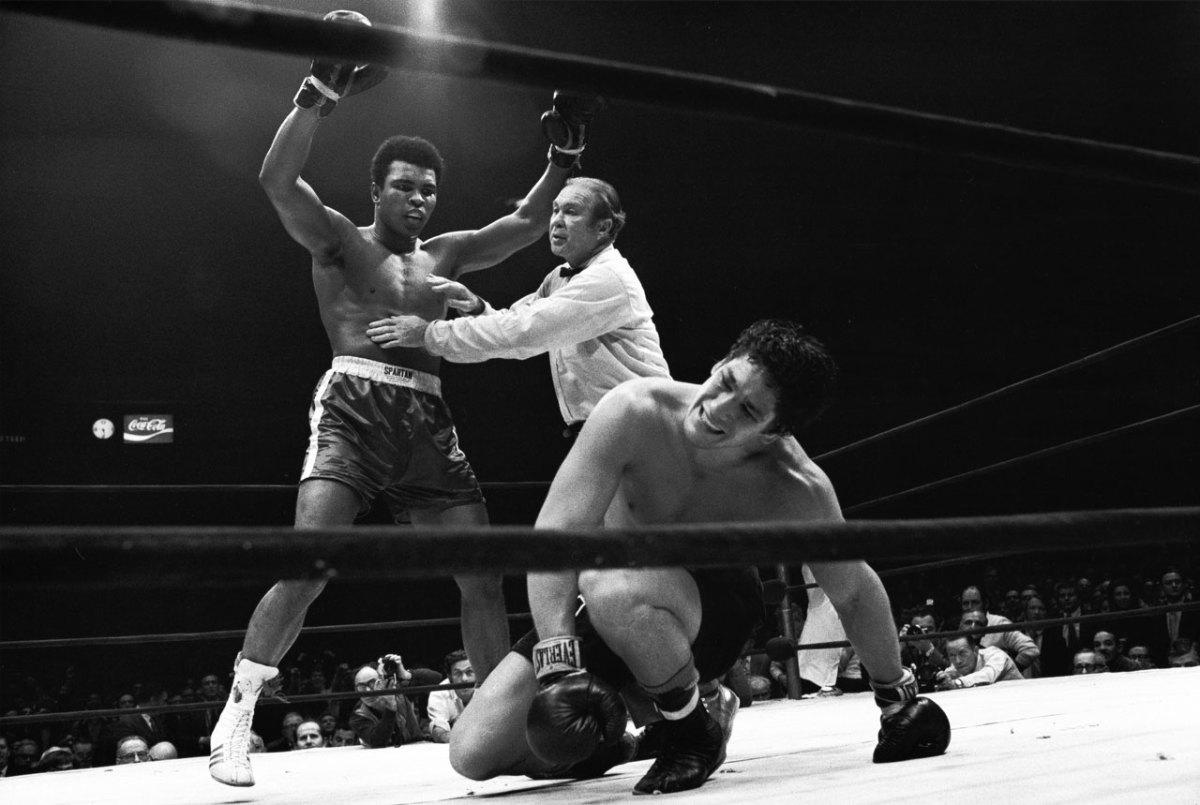
After a long, often sloppy bout, Ali — here being held back by referee Mark Conn — produced one of the most dramatic finishes of his career, dropping Bonavena three times in the 15th and final round to automatically end the fight. The win cleared the way for a showdown with Joe Frazier, the man who had taken the heavyweight title in Ali's absence.
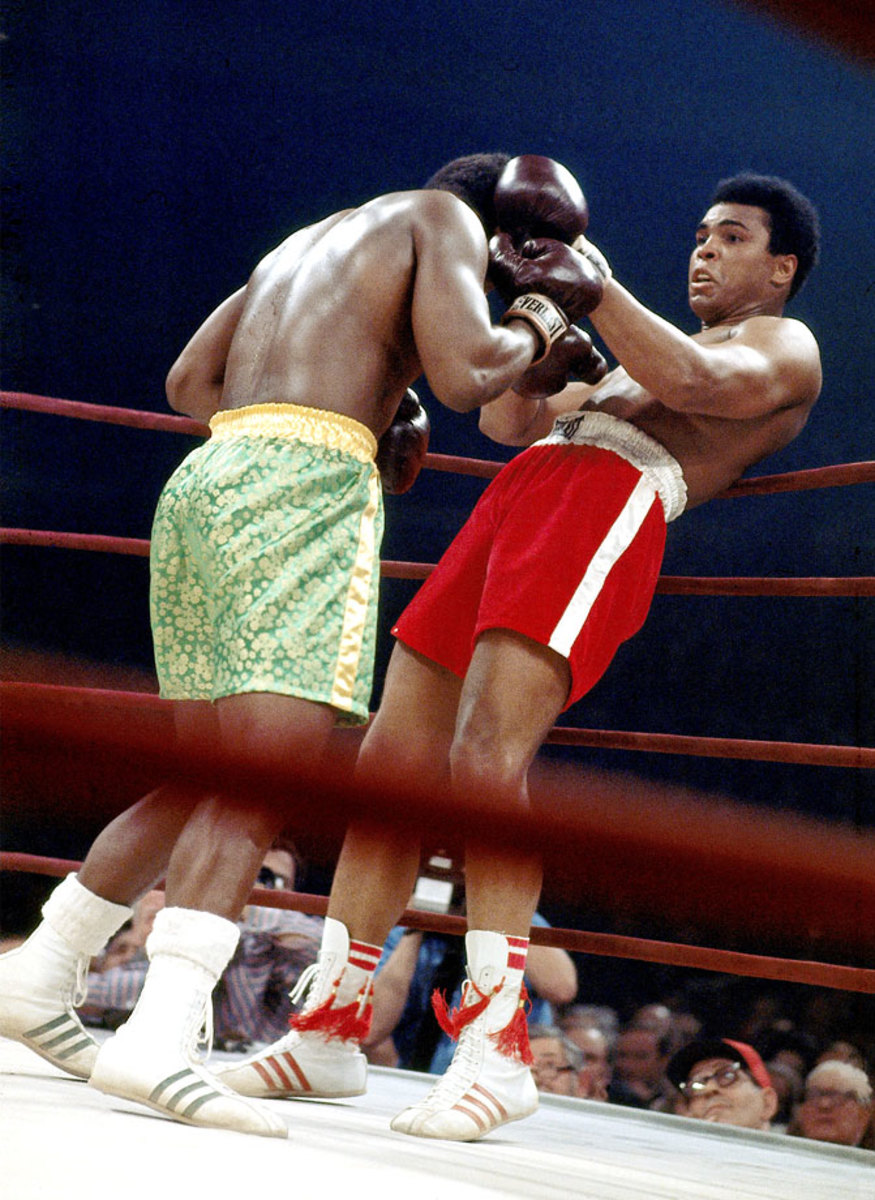
On the night of March 8, 1971, the eyes of the world were on a square patch of white canvas in the center of Madison Square Garden. There, Ali and Joe Frazier met in what was billed at the time simply as The Fight, but has come to be known, justifiably, as the Fight of the Century. For 15 rounds the two undefeated heavyweights battled at a furious pace, with each man sustaining tremendous punishment. In the end Frazier prevailed, dropping Ali in the final round with a tremendous left hook to seal a unanimous decision and hand The Greatest his first loss in 32 professional fights.
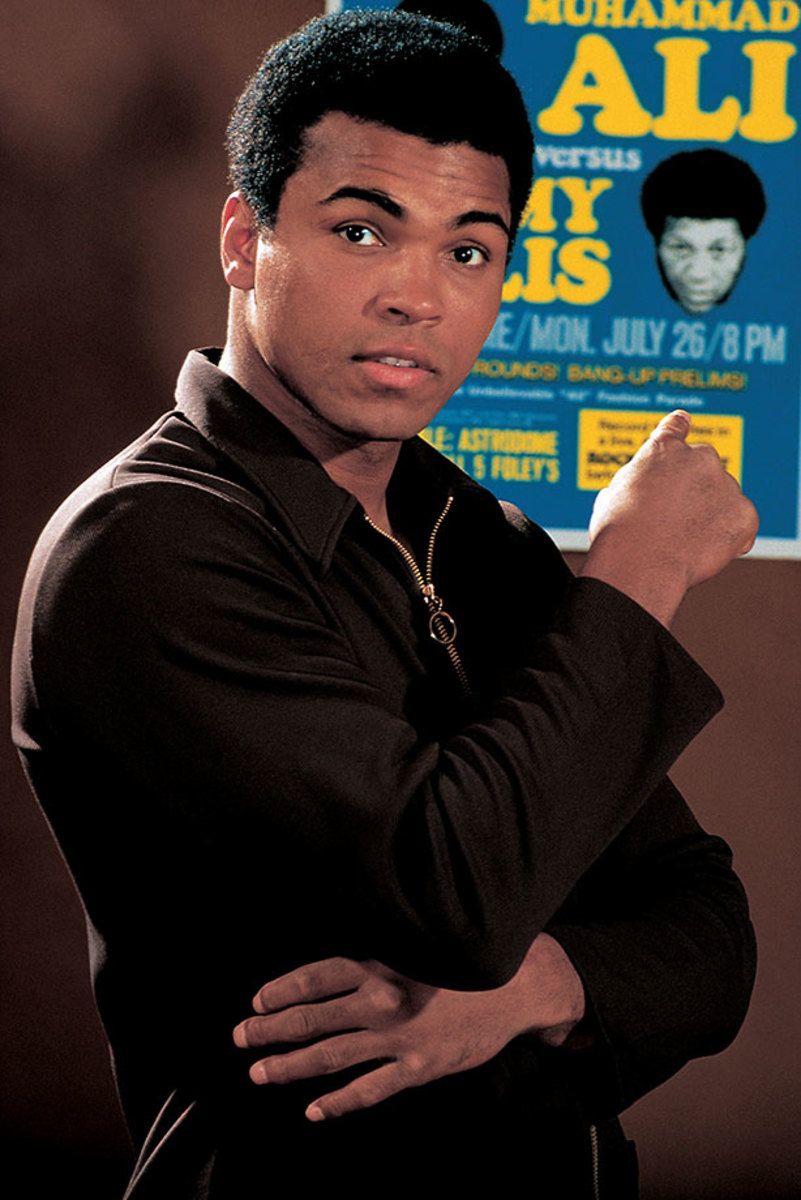
Ali poses with the fight poster for his upcoming fight against Jimmy Ellis during a photo shoot in July 1971. Ellis was an old friend of Ali's — both were trained by Angelo Dundee — and knew his fighting style well from many rounds of sparring.
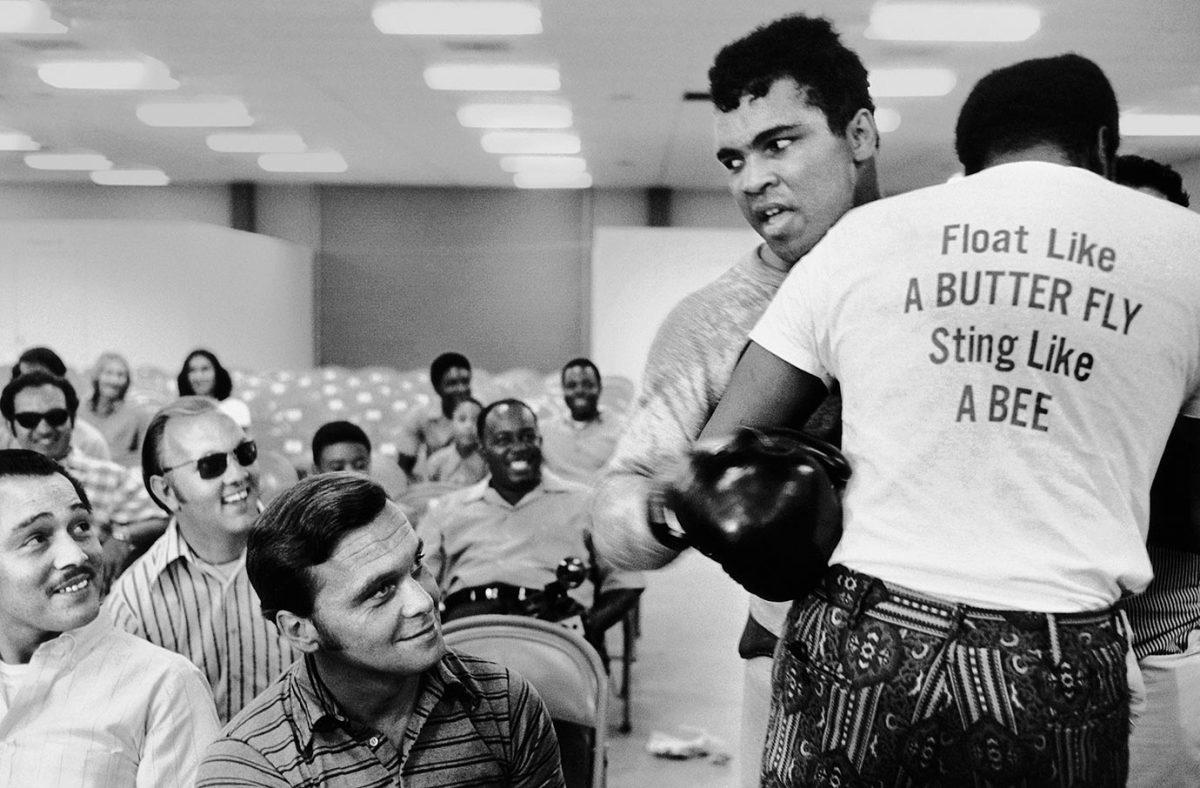
For those sportswriters lucky enough to cover Ali on a regular basis, each day brought surprises and, more often than not, plenty of laughs. of Trainer Drew Bundini Brown helps Ali train for his fight against Ellis. Ali won the bout by technical knockout in the 12th round to claim the vacant NABF heavyweight title.
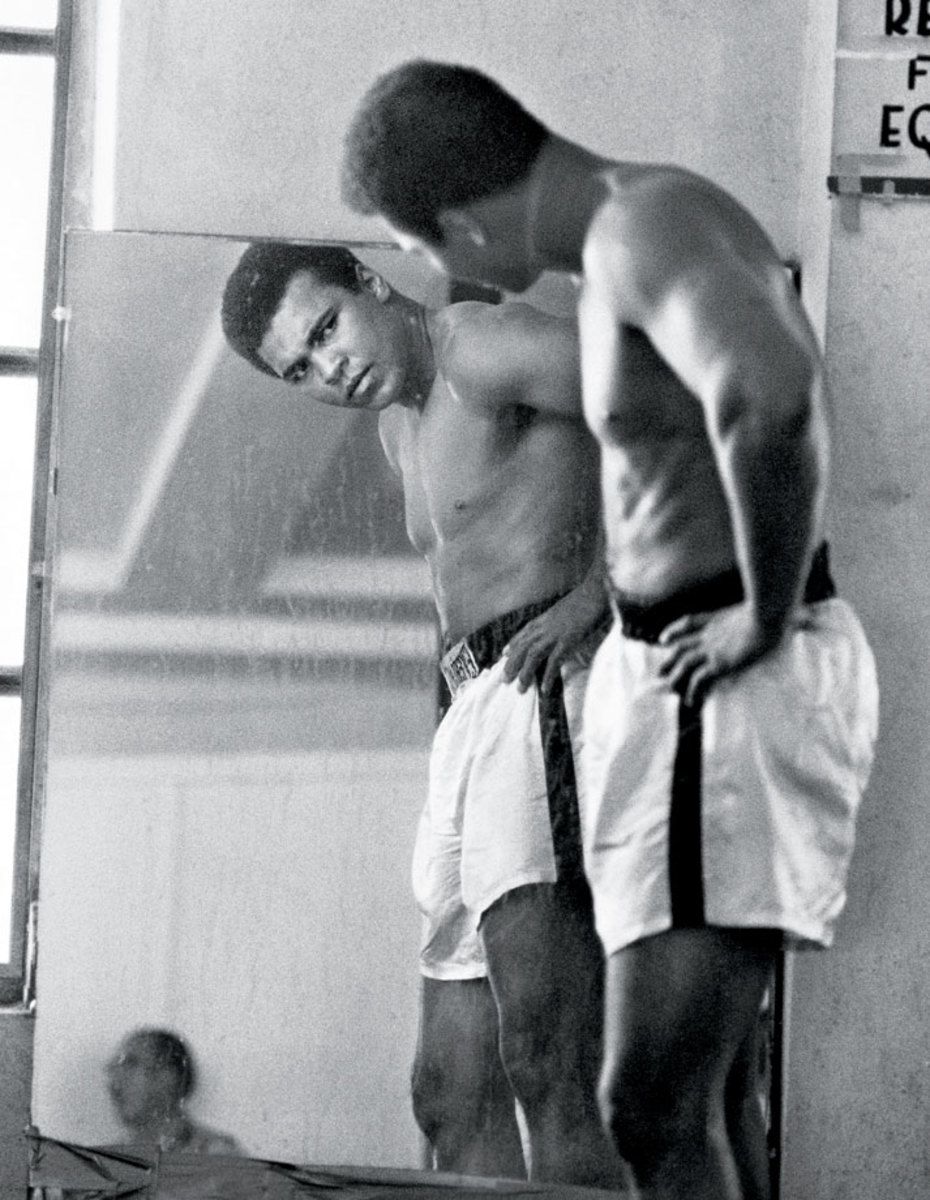
The man in the mirror stares back as Ali examines himself while training for a fight in 1972. He won all six of his fights that year.

The Louisville Lip stands next to George Foreman before Ali's fight versus Jerry Quarry in June 1972. Ali won by technical knockout in the seventh round. Foreman at the time was 36-0. Ali would not get his shot against Foreman for more than two years.
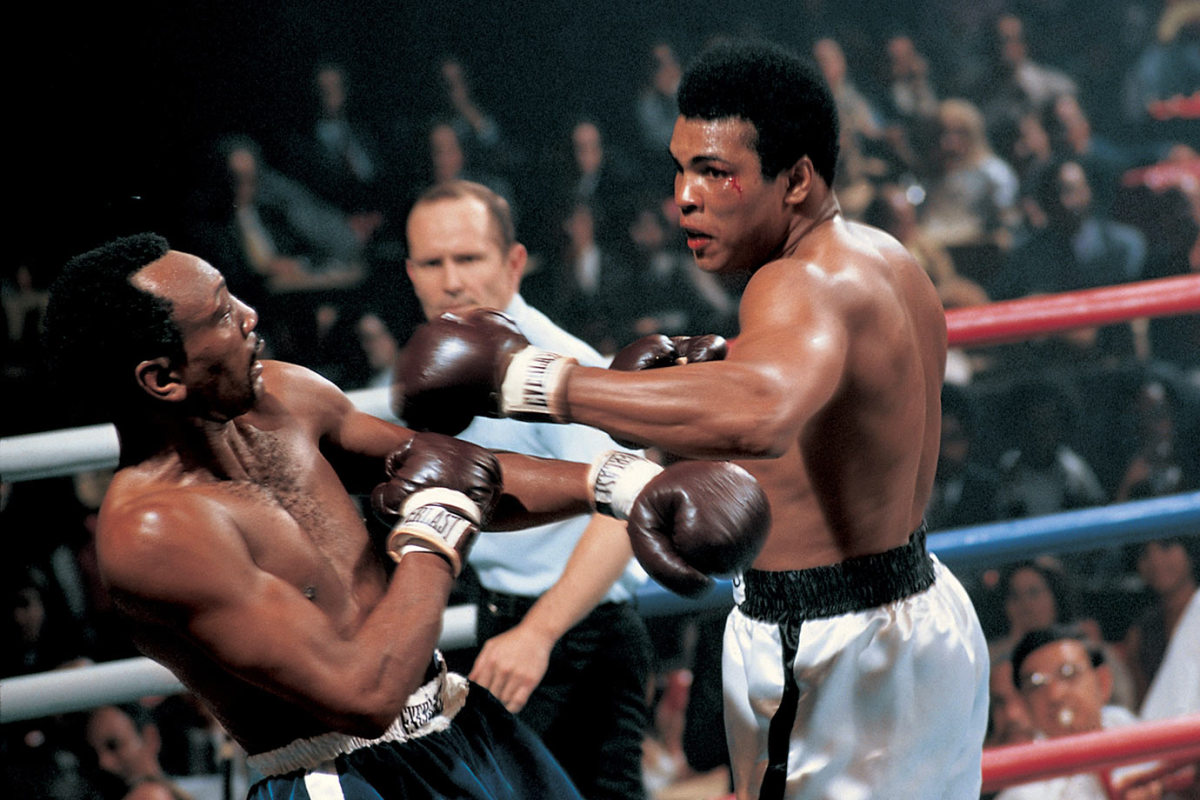
Ali throws a left hook at Bob Foster in their 1972 fight at Stateline, Nev. Although Ali knocked Foster out, Foster did leave his mark: a cut above Ali's left eye, his first as a professional.
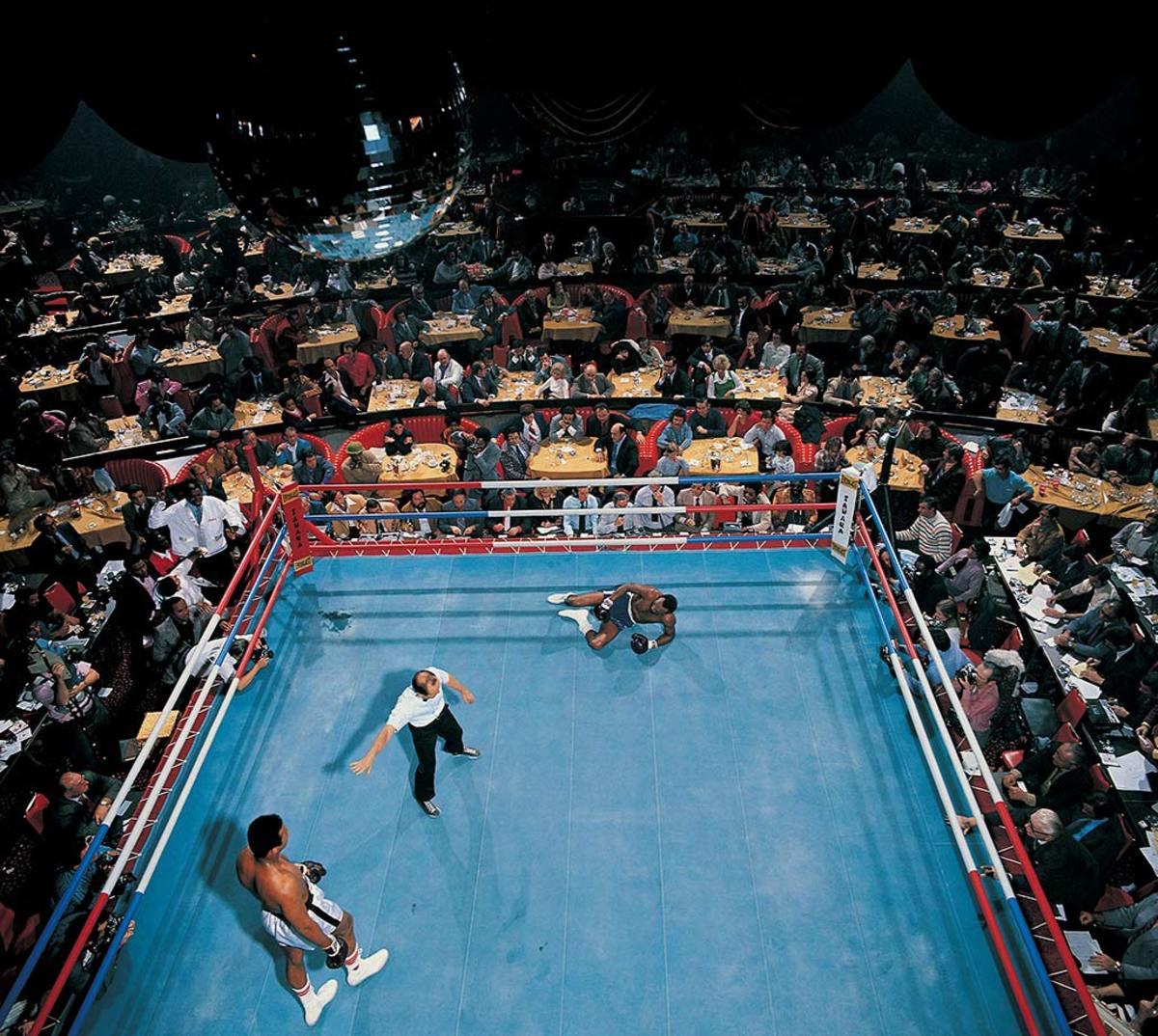
Foster lies on the canvas after getting knocked down by Ali. Ali knocked Foster down four times in the fifth round and twice more in the seventh round before he was finally counted out after Ali knocked him down again in the eighth round.
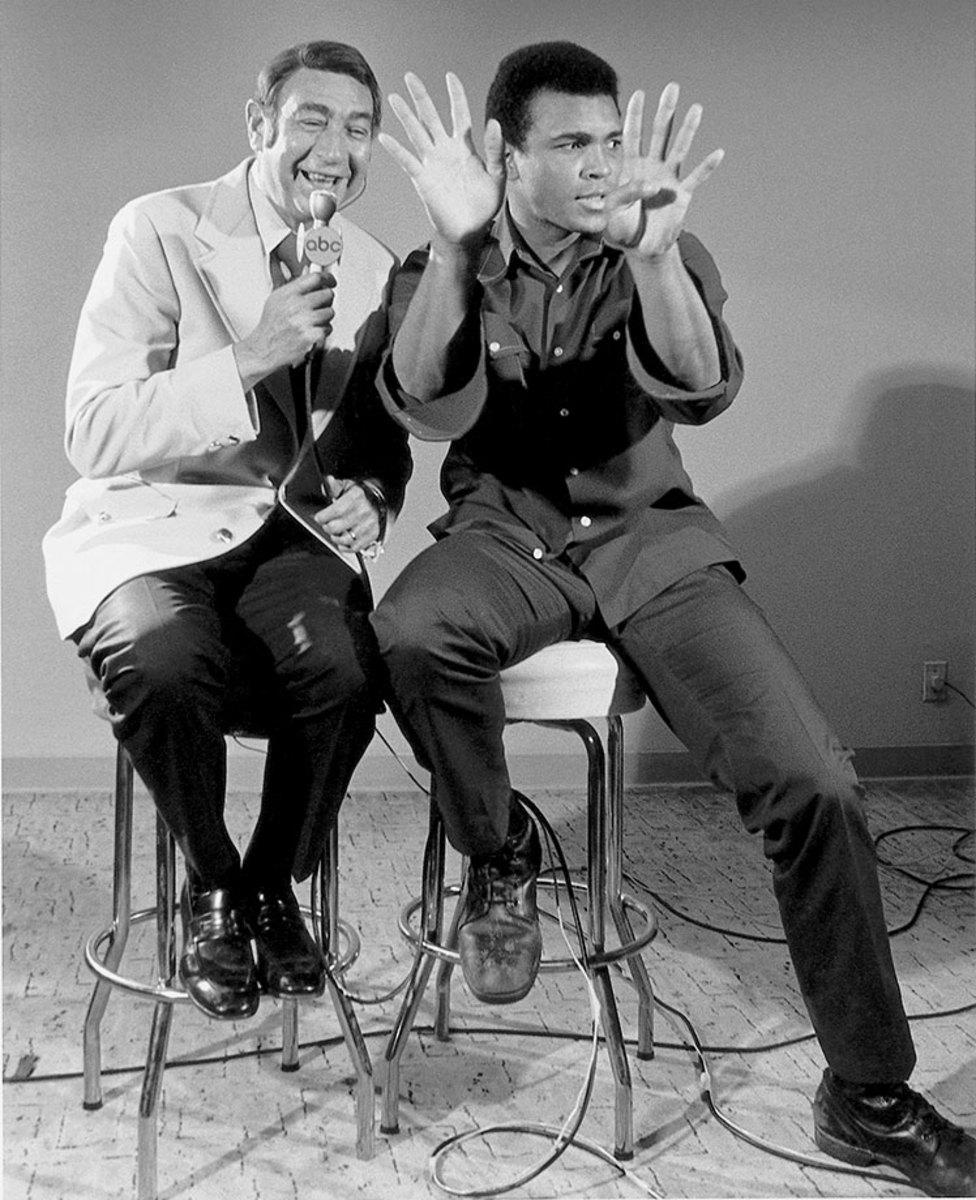
Ali sits with sportscaster Howard Cosell before his fight with Joe Bugner in February 1973. Although unable to knock Bugner out, Ali won comfortably by unanimous decision.
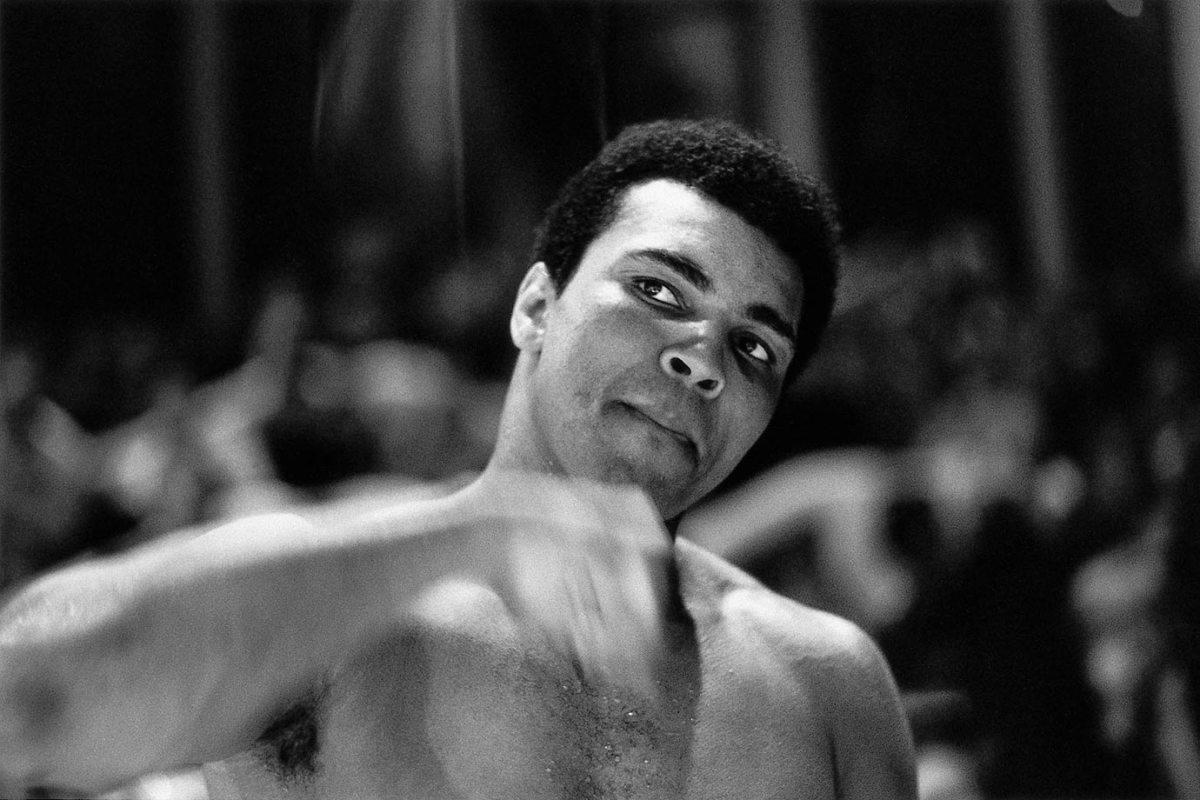
Ali hits a speed bag while warming up for his bout with Bugner in Las Vegas. Ali prepared ferociously for the fight, training 67 rounds the week leading up to the fight, including six rounds the day before the fight.
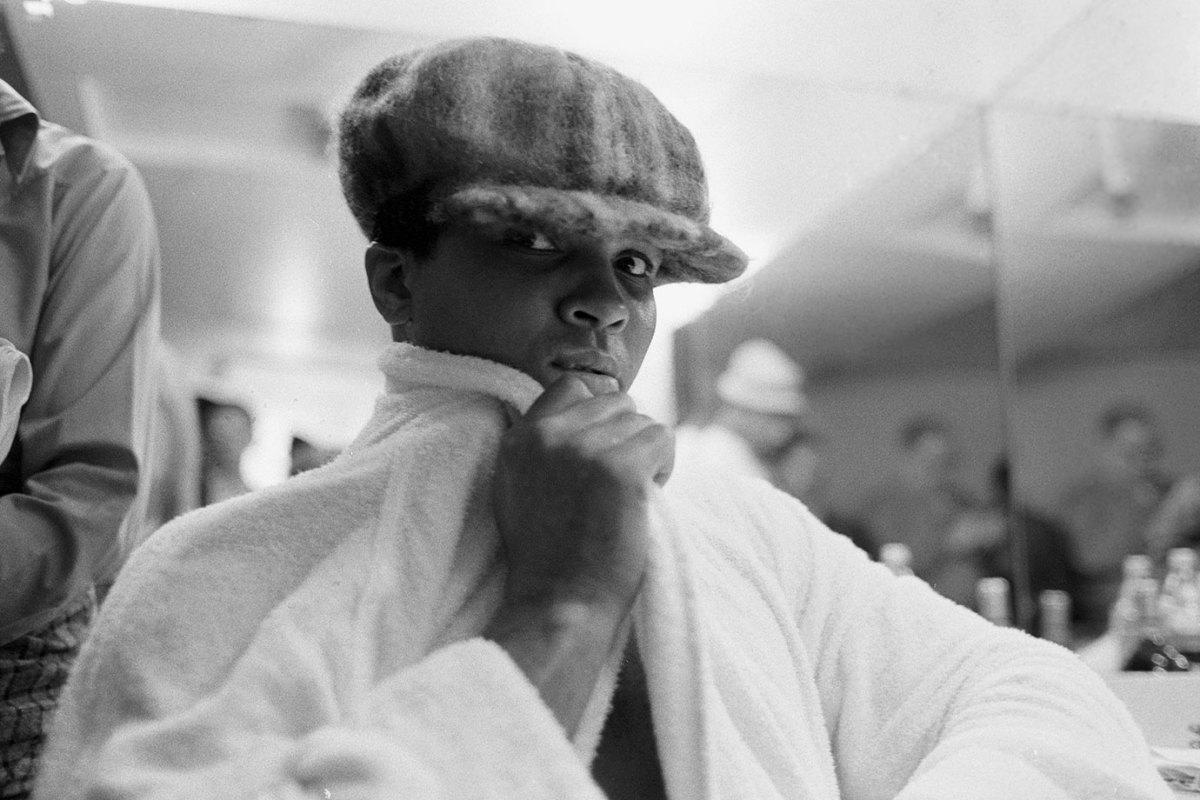
In a lighter pre-fight moment, Ali poses for a portrait wearing a hat in his dressing room before the match with Bugner.
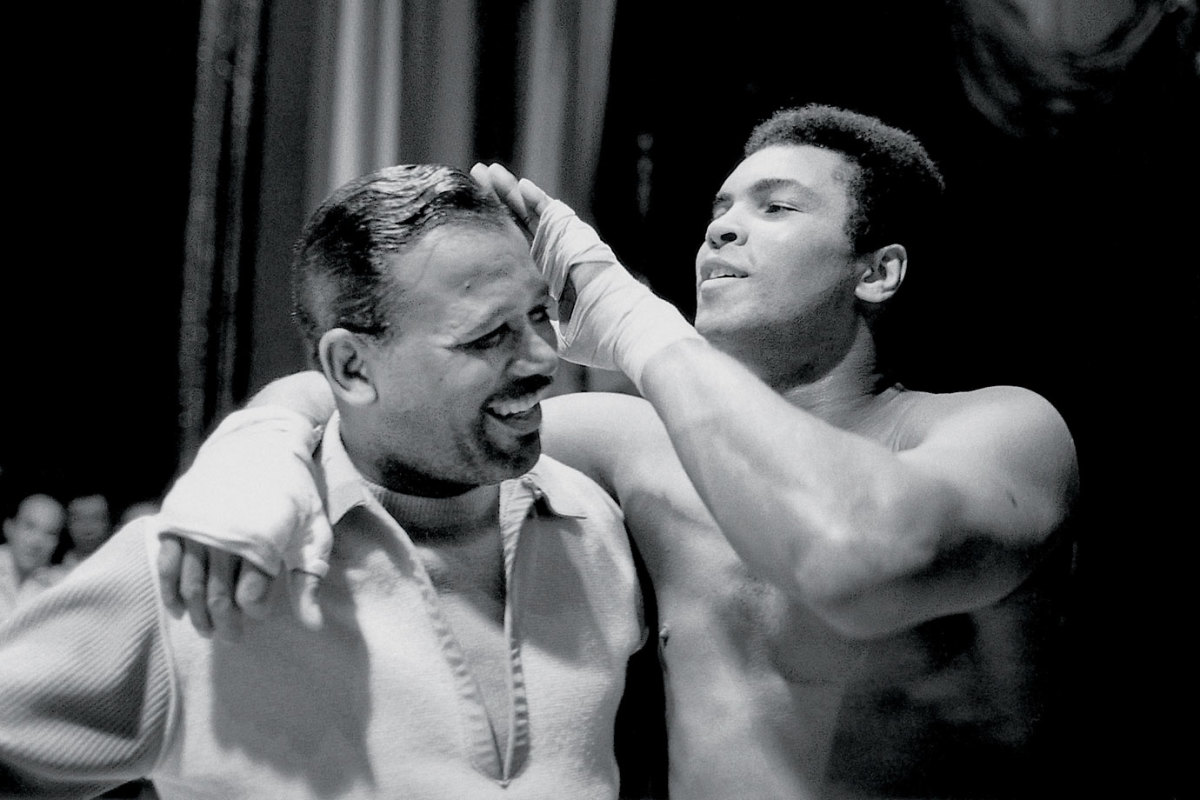
Ali plays with Sugar Ray Robinson's hair in the locker room before his bout with Bugner. The former welterweight and middleweight champion was Ali's childhood idol.
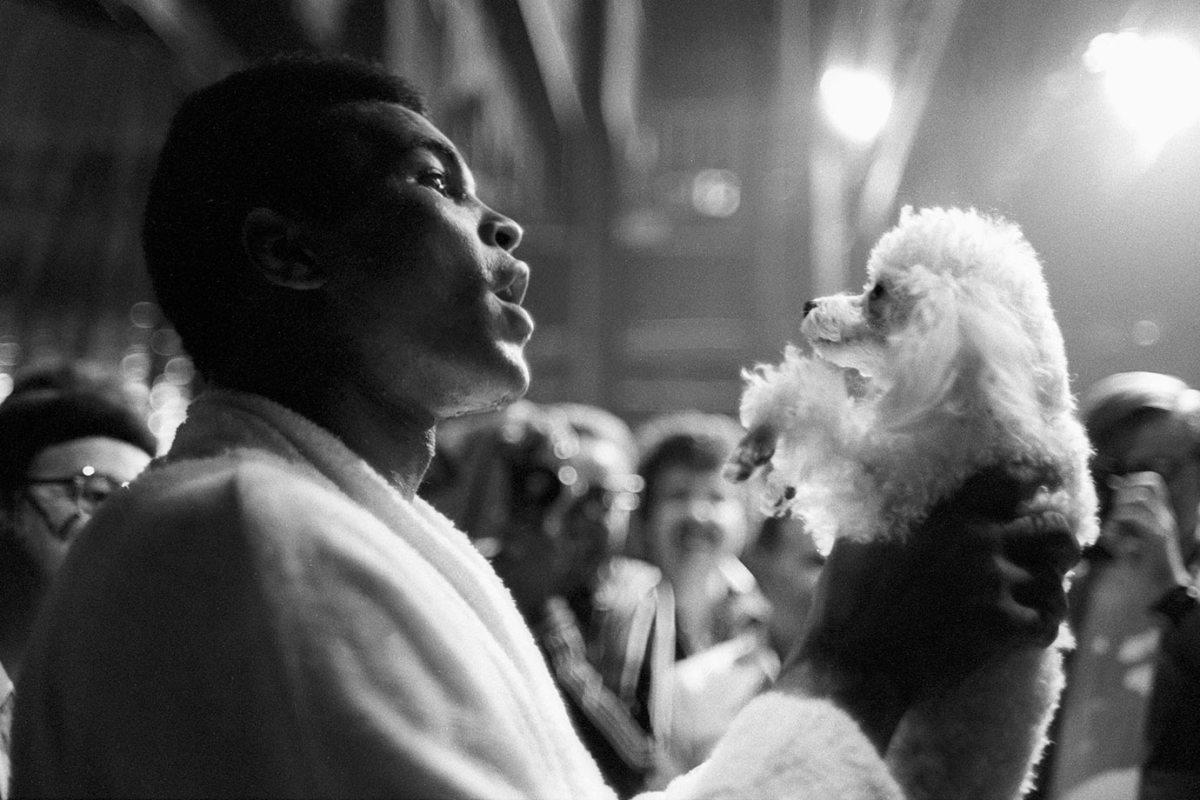
Before the fight with Bugner, Muhammad Ali enjoys a relaxed moment with a poodle at Caesars Palace Hotel. He won the fight with Bugner by unanimous decision.
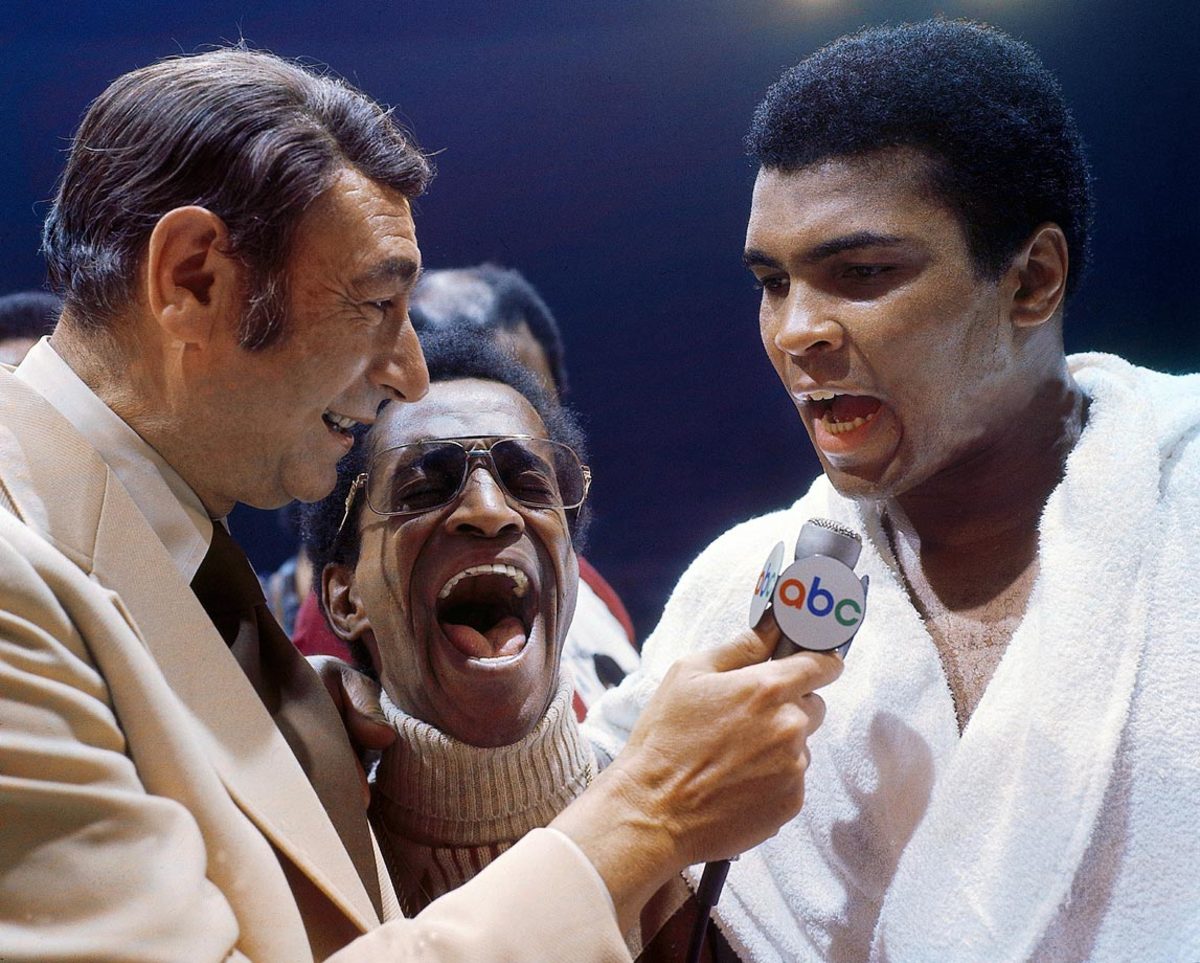
Howard Cosell interviews Ali, with entertainer Sammy Davis Jr. in the middle, after his victory over Joe Bugner by unanimous decision in. Although the fight was never in jeopardy of getting away from him, Ali praised Bugner's legs and said he could be a champion in a few years.
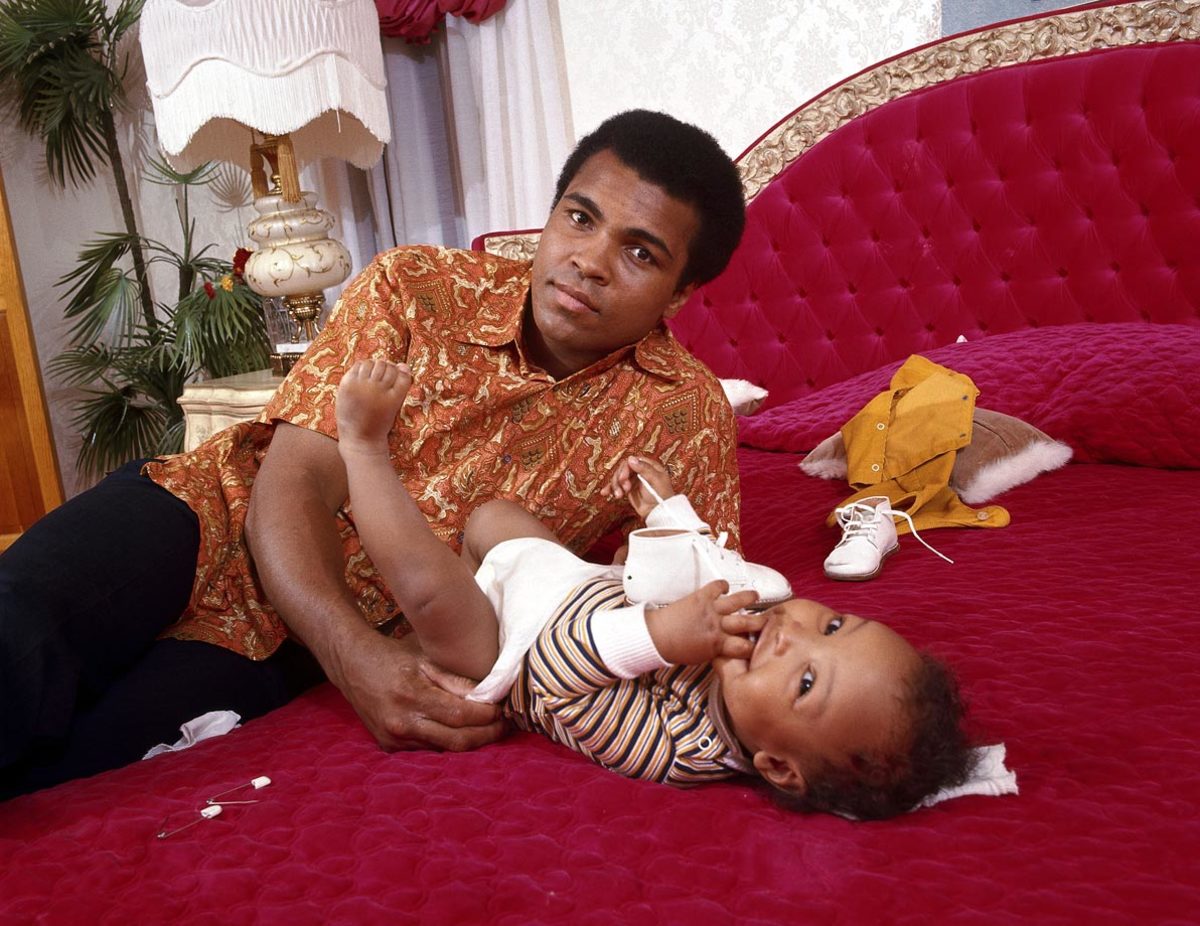
Ali changes the diaper of his son in his bedroom during a photo shoot at the family's home in April 1973. Ali had suffered a broken jaw less than a month earlier in his fight against Ken Norton.
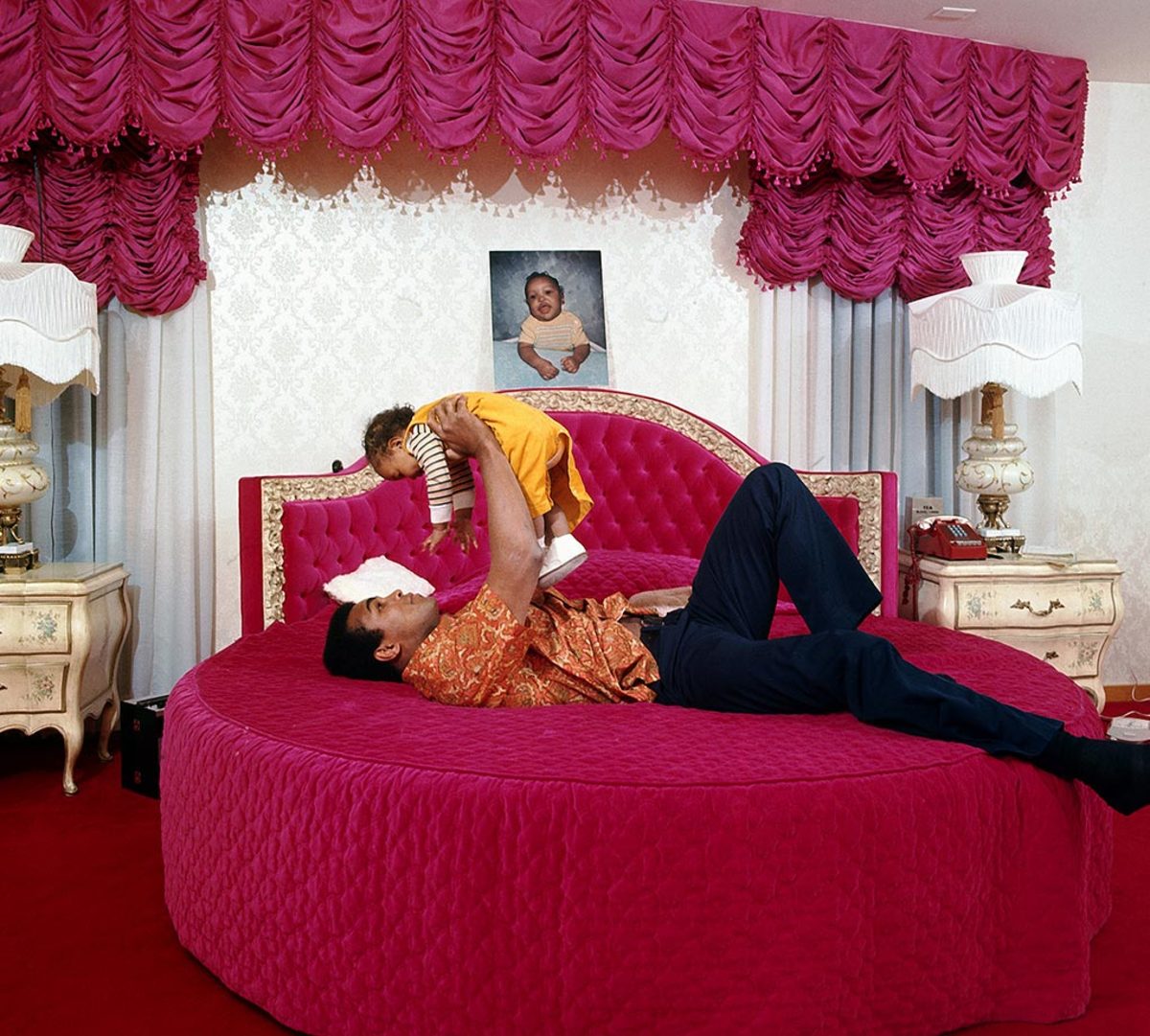
In the wake of his split decision loss to Norton, Ali plays with his son in his bedroom at home in Cherry Hill, N.J.
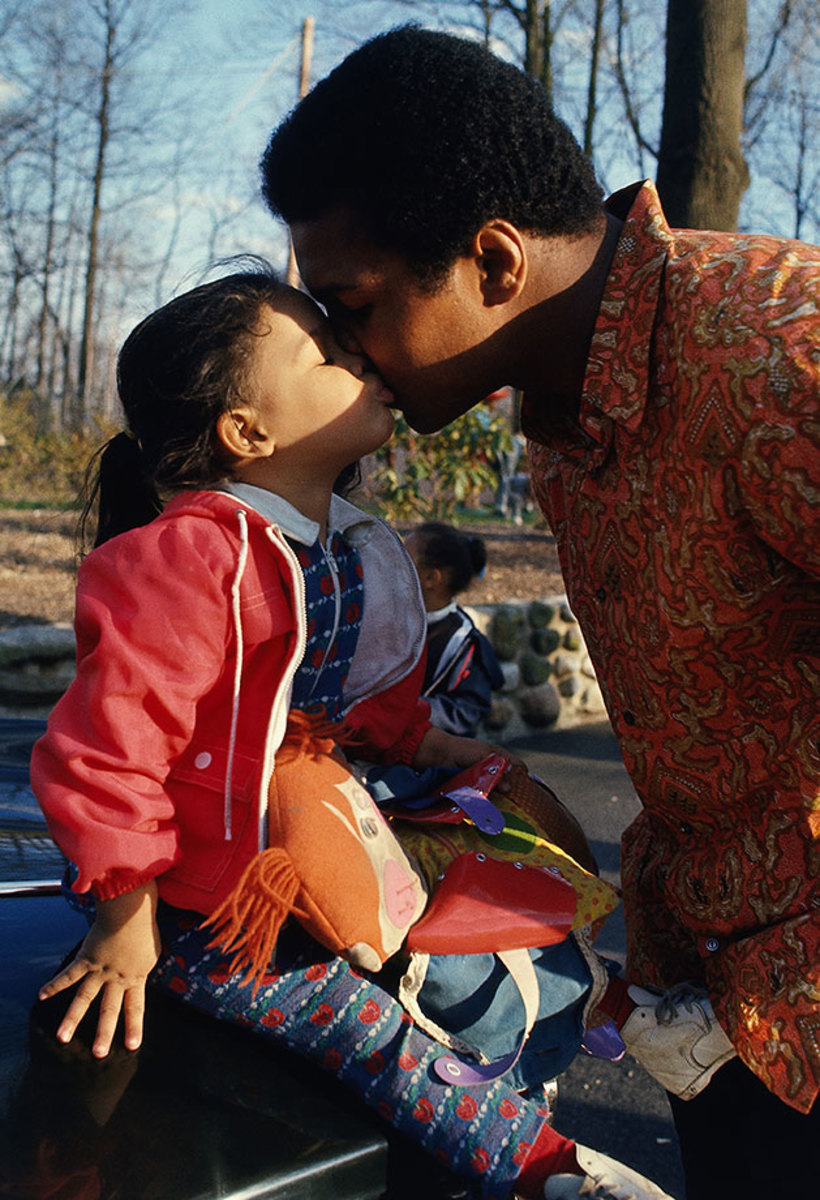
Ali kisses his daughter Jamillah outside of their home following the loss to Norton, just the second defeat of his career.
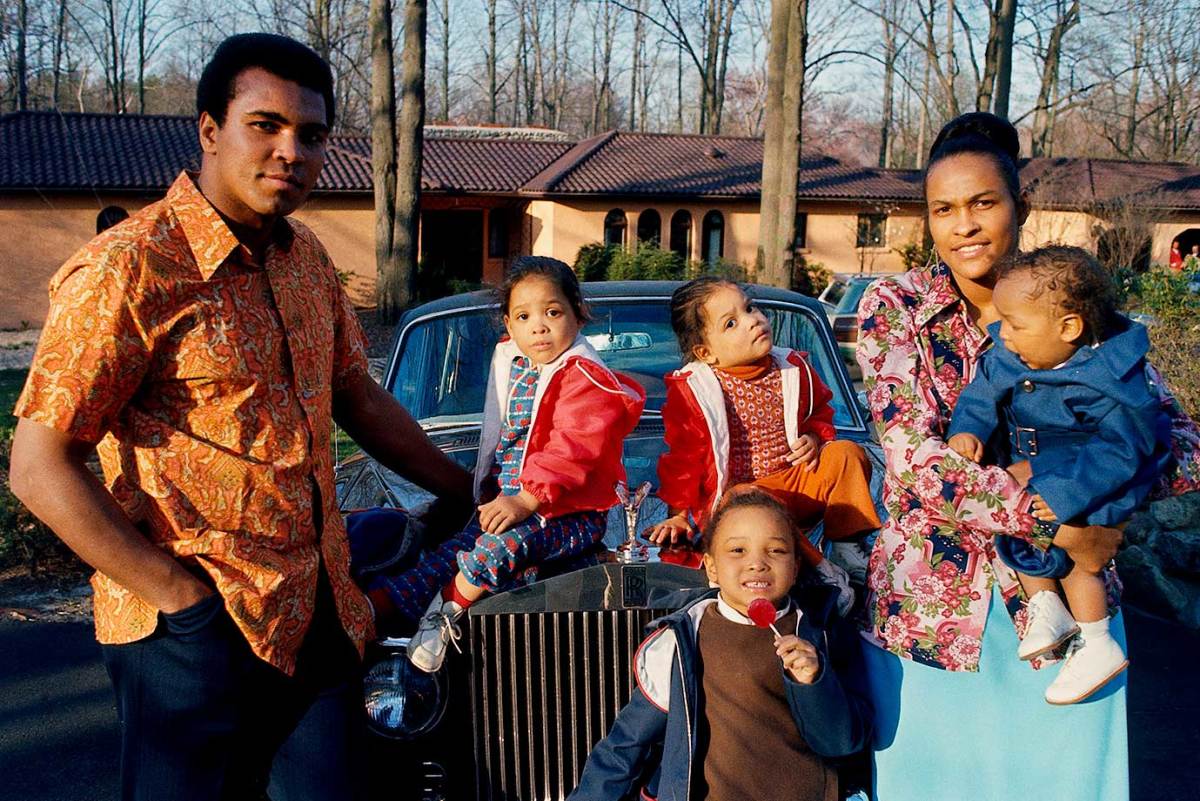
The Ali family standing outside their New Jersey home. To the right of Muhammad Ali are his twin daughters, Jamilllah and Rasheda, daughter Maryum and his wife, Khalilah, holding their son Ibn Muhammad Ali Jr.
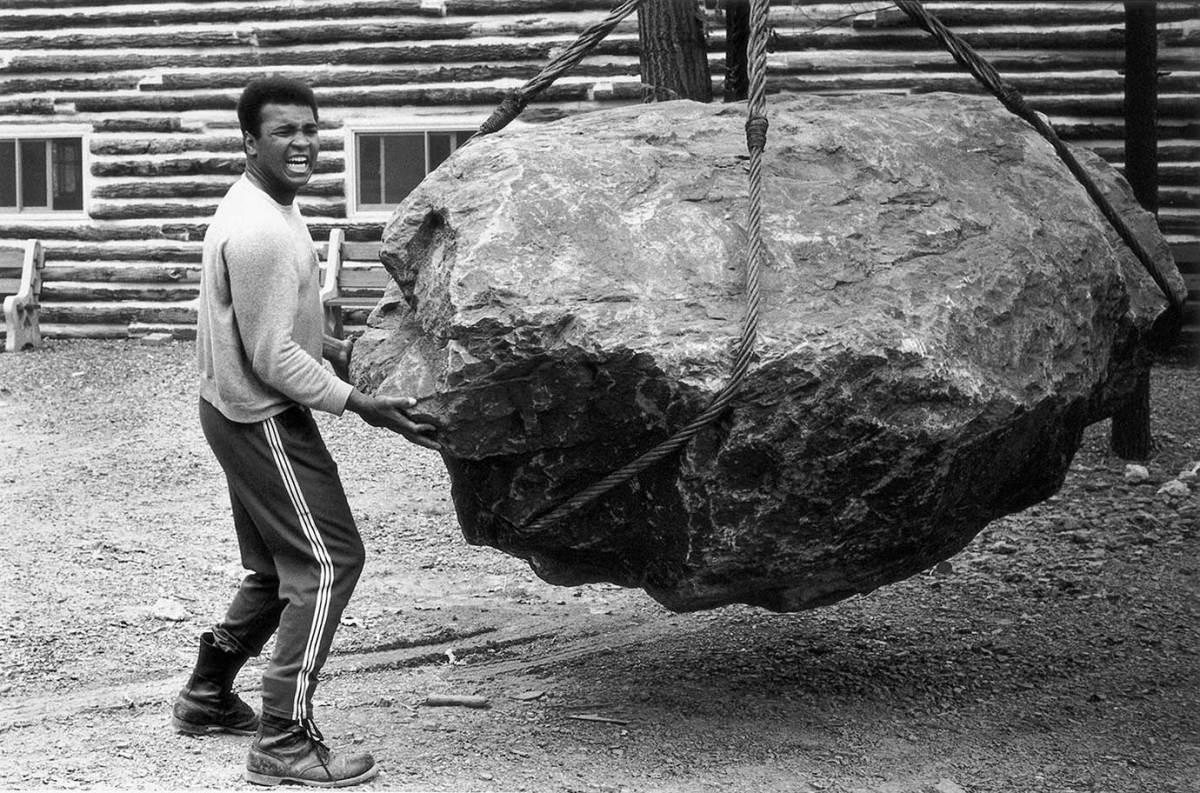
At his training camp cabin, Ali pushes a boulder during a photo shoot in Deer Lake, Penn., in August 1973. Ali was training for his rematch against Ken Norton, who broke his jaw five months earlier.
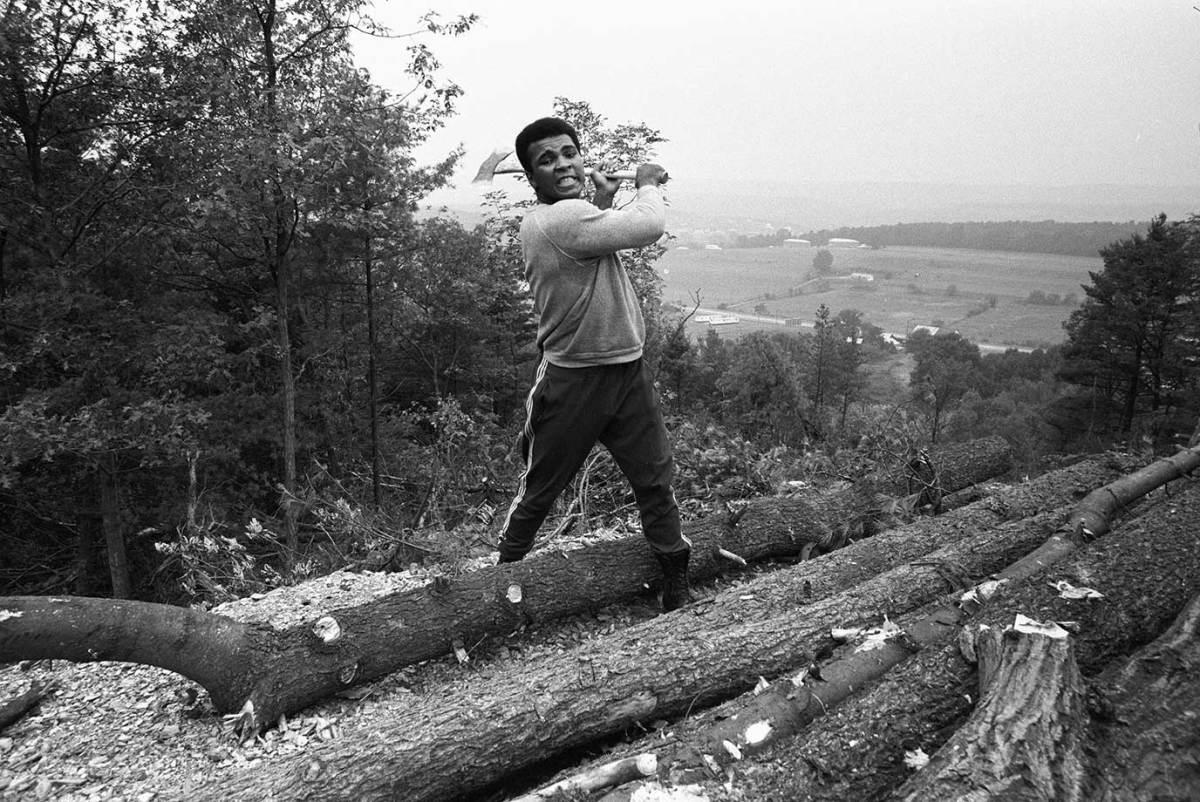
Ali chops wood at his cabin in Deer Lake. He referred to the training camp as "fighter's heaven" and used it to prepare for fights away from the spotlight.
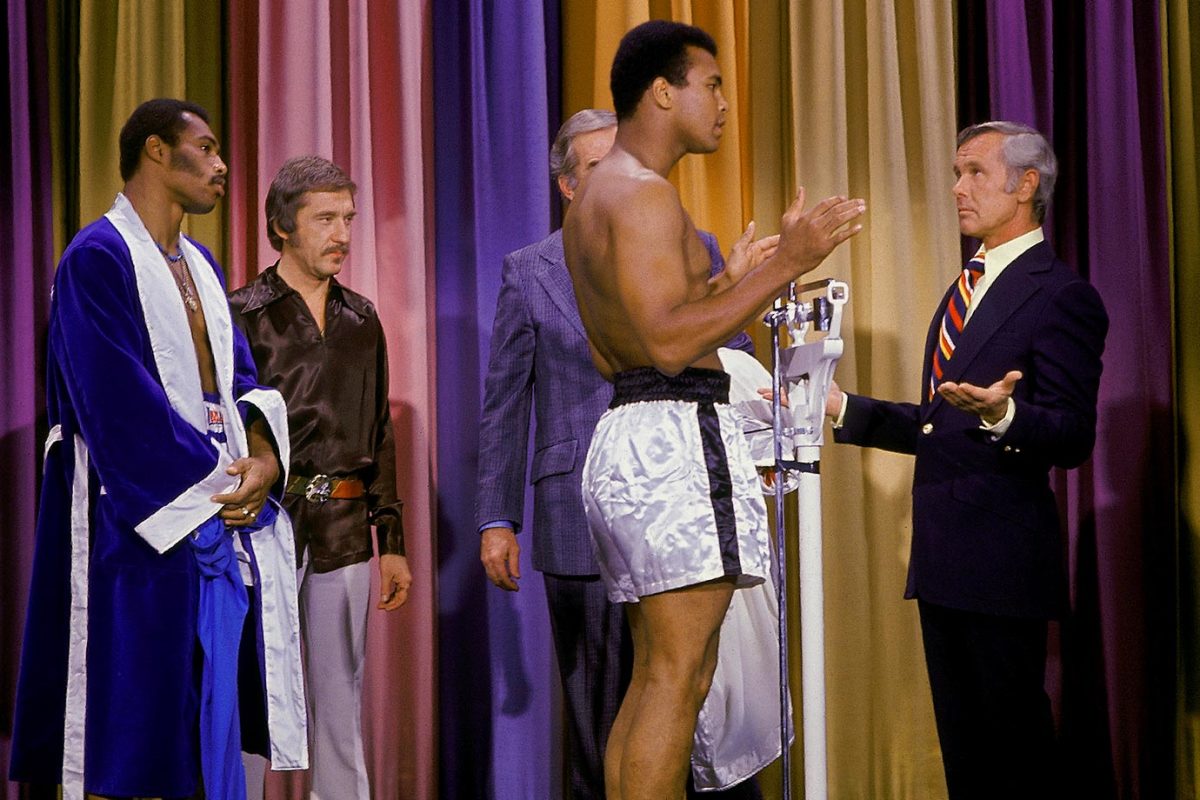
The fighters weigh in on the Tonight Show with Johnny Carson ahead of Ali and Ken Norton's September 1973 fight.
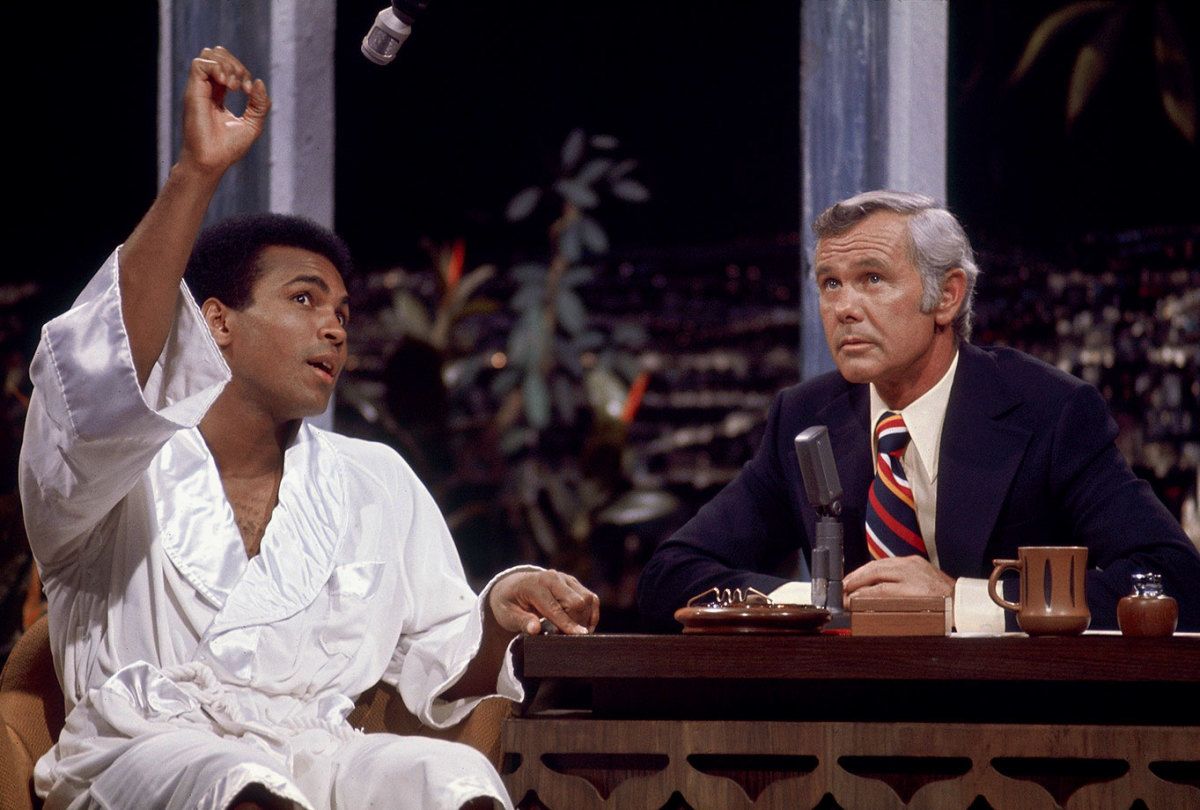
Johnny Carson listens to Ali on the Tonight Show three days before his rematch with Norton. Ali would avenge his earlier loss to Norton, winning a narrow split decision.
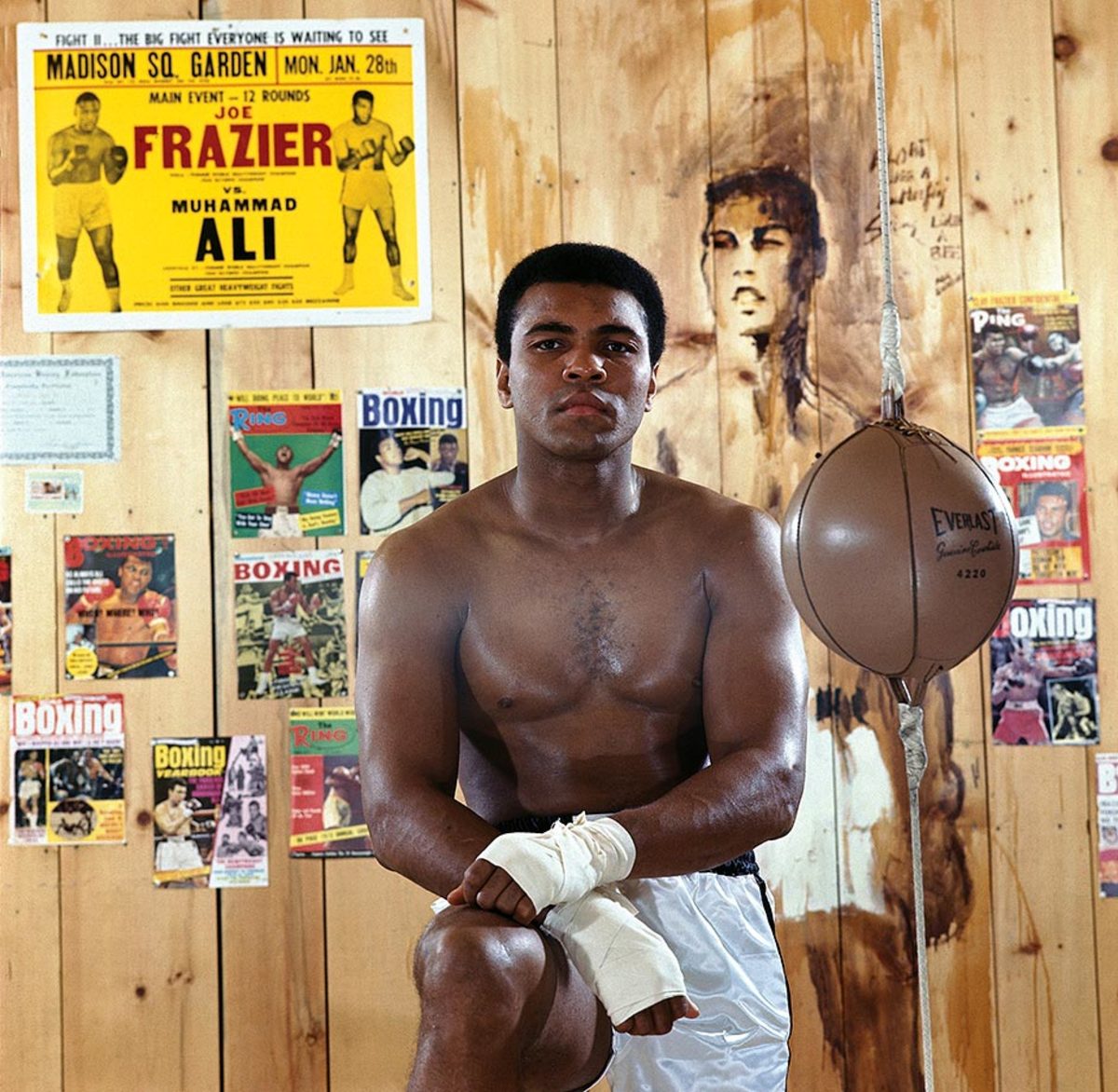
Ali poses in front of posters and magazine covers from throughout his career at his training camp cabin in Deer Lake in 1974.
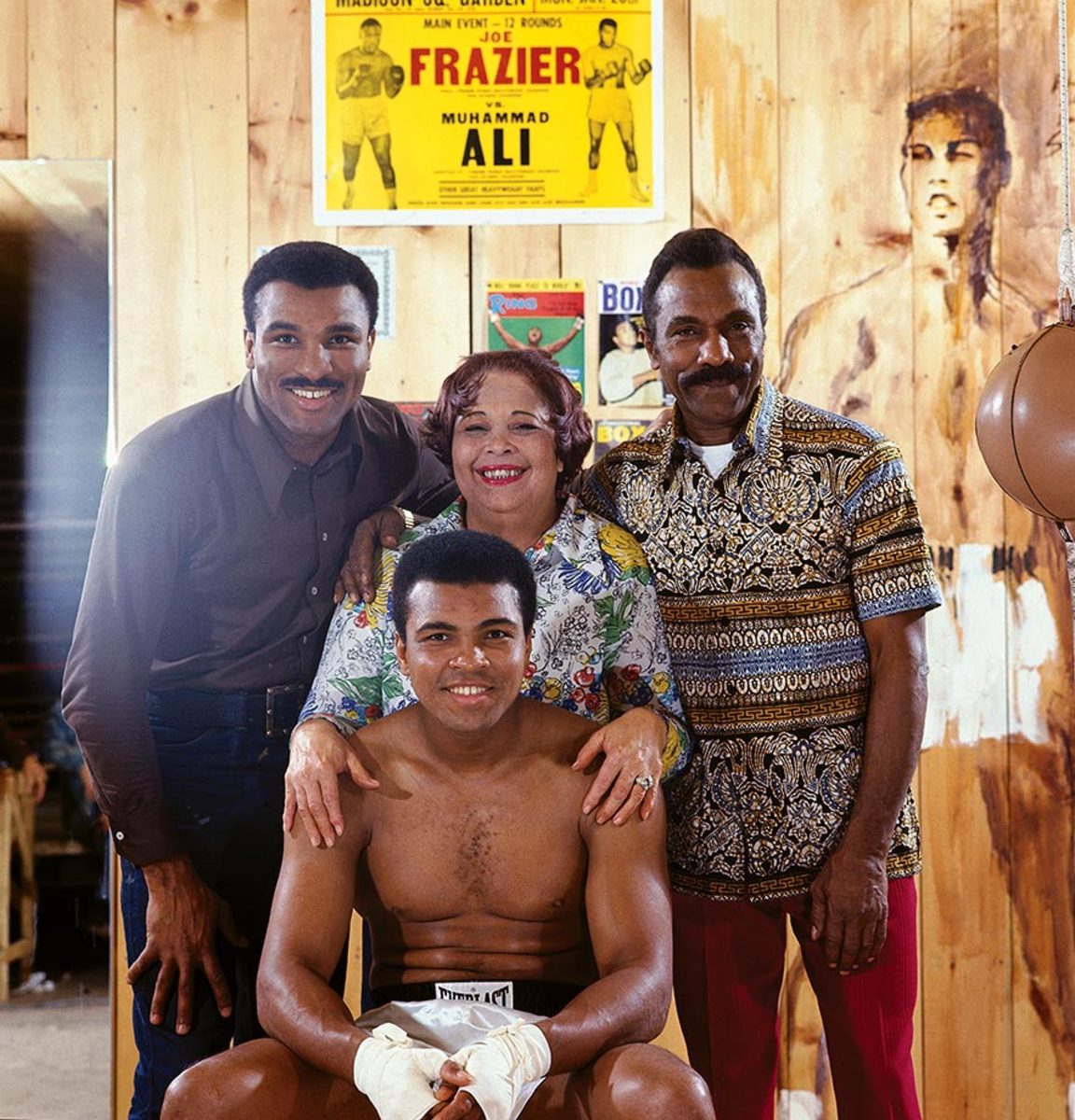
Ali poses with members of his family in front of a poster from his first fight with Joe Frazier. Ali's brother, Rahman Ali; mother, Odessa Clay; and father, Cassius Clay Sr. stand behind the boxer.
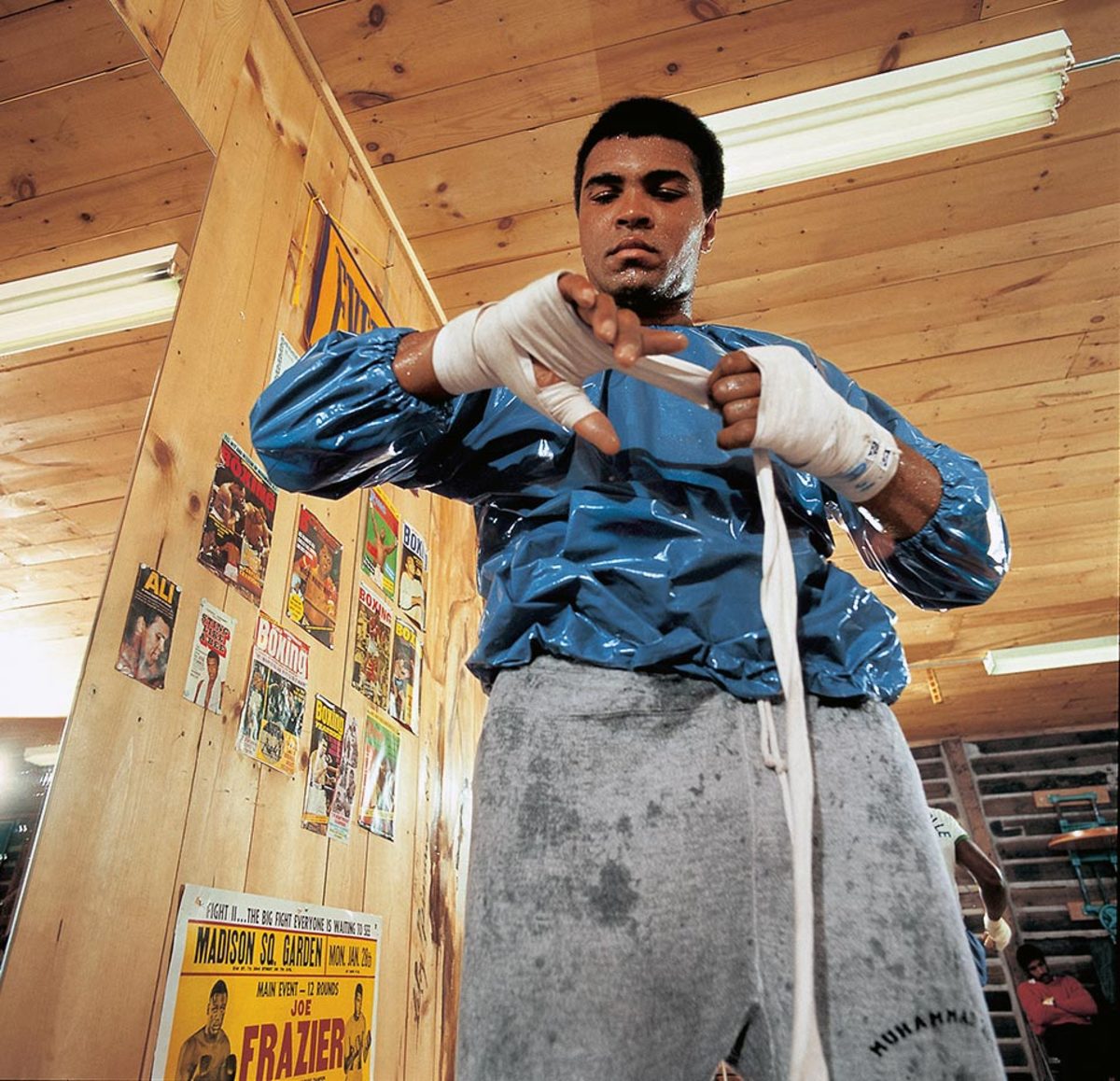
Less than three weeks before his rematch with Joe Frazier on Jan. 28, 1974, Ali wraps his hands while wearing a sauna suit at his training camp cabin.
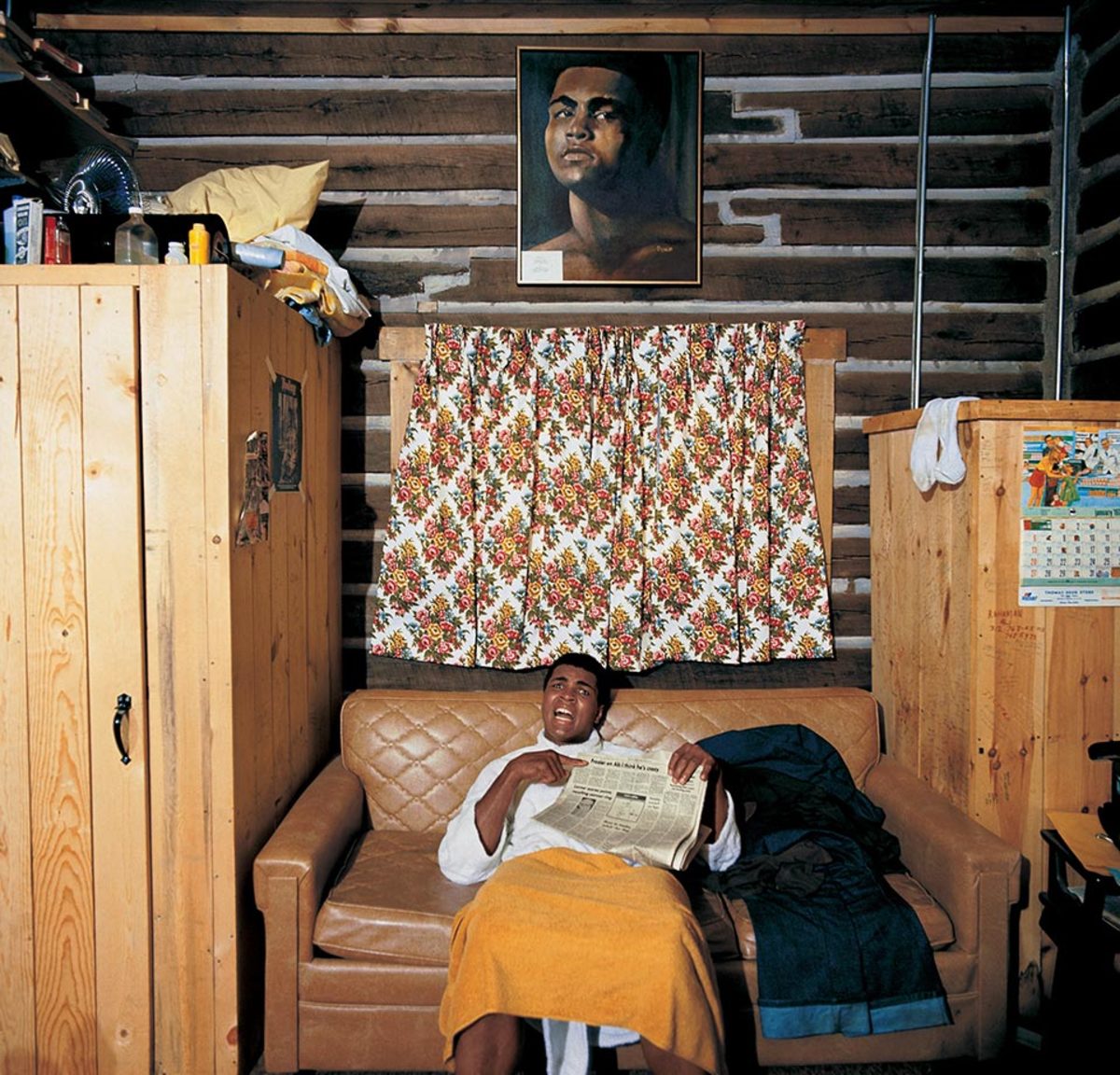
Ali holds a newspaper at his cabin in January 1974. He is pointing to a headline that reads, "Frazier On Ali, I Think He's Crazy." Ali and Frazier fought for the second time later that month with Ali winning by a unanimous decision.
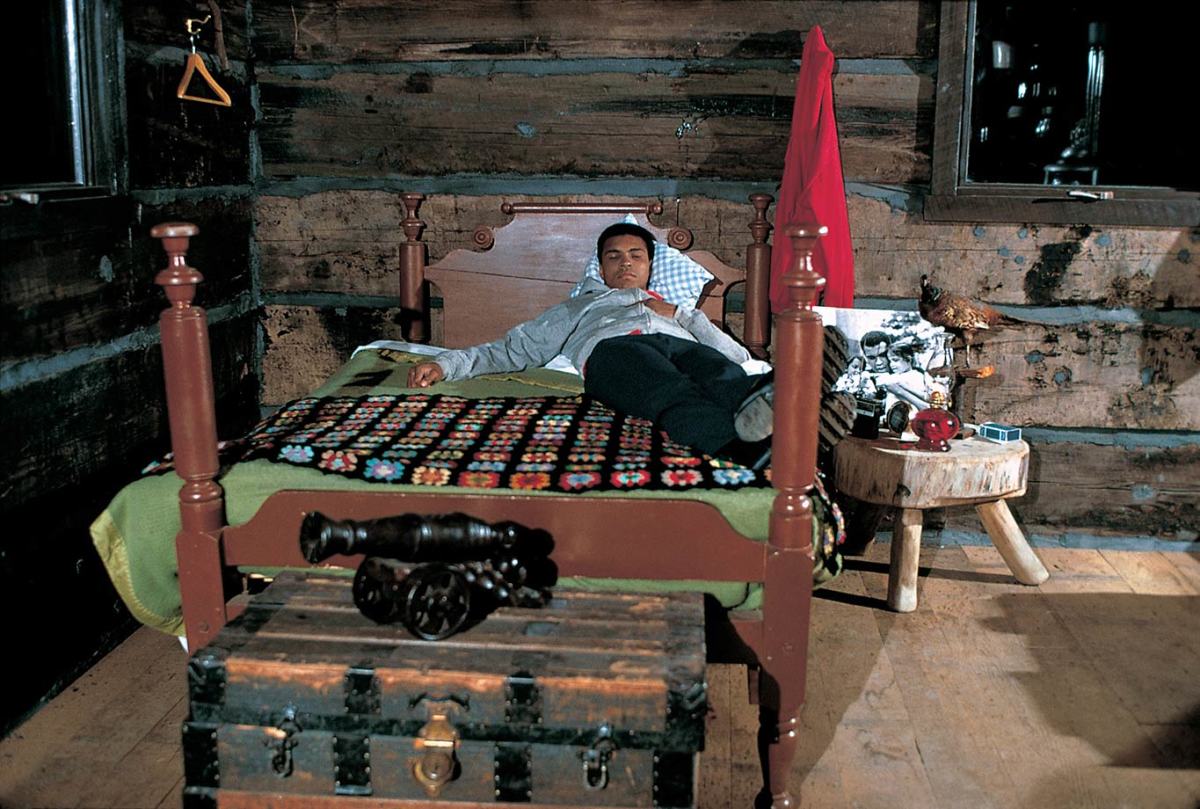
Ali lies on his bed at his cabin during the January 1974 photo shoot.
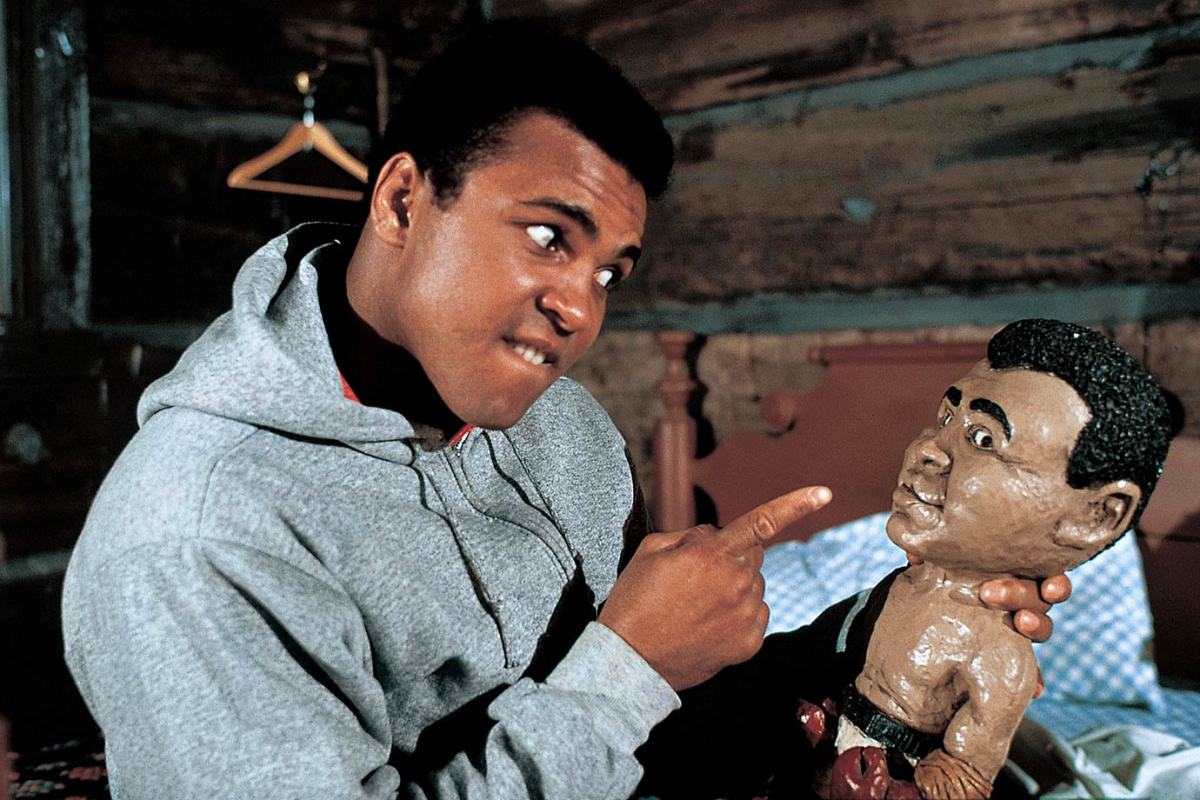
His smaller incarnation stares straight back as Ali plays with a doll of himself during the same 1974 shoot at his training camp cabin.
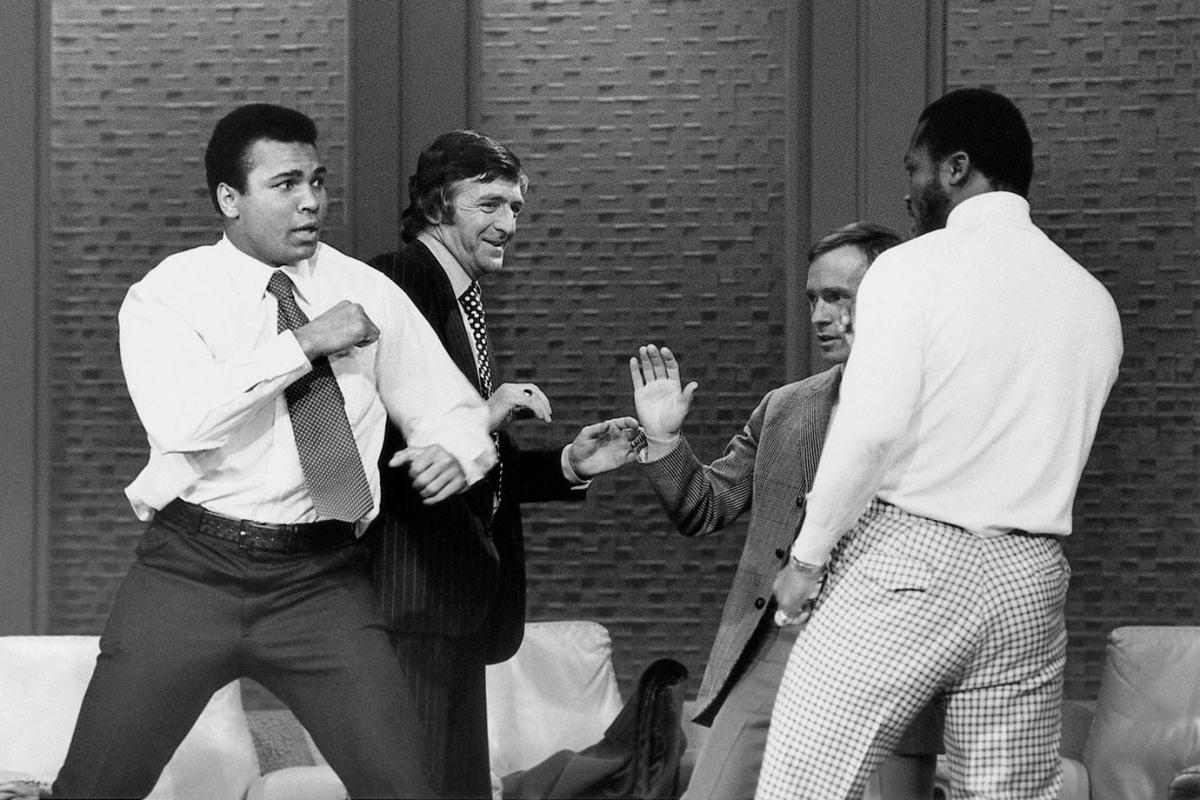
Ali and Joe Frazier fight on the set of The Dick Cavett Show while reviewing their 1971 bout in advance of their 1974 rematch. Ali called Frazier ignorant, to which Frazier took exception. As the studio crew tried to calm Frazier down, Ali held Frazier by the neck, forcing him to sit down and sparking a fight. The television set fight amped up anticipation of their January 1974 bout.
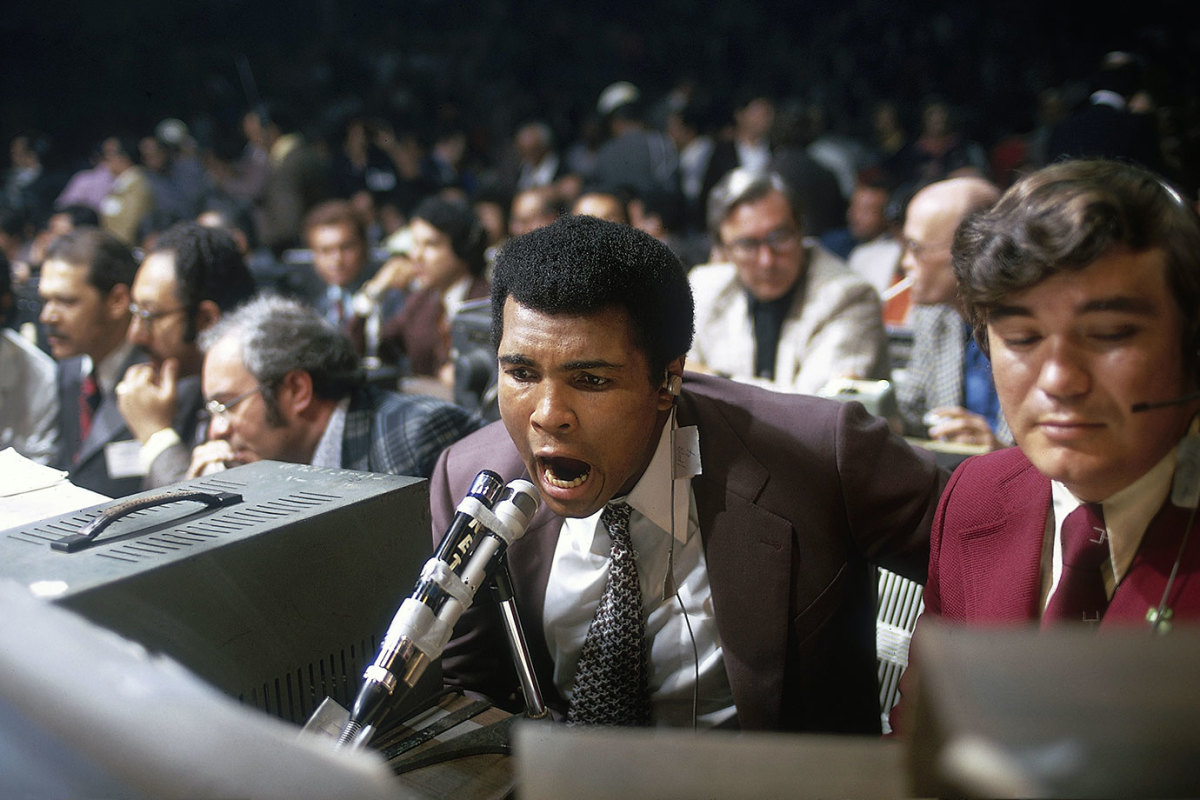
Exploring a different side of the sport, Ali broadcasts the fight between George Foreman and Ken Norton in March 1974. Foreman won the fight by technical knockout in the second round, setting up the showdown with Ali in Zaire.
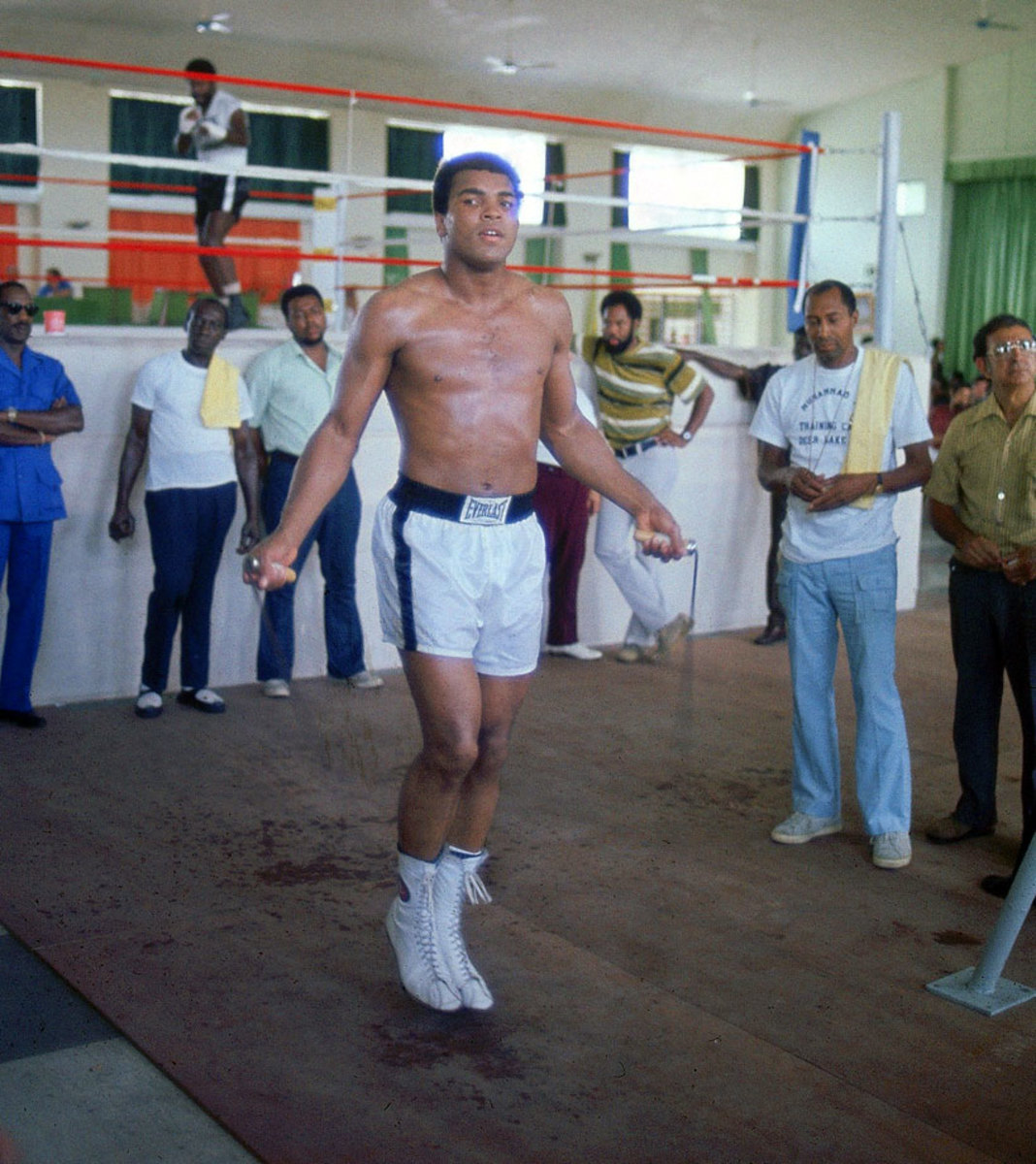
Ali jumps rope at the Salle de Congres in Kinshasa, Zaire, while training for his heavyweight title fight against George Foreman. Both Ali and Foreman spent most of the summer of 1974 training in Zaire to adjust to the climate.
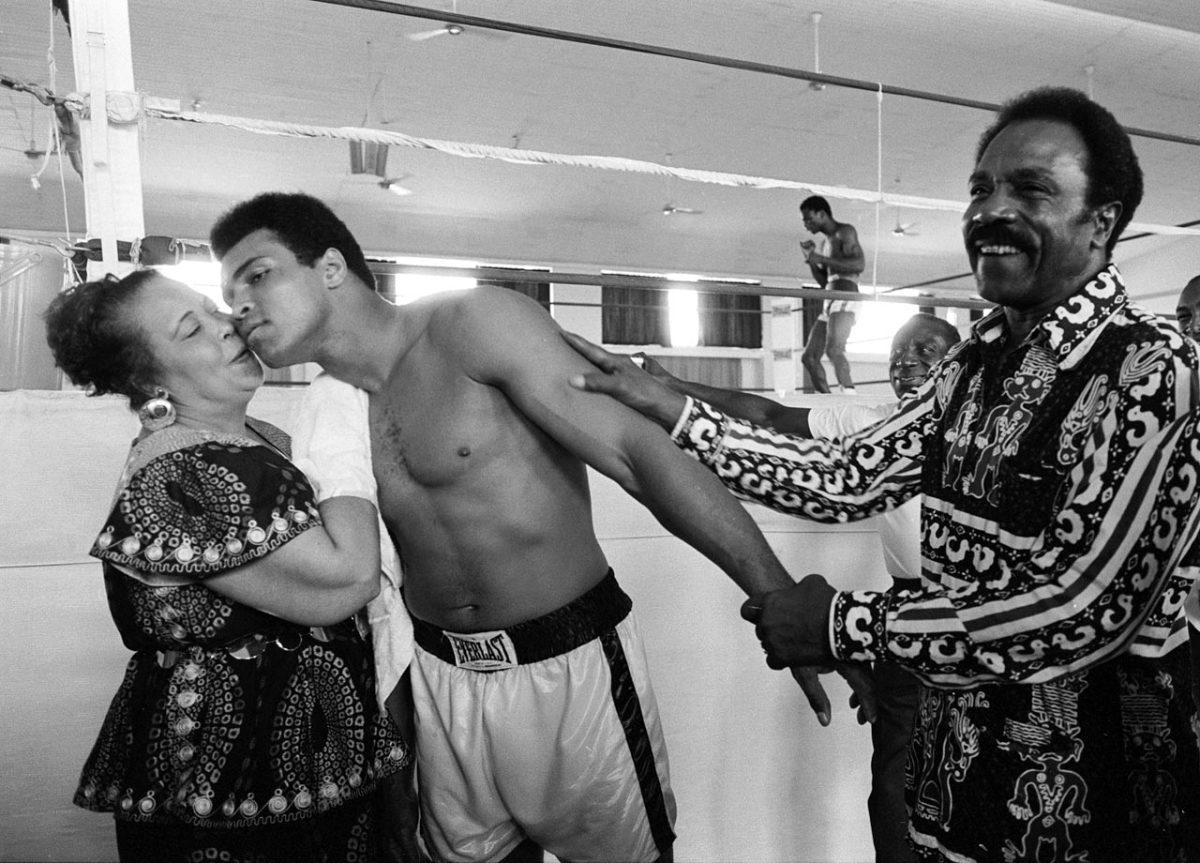
While training before his fight with George Foreman, Ali kisses his mother, Odessa Clay, while his father, Cassius Clay Sr., looks on. Ali's superior strategy and ability to take a punch led him to his upset victory as he absorbed body blows from Foreman before he responded with powerful combinations to Foreman's head.
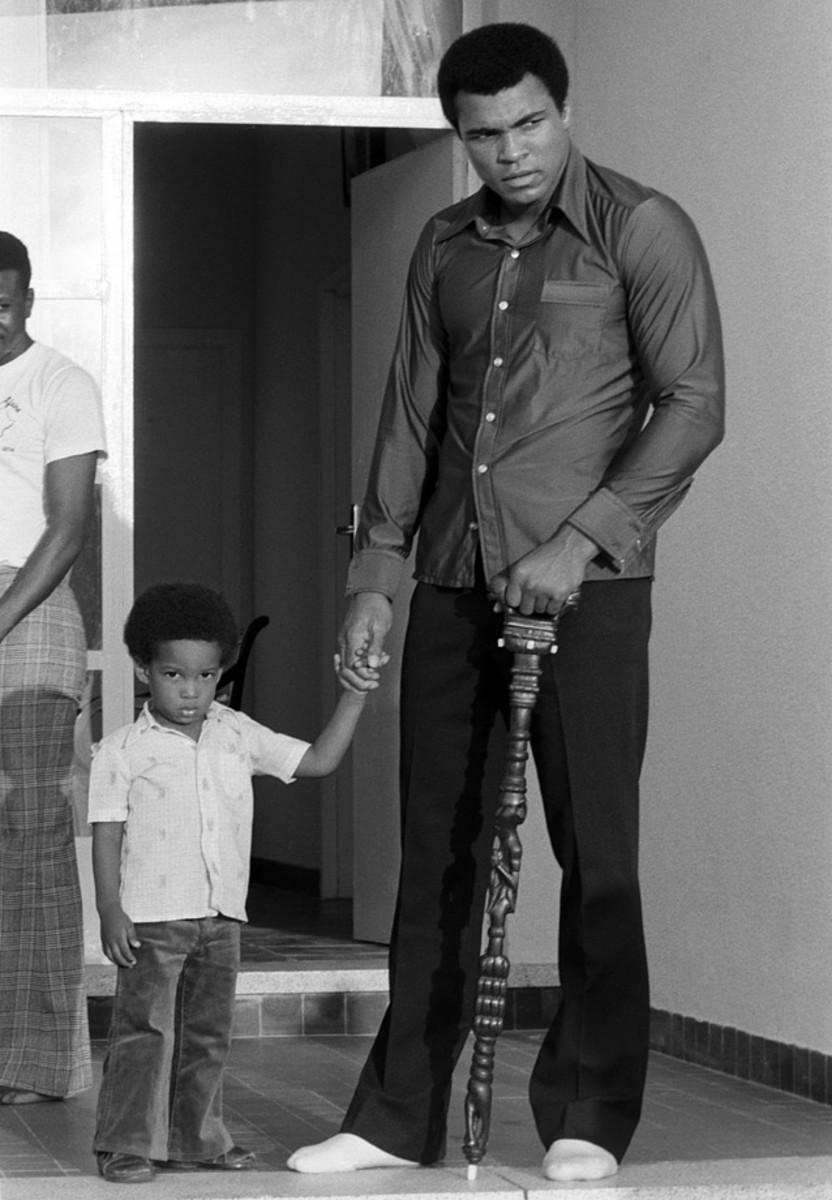
Four days before the fight, Ali holds the hand of his son Ibn in Zaire. Ali successfully courted the favor of the Zaire crowd, prompting chants of "Ali bomaye!" — translated as "Ali, kill him!"
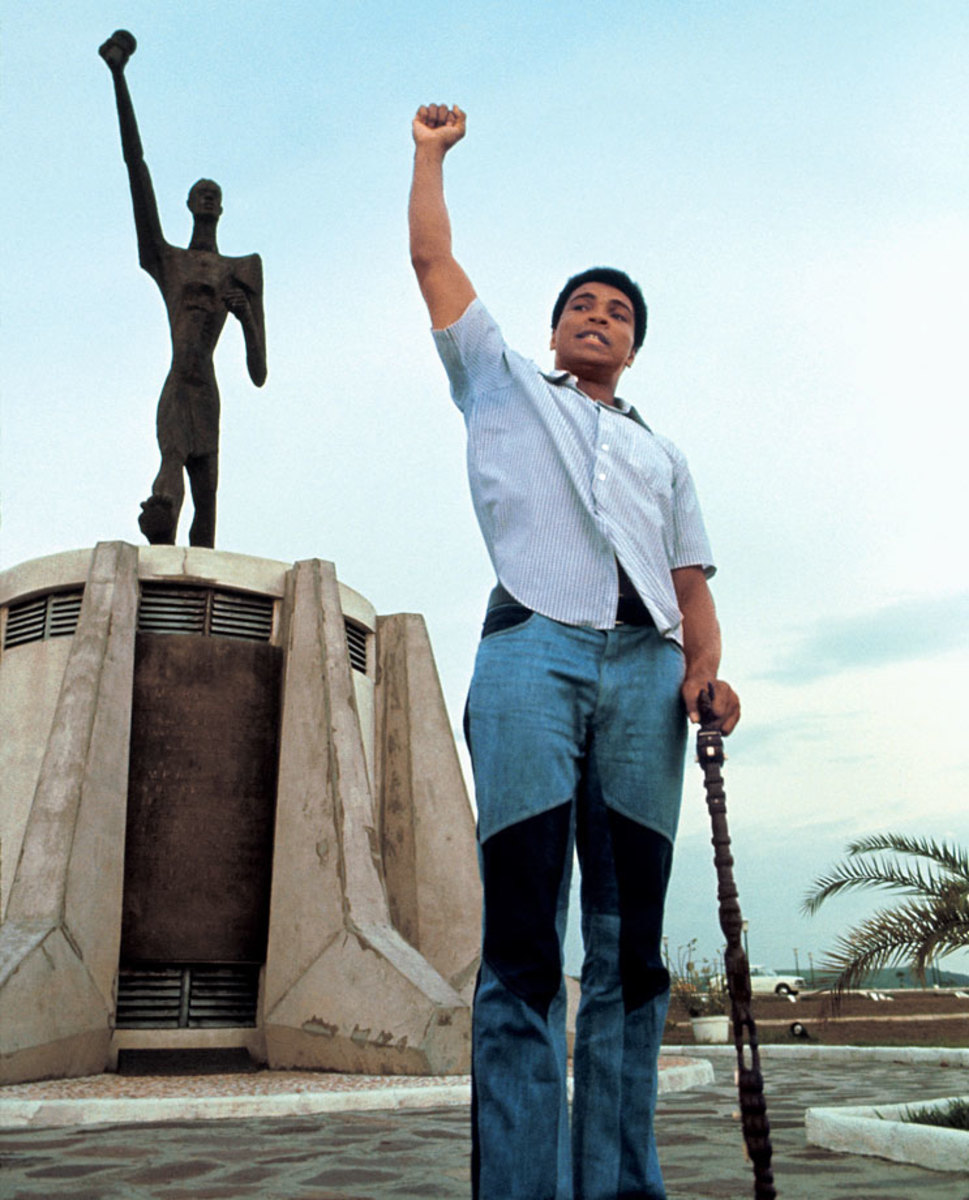
Ali poses in front of the Le Militant statue at the presidential complex that was the site of Ali's January heavyweight title bout with Foreman. The fight was originally set for a month earlier, but Foreman suffered a cut near his eye during training, forcing a delay.
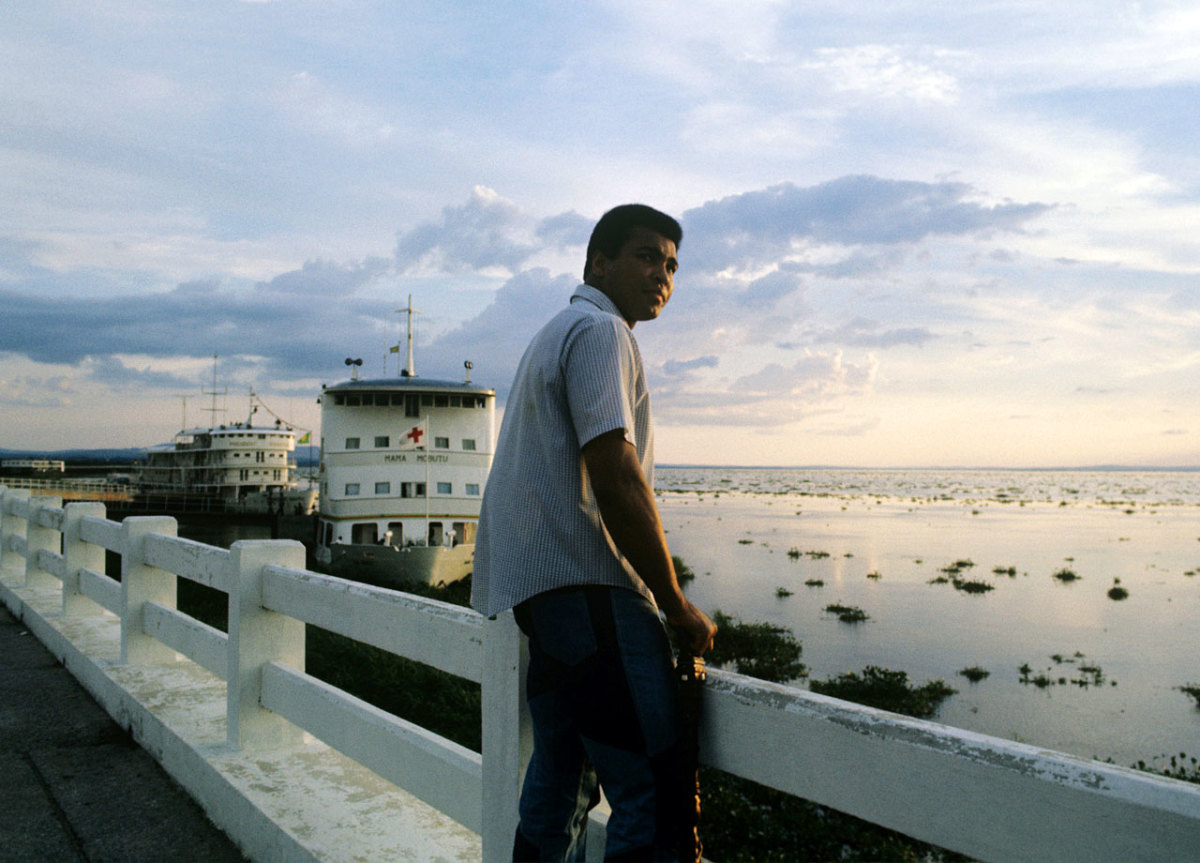
Ali stands against the railing on the River Zaire watching the sunset four days before the Rumble in the Jungle. The fight was sponsored by Zaire to achieve the $5 million purse promoter Don King had promised both Ali and Foreman.
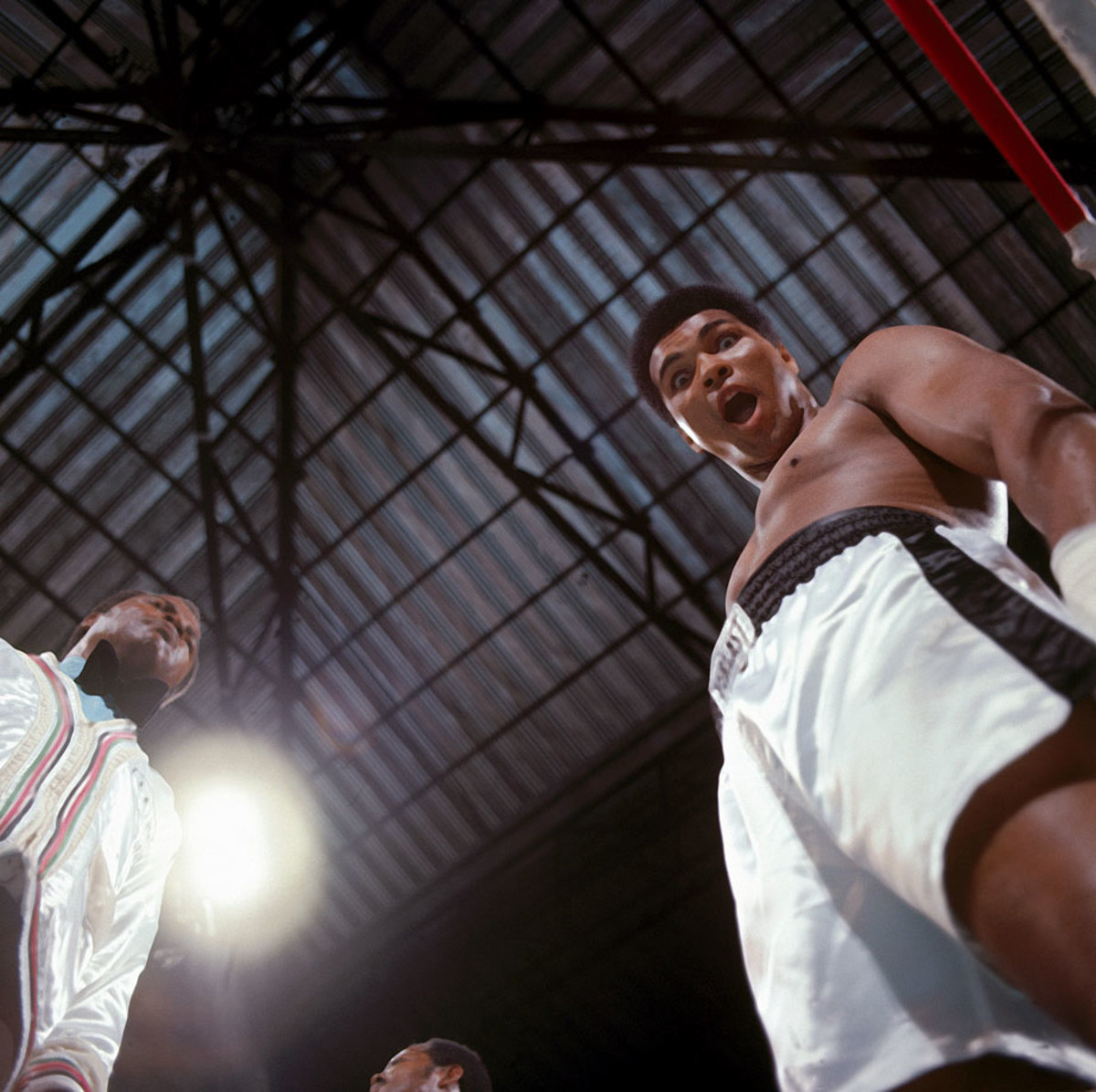
Before employing his famous rope-a-dope strategy against Foreman, Ali makes a face at the camera. Ali allowed Foreman to throw many punches but only into his arms and body, and when Foreman tired himself out from the mostly ineffective punches, Ali took control of the fight.
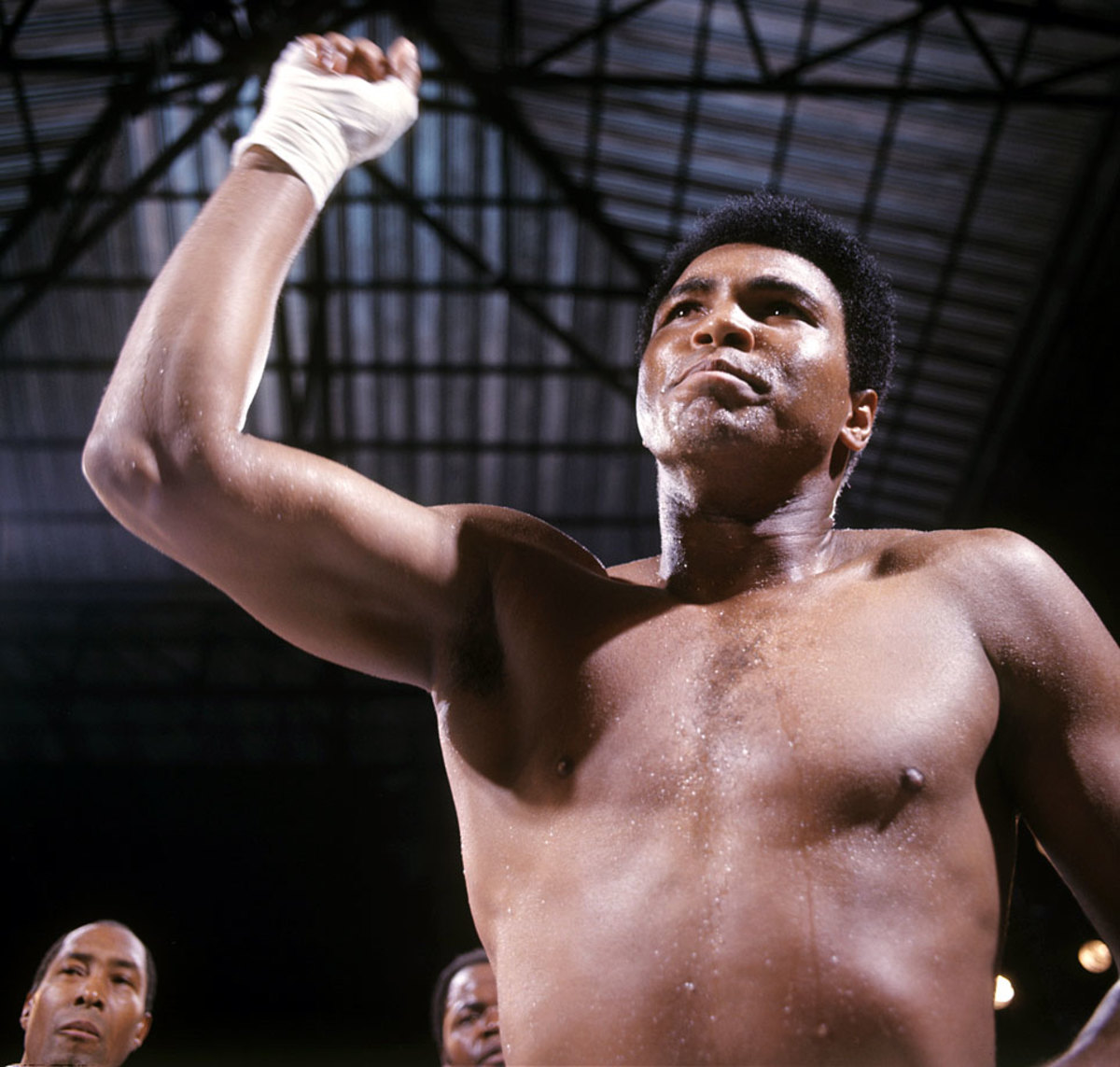
Ali points before his bout with Foreman. The victory over his favored opponent made him the heavyweight champion of the world for the first time since he was stripped of his titles in 1967.
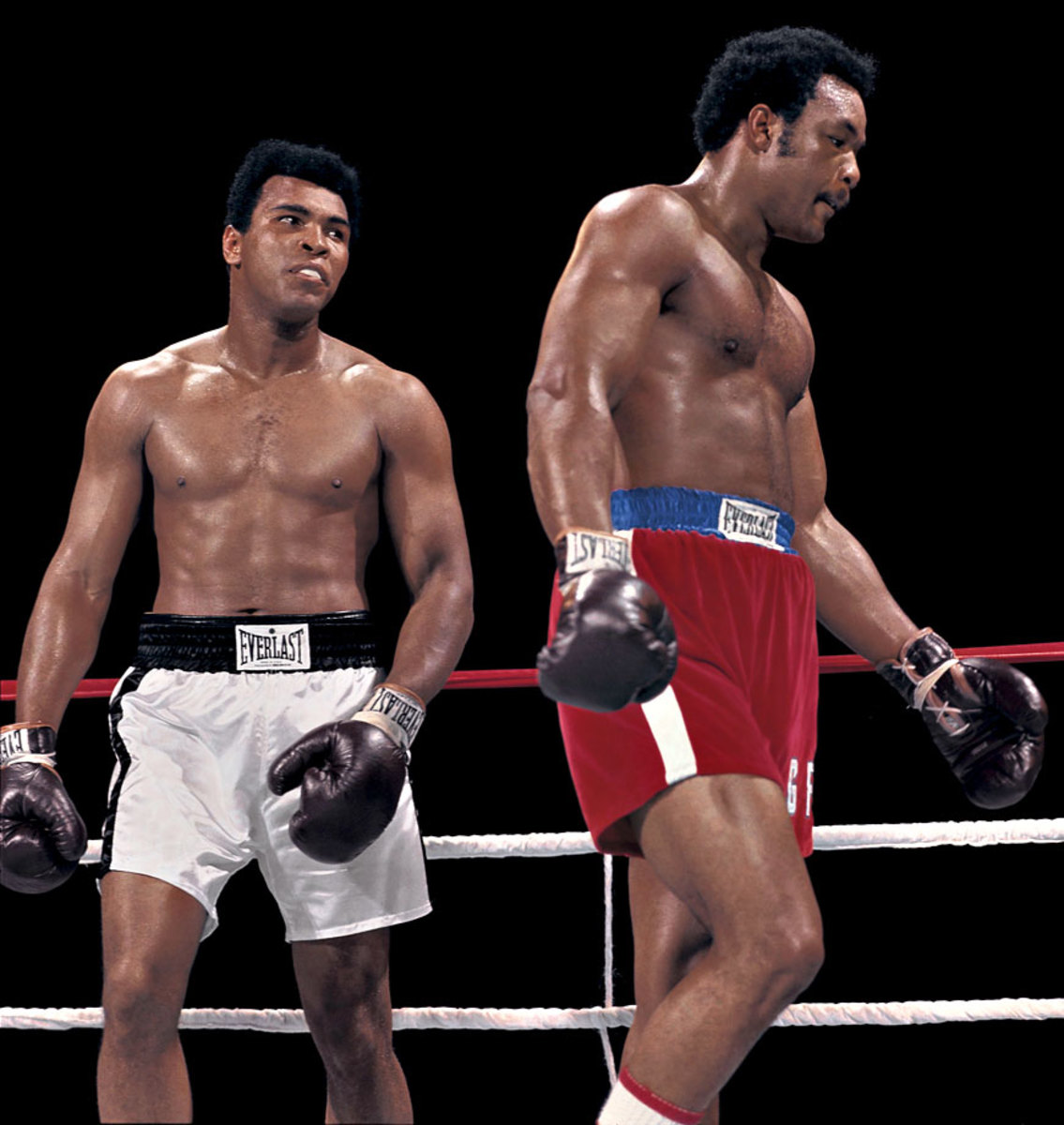
Ali stares at George Foreman during the Rumble in the Jungle. Ali earned his shot at the heavyweight title by defeating Joe Frazier in January 1974, avenging a loss three years earlier.
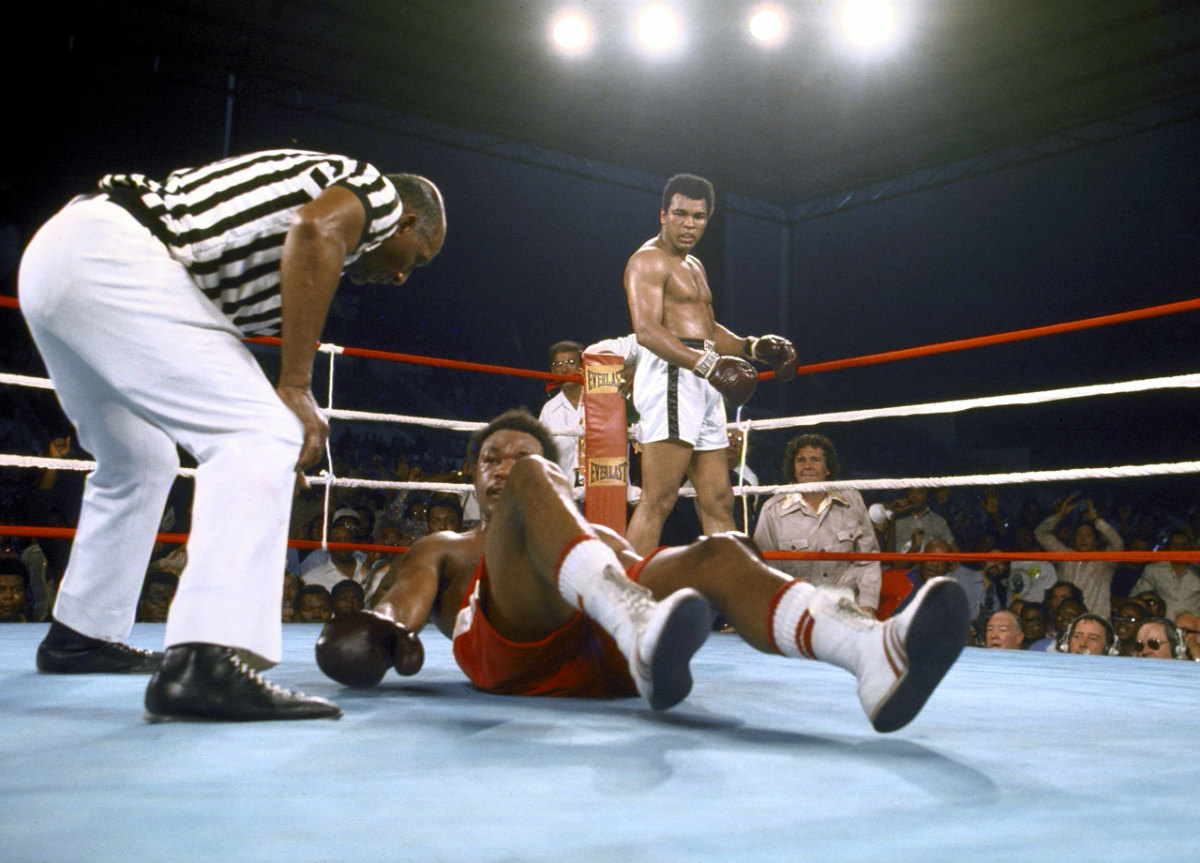
Foreman lies down on the canvas as Ali stands in the background during the Rumble in the Jungle. Ali knocked Foreman down with a five-punch combination in the eighth round, and referee Zack Clayton counted him out.
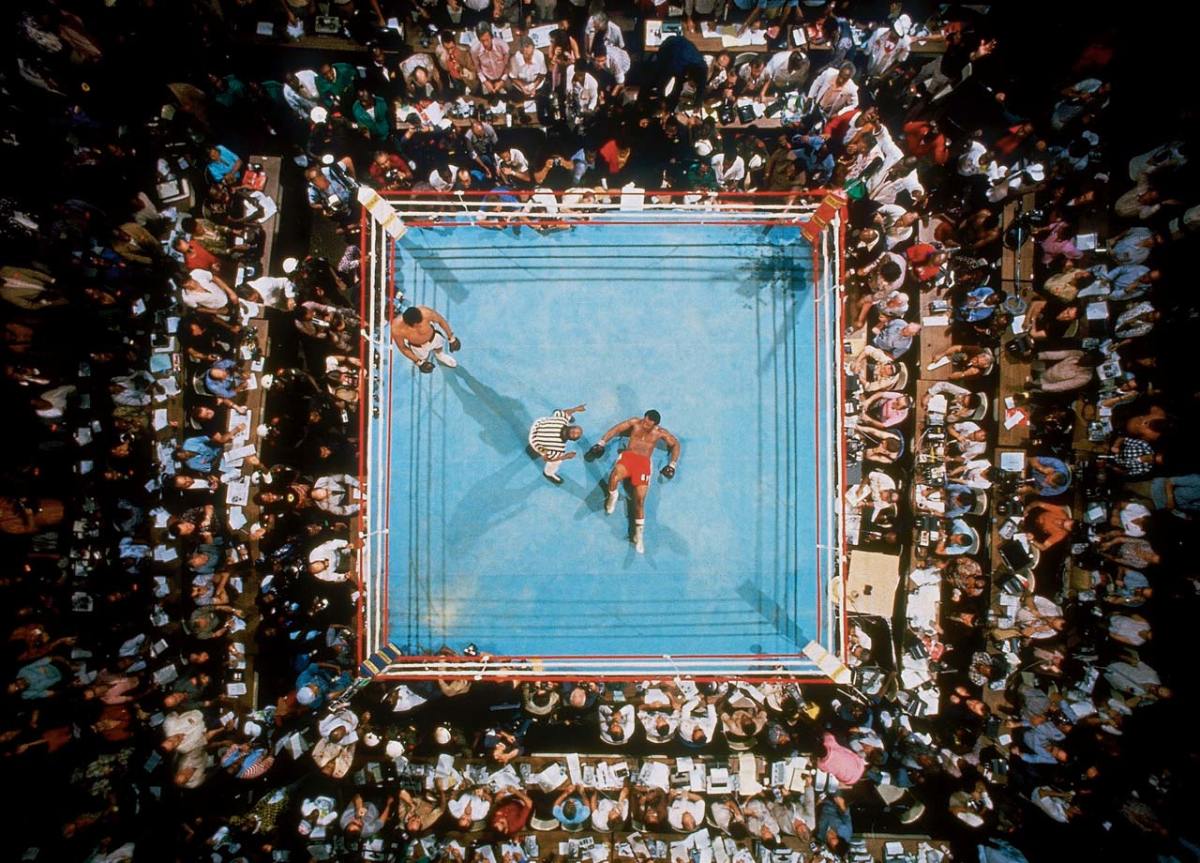
Big George stares at the ceiling as referee Zack Clayton counts him out in the eighth round. The victory made Ali, once again, the heavyweight champion of the world.
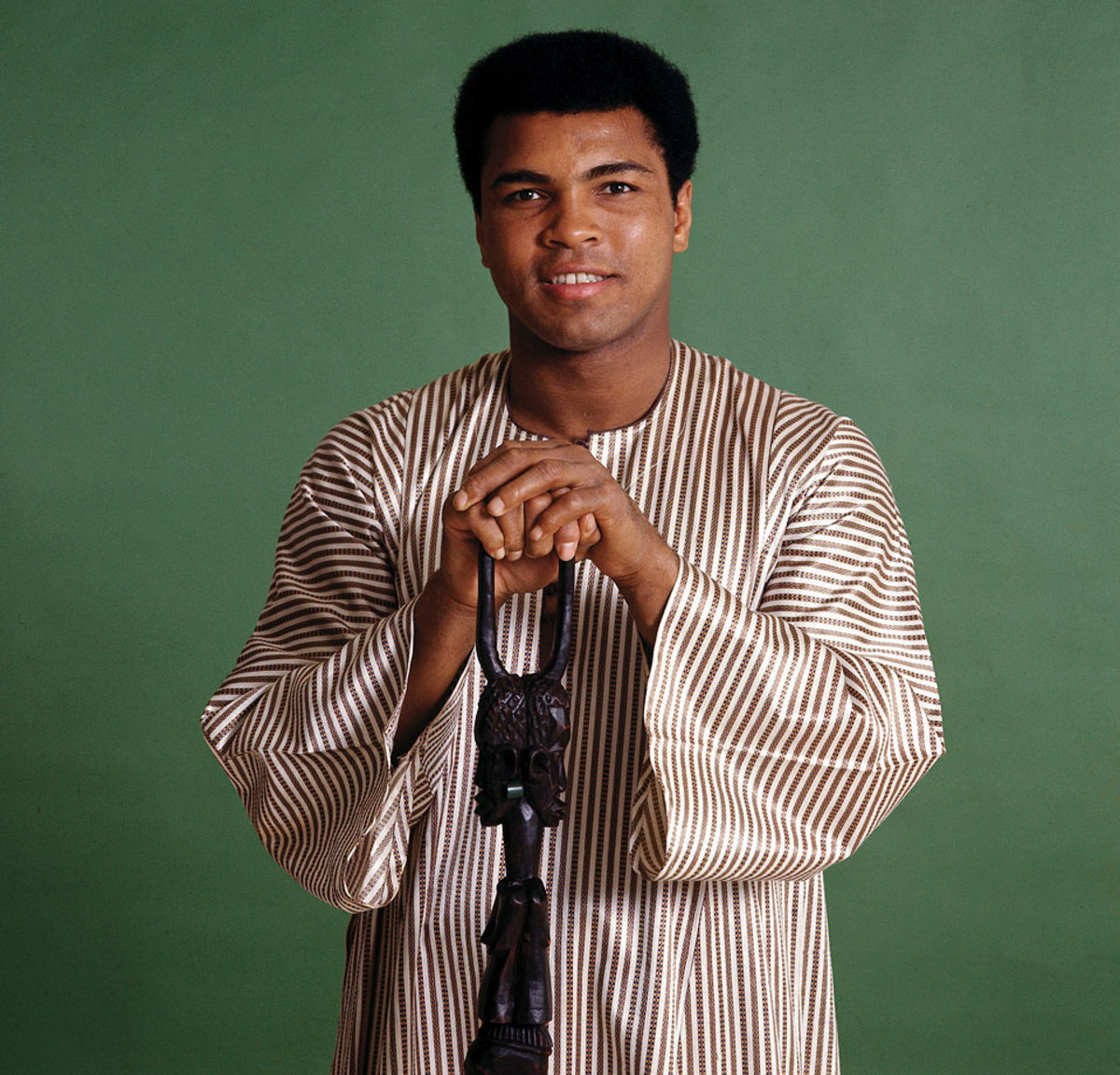
Ali poses for a portrait after being selected as the Sports Illustrated Sportsman of the Year in 1974. Ali wore a dashiki, a men's garment widely worn in West Africa. He also brought the walking stick given to him by Zaire's president.
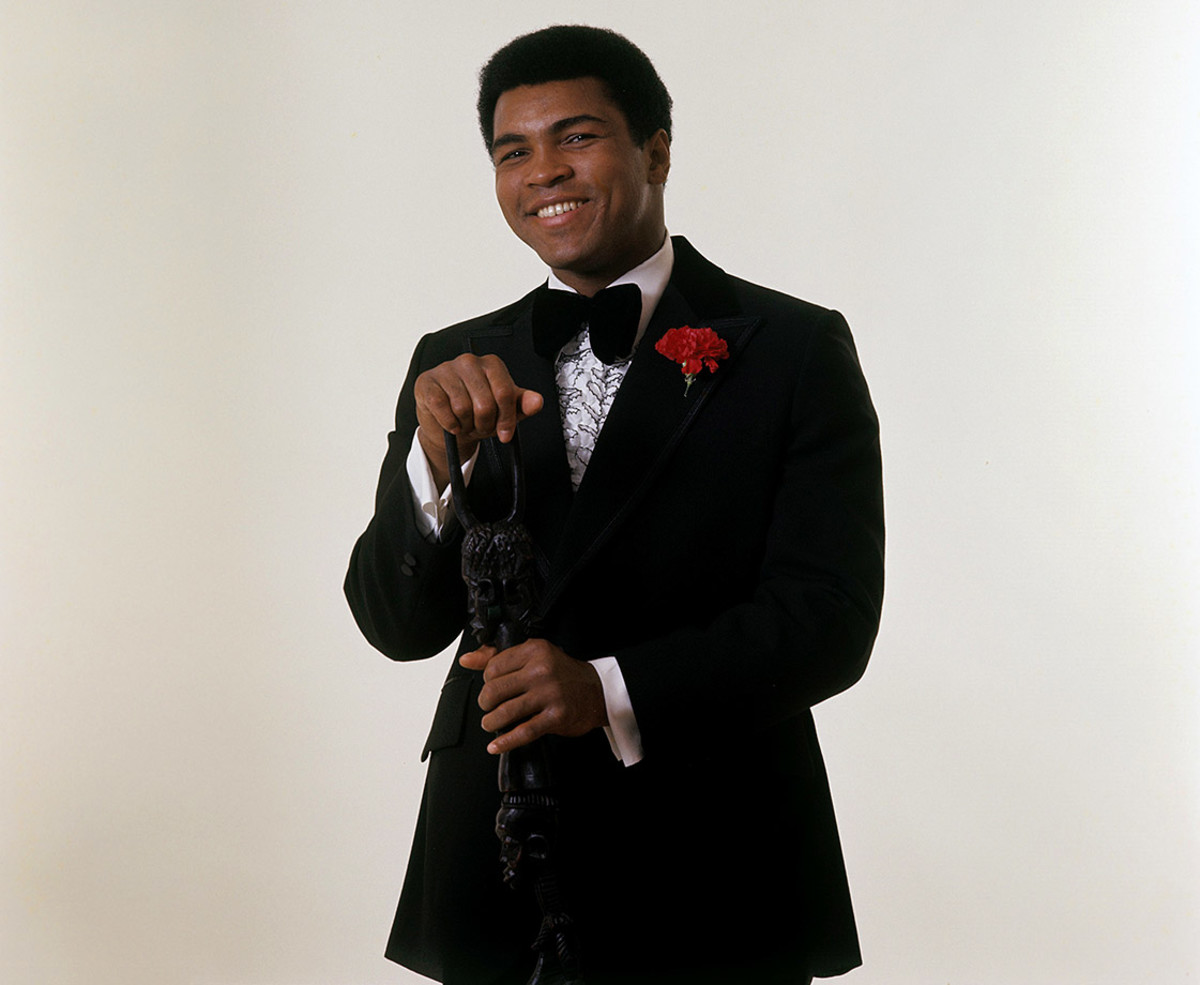
This time Ali wears a tuxedo, but keeps the walking stick, during the November photo shoot for Sports Illustrated's Sportsman of the Year.
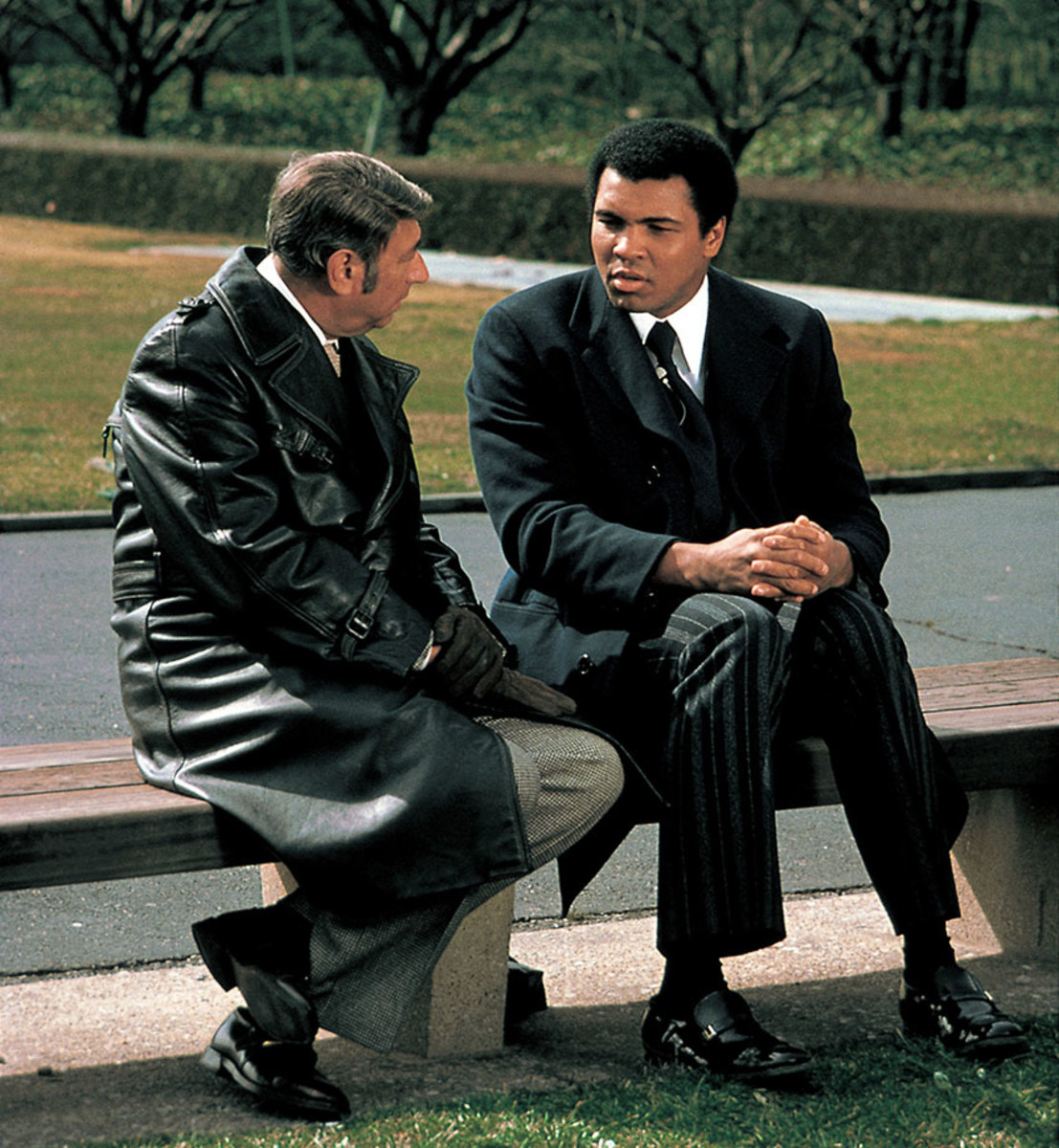
Ali talks with Howard Cosell outside of the United Nations Headquarters for a segment on the Wide World of Sports. Later that day, Ali held a press conference to announce that he would donate part of the proceeds from his fight against Chuck Wepner to help Africans in the Sahel drought.
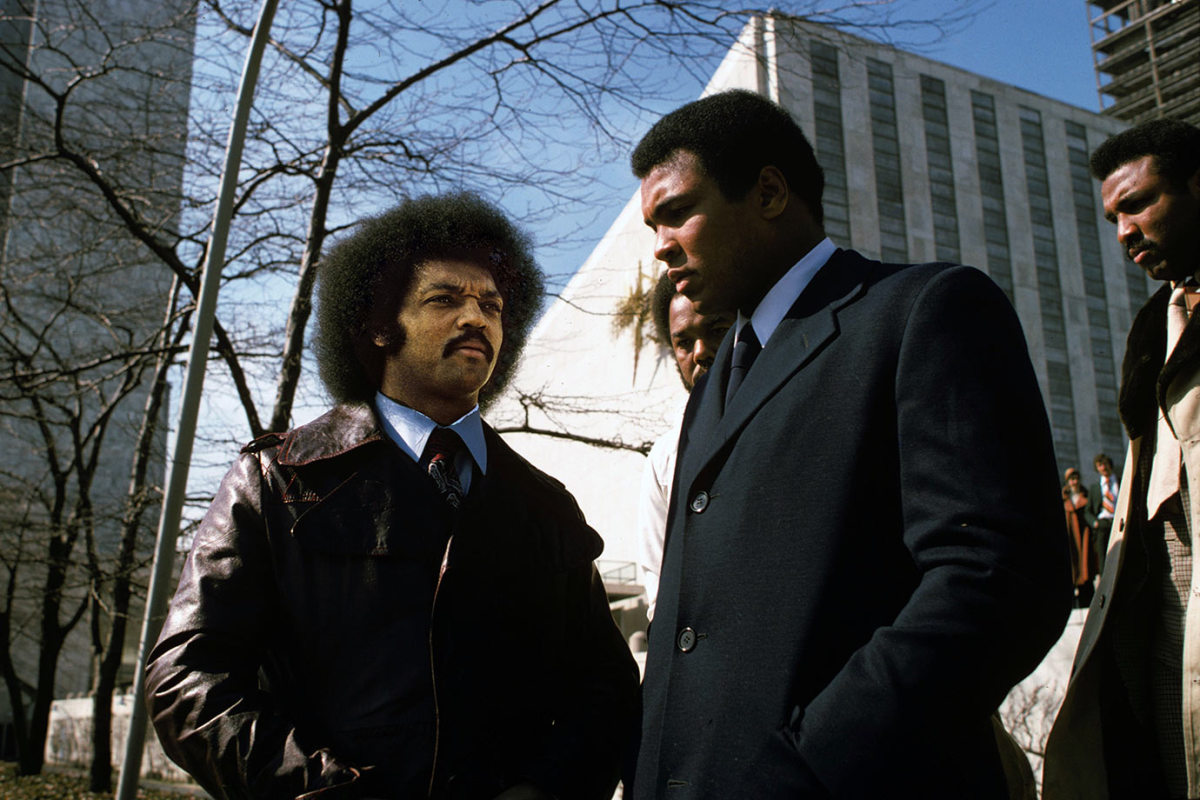
Ali talks with Reverend Jesse Jackson outside of the United Nations Headquarters before a press conference to announce that he would donate part of the proceeds from his fight against Chuck Wepner to help Africans in the Sahel drought.
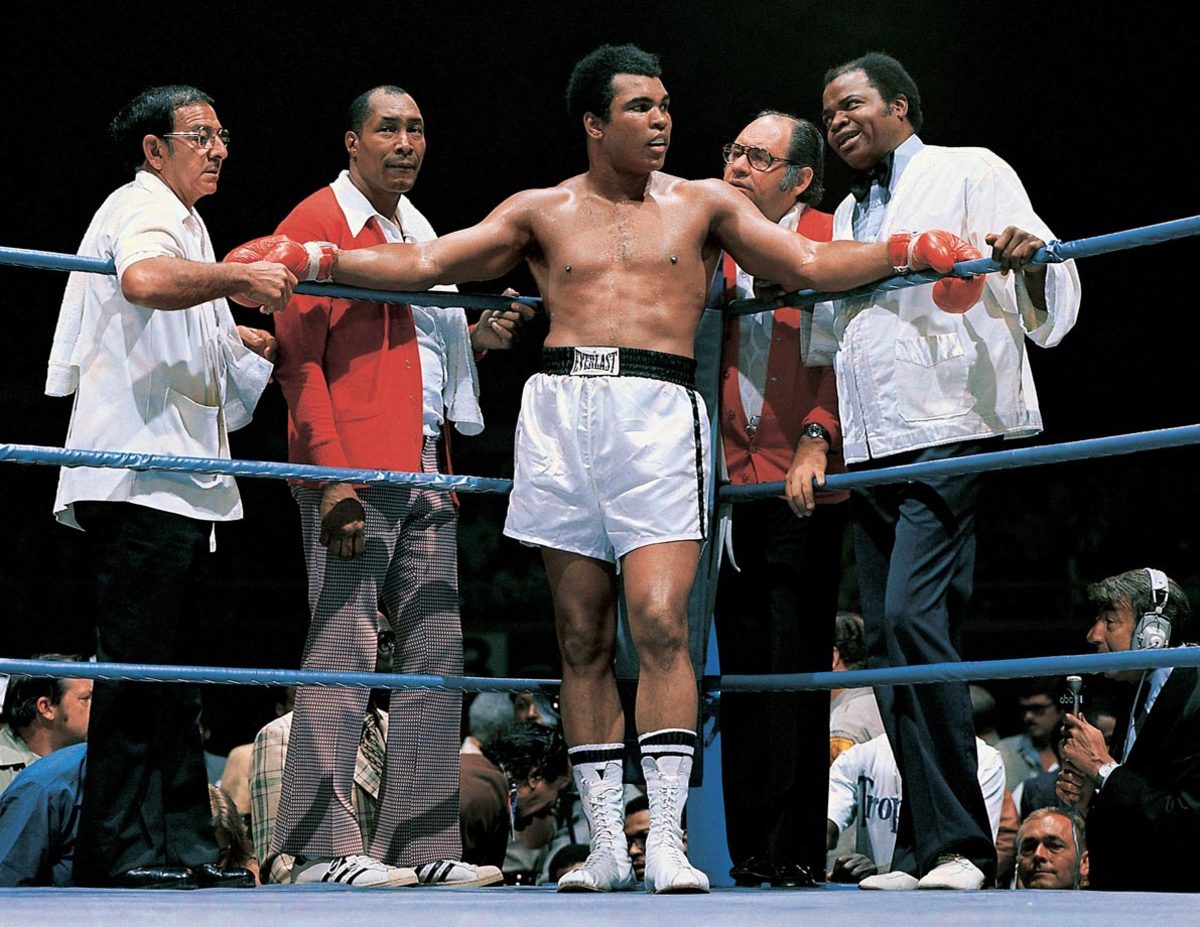
Ali stands with trainer Angelo Dundee, assistant trainer Wali Muhammad, physician Dr. Ferdie Pacheco and assistant trainer Drew Bundini Brown before his bout with Ron Lyle in May 1975. Ali won the fight by technical knockout in the 11th round.
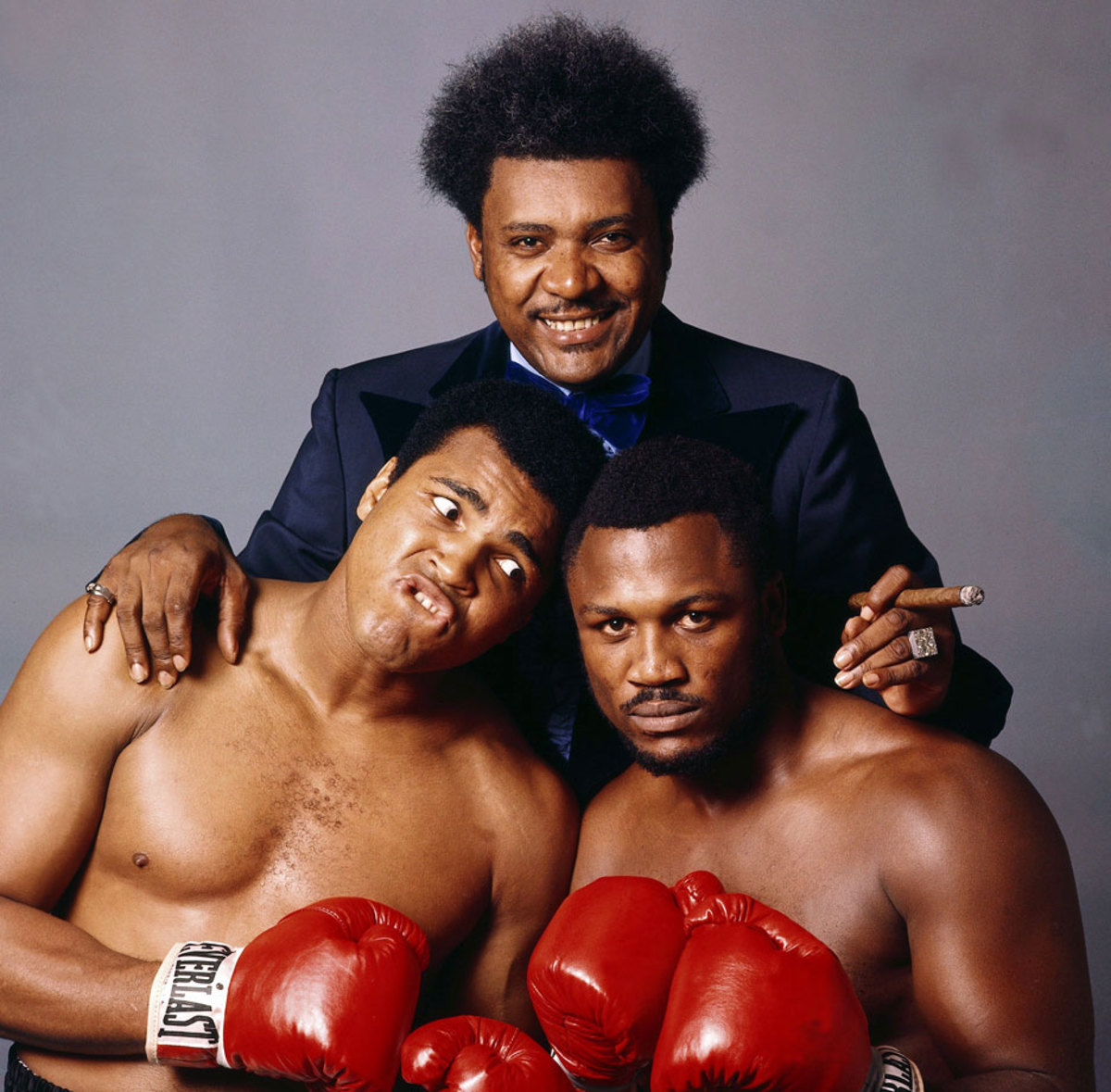
Along with Don King and Joe Frazier, Ali sat for a portrait leading up to the Thrilla in Manila. Ali verbally abused Frazier during the buildup to the fight, telling the media that "it will be a killa and a thrilla and a chilla when I get the gorilla in Manila."
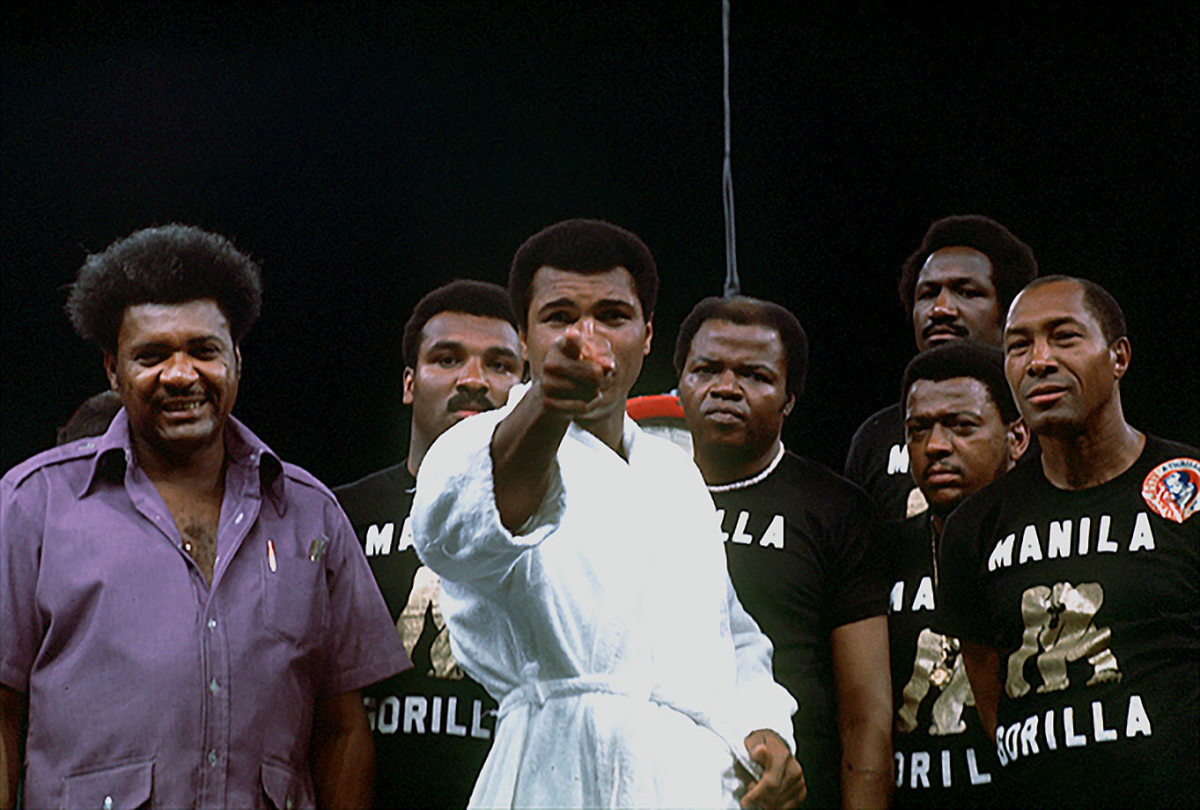
Ali points at the camera with Don King and his training staff behind him before the weigh-in for the Thrilla in Manila in October 1975. Philippine president Ferdinand Marcos offered to sponsor the bout and hold it in Metro Manila to divert attention from the turmoil in the country that had forced the imposition of martial law in 1972.
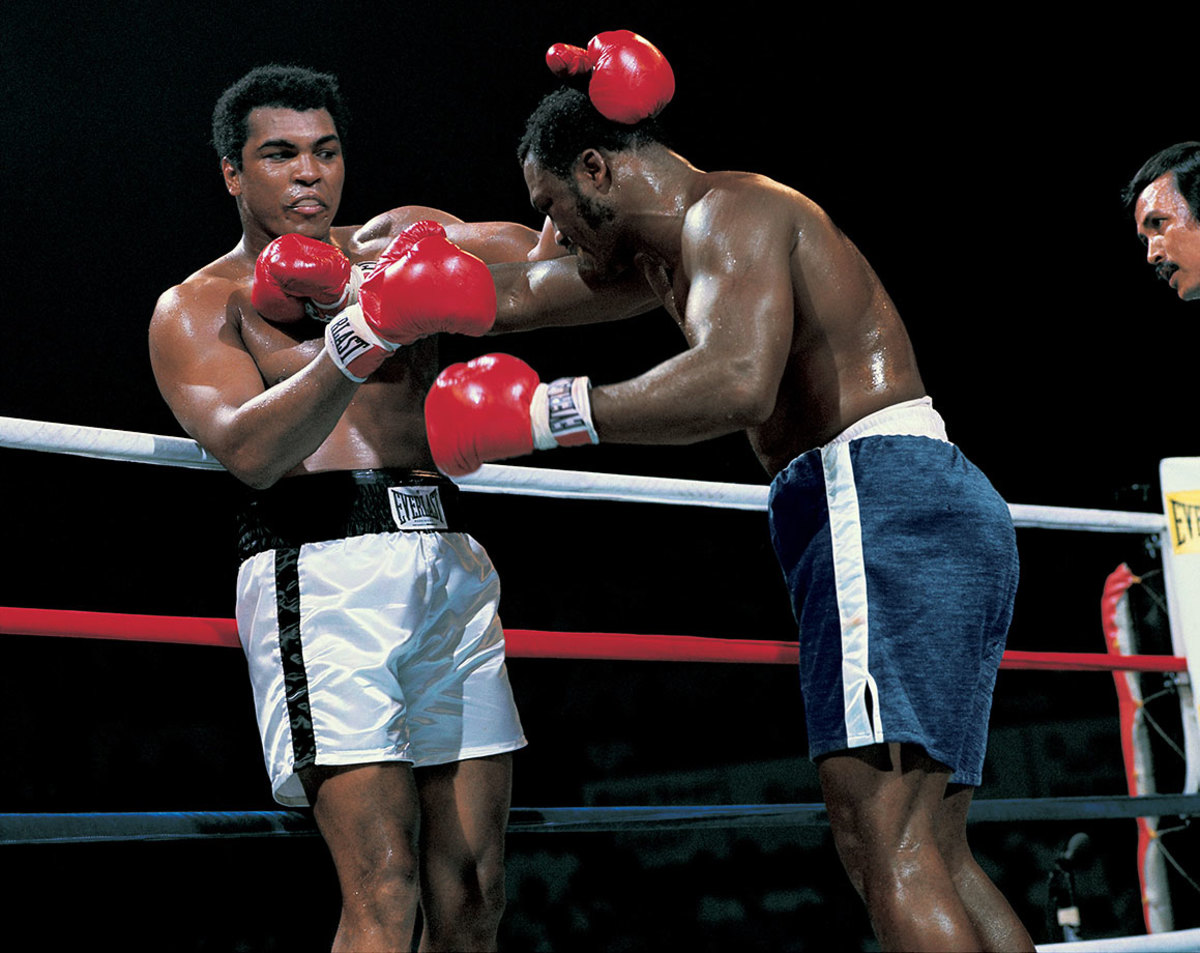
Wrapping up Joe Frazier proved more difficult than Ali expected, having thought Frazier would represent an easy payday and be unable to live up to his billing. The fight turned out to be a brutal affair.
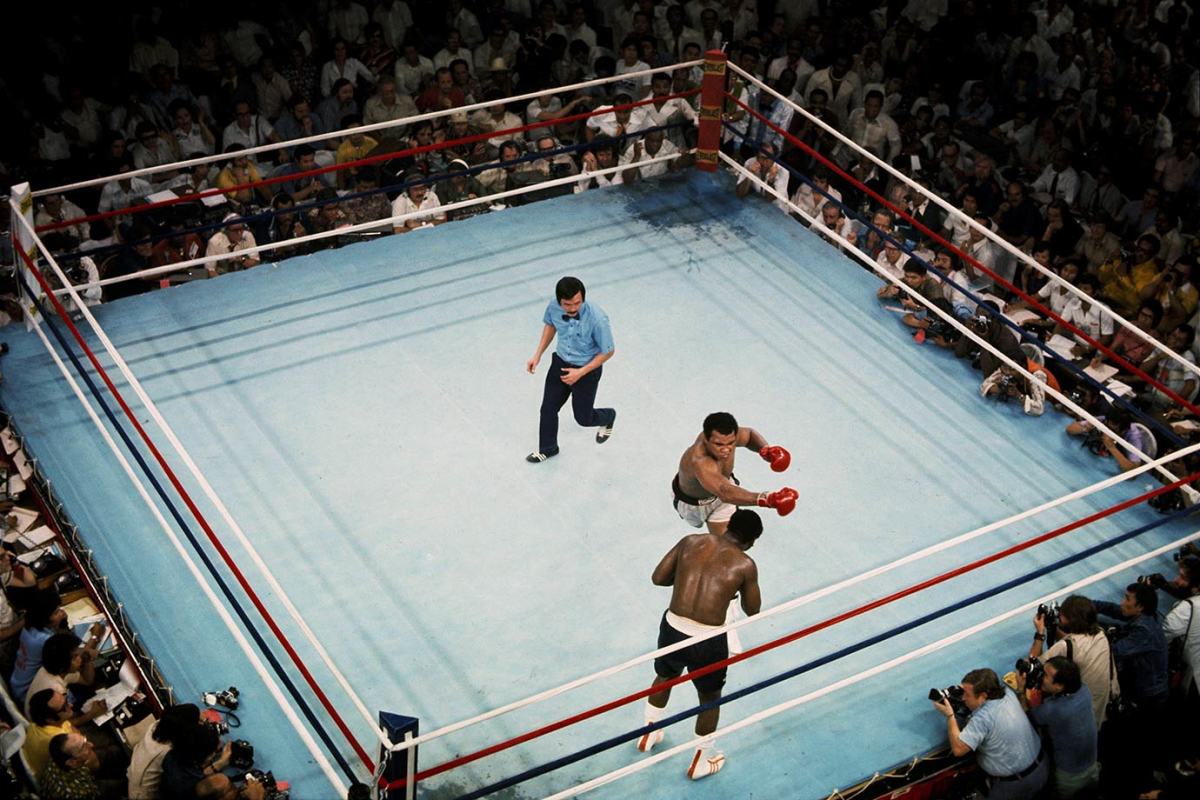
Frazier faces an Ali right hook in their fight in Quezon City, Philippines. The two fighters traded vicious blows during their 14 rounds. "Man, I hit him with punches that'd bring down the walls of a city," Frazier said. Ali withstood the blows to win by TKO in the 15th round.
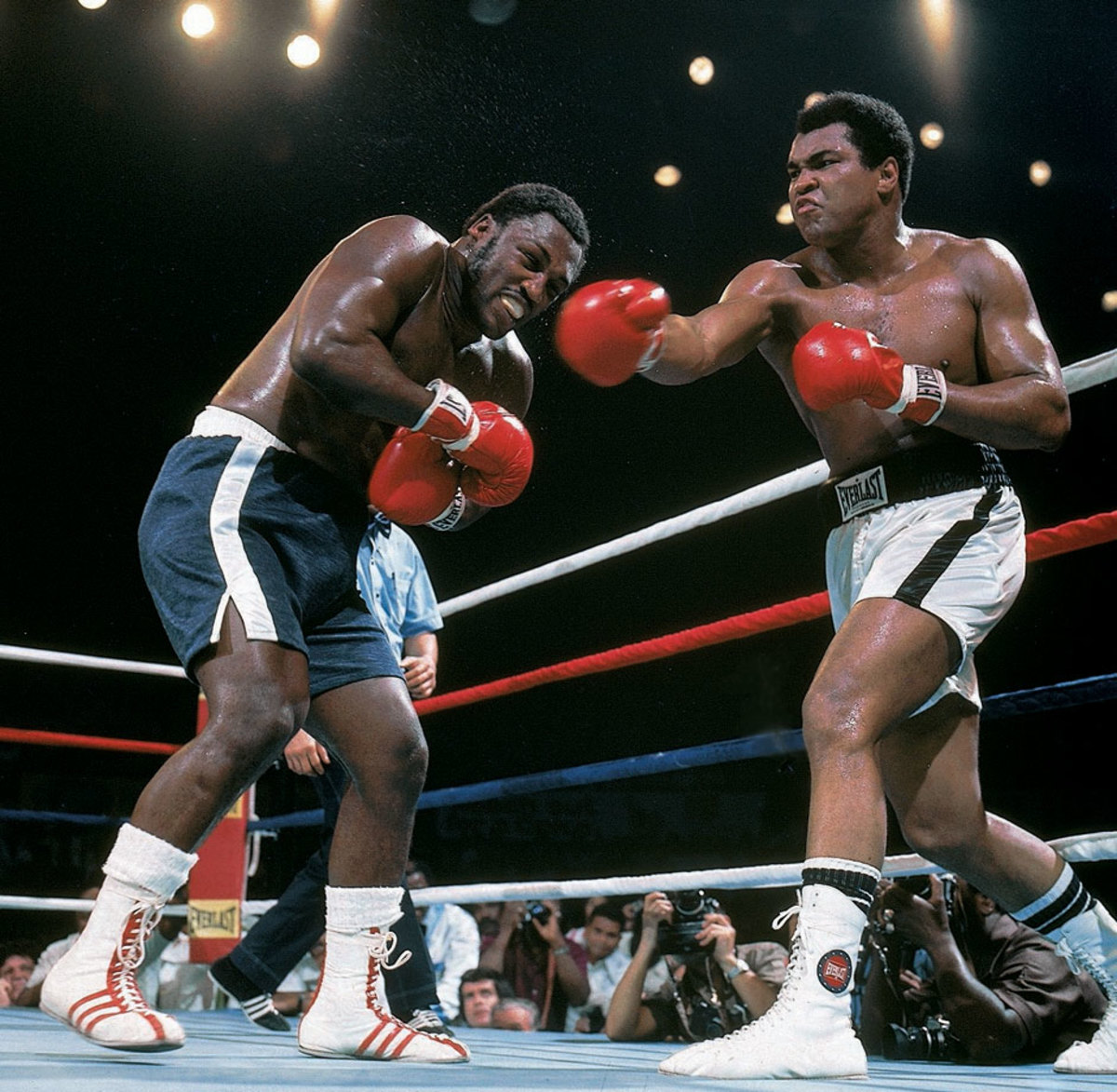
The third fight between Ali and Frazier, Ali won the bruising battle between the two powerful punching heavyweights when Frazier's trainer, Eddie Futch, stopped the fight before the 15th round.
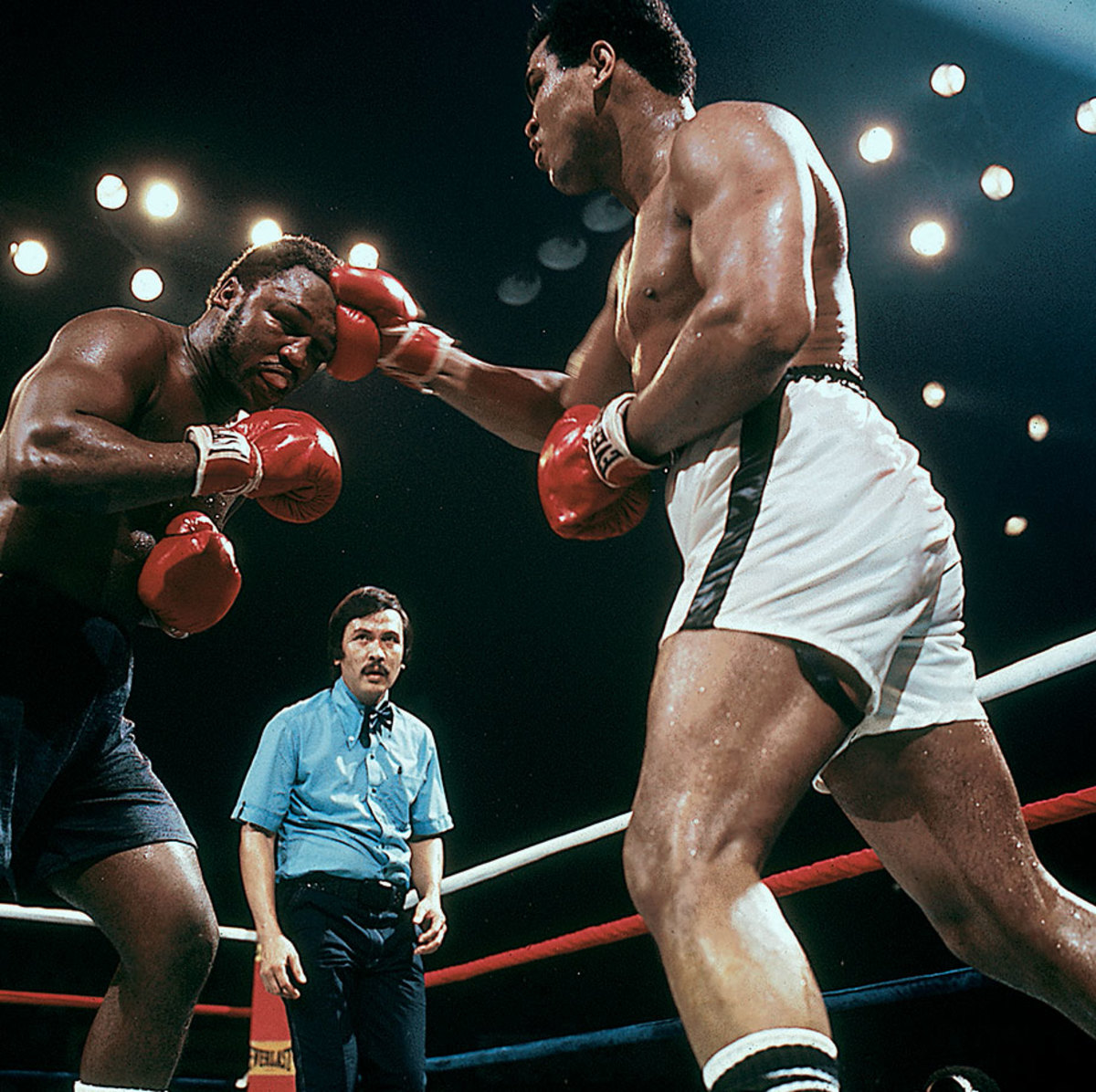
A back and forth exchange, Ali controlled the early rounds of the Thrilla in Manila before Frazier fought back with powerful hooks. Ali finished strong, regaining momentum in the later rounds.
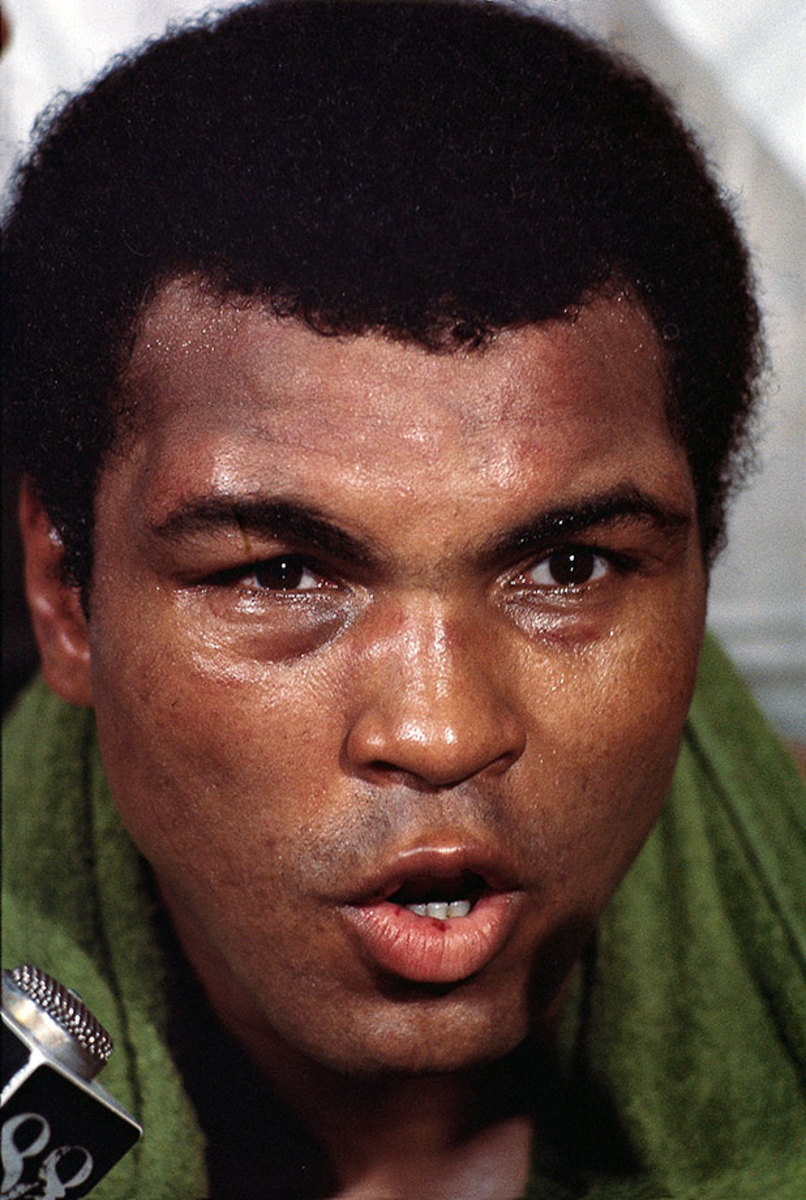
Ali speaks to the press after winning the Thrilla in Manila bout with Frazier.
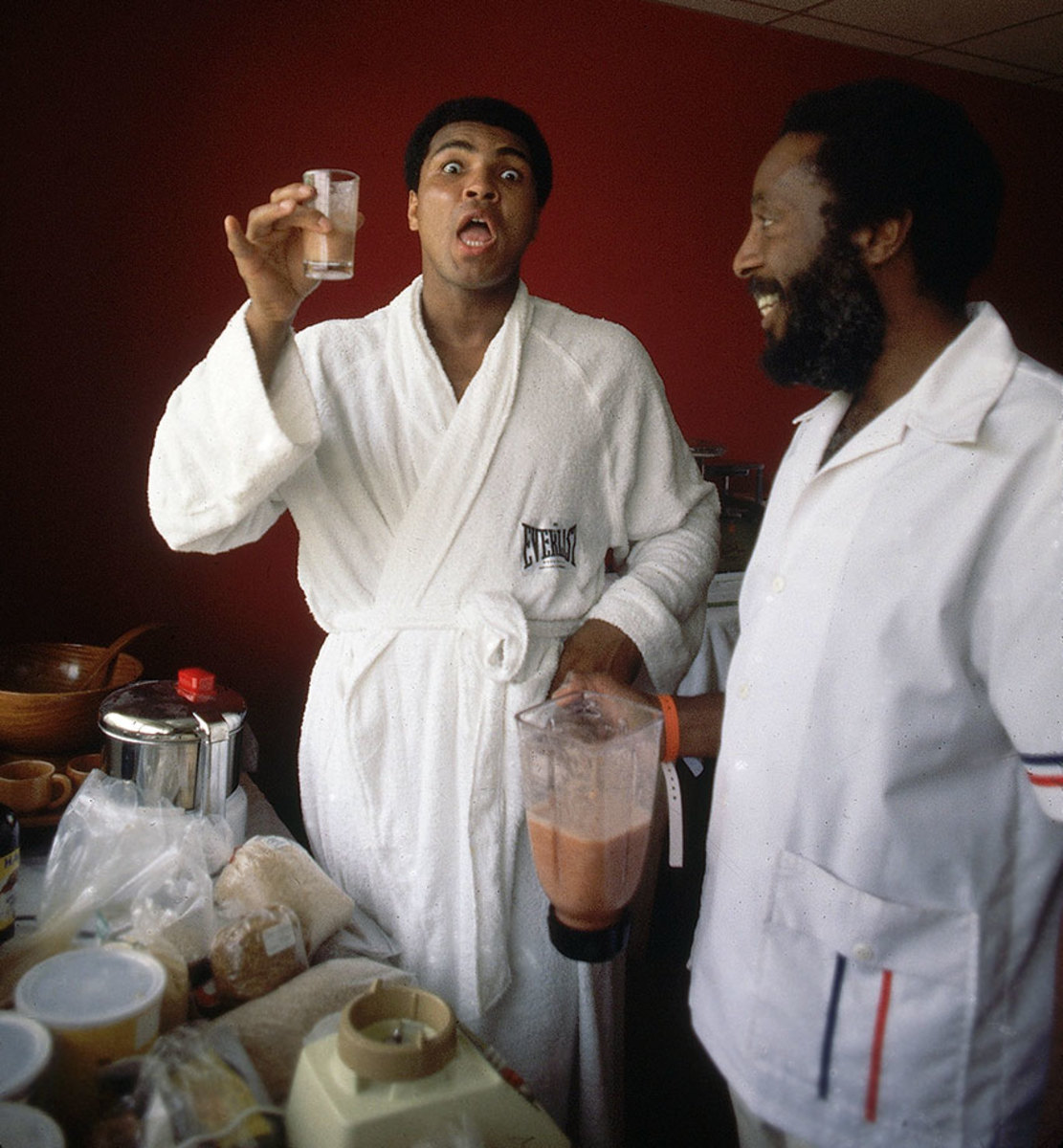
Ali holds a drinking concoction given to him by Dick Gregory, an advocate of a raw fruit and vegetable diet, in 1976.
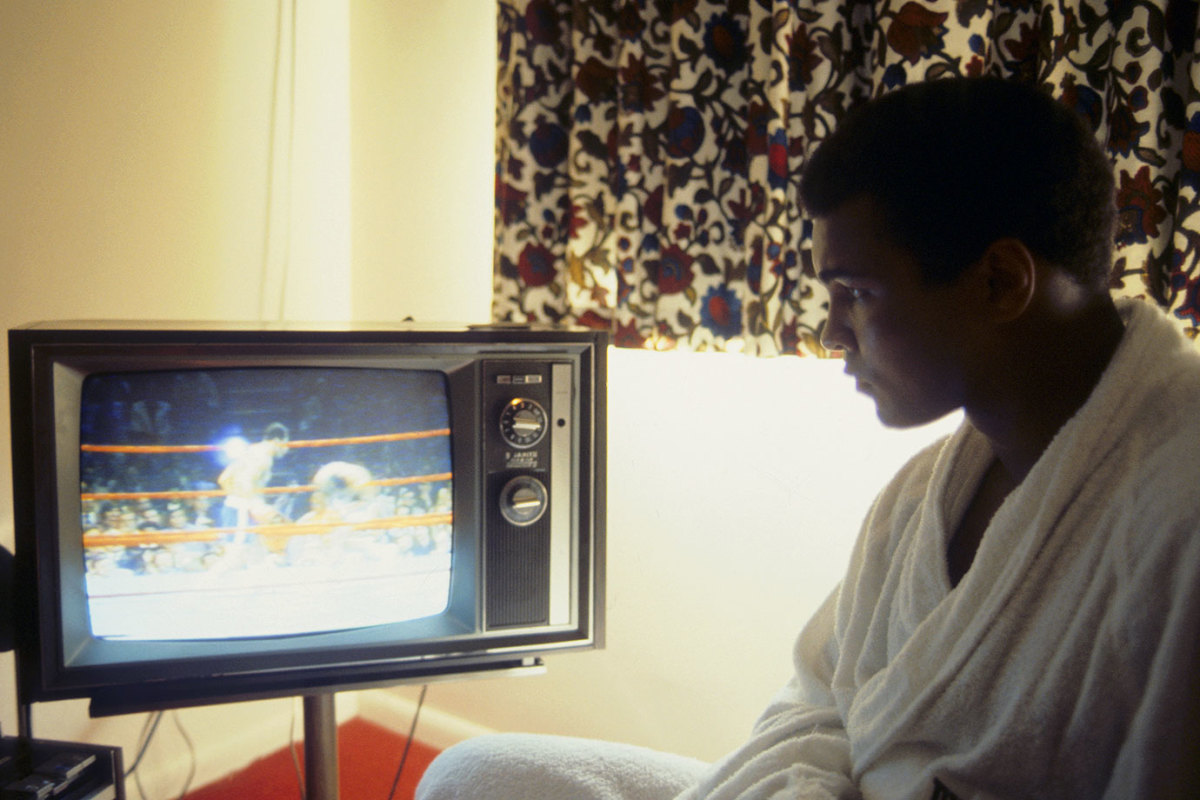
Before his 1976 fight against Ken Norton at Yankee Stadium, Ali watches a fight on television from his hotel room. A police strike at the time of the fight created a dangerous environment outside the stadium that all but eliminated walk-up sales.
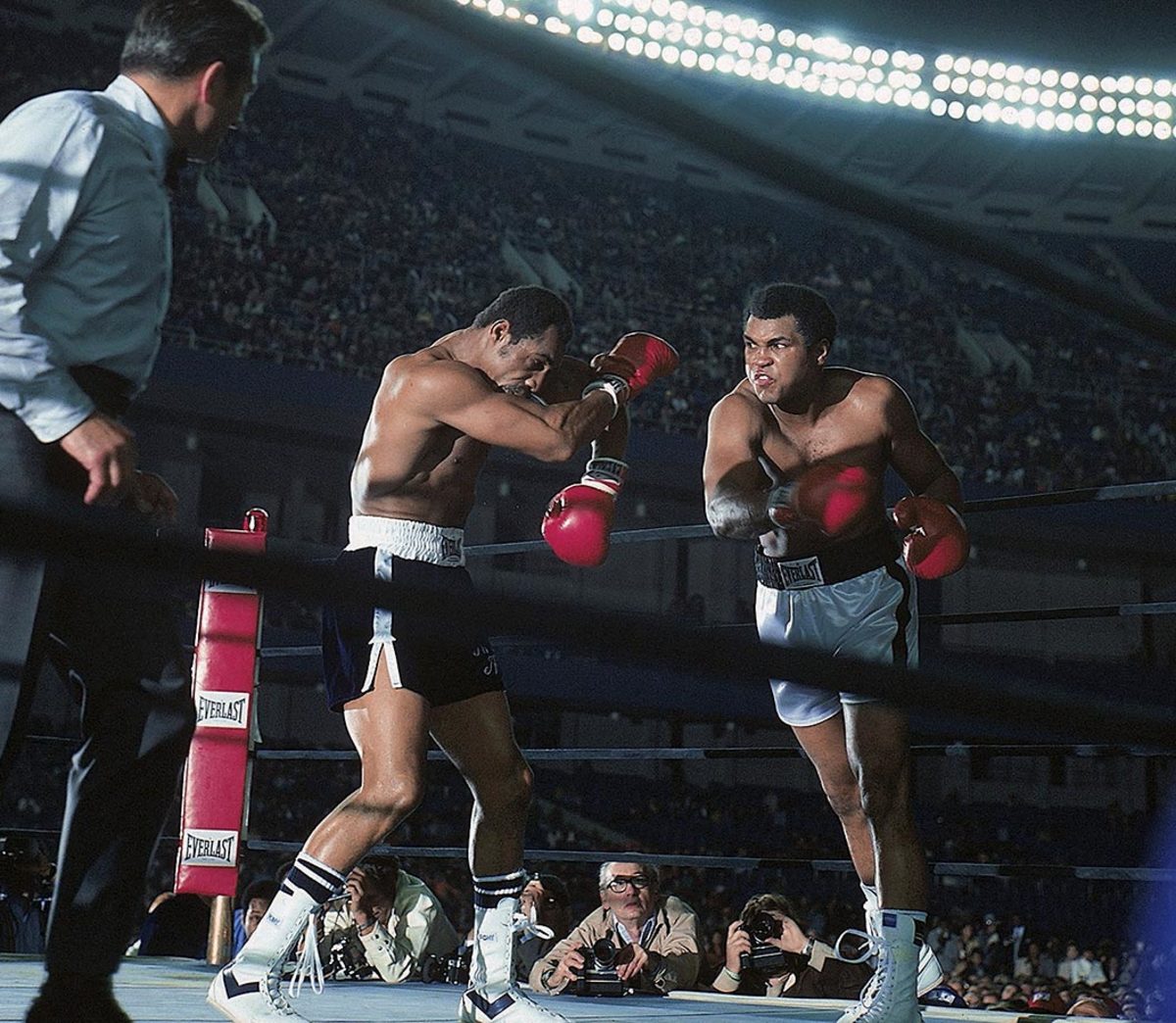
Norton takes a right hook during the heavyweight title fight against Ali. The bout, which Ali won by a unanimous, but controversial, decision, was the last boxing match at Yankee Stadium until 2010.
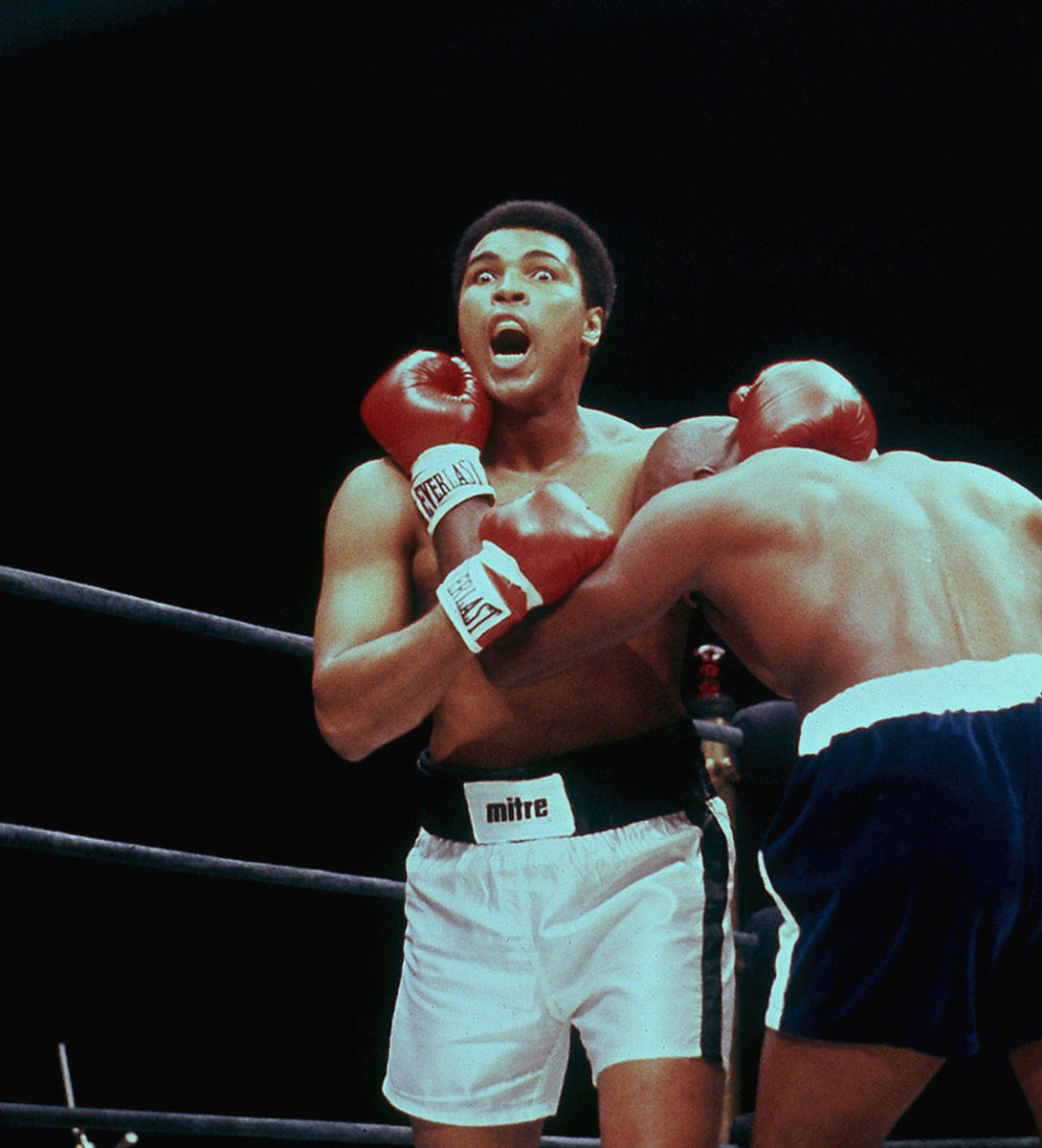
Ali makes a face during his fight with Earnie Shavers in 1977 at Madison Square Garden. Hurt badly by Shavers in the second round, Ali rebounded and outboxed Shavers throughout to build a lead on points before Shavers came on again in the later rounds. Seemingly exhausted going into the 15th and final round, Ali remained victorious by producing a closing flurry that left Shavers wobbling at the bell and the Garden crowd once again in delirium over his Ali magic.
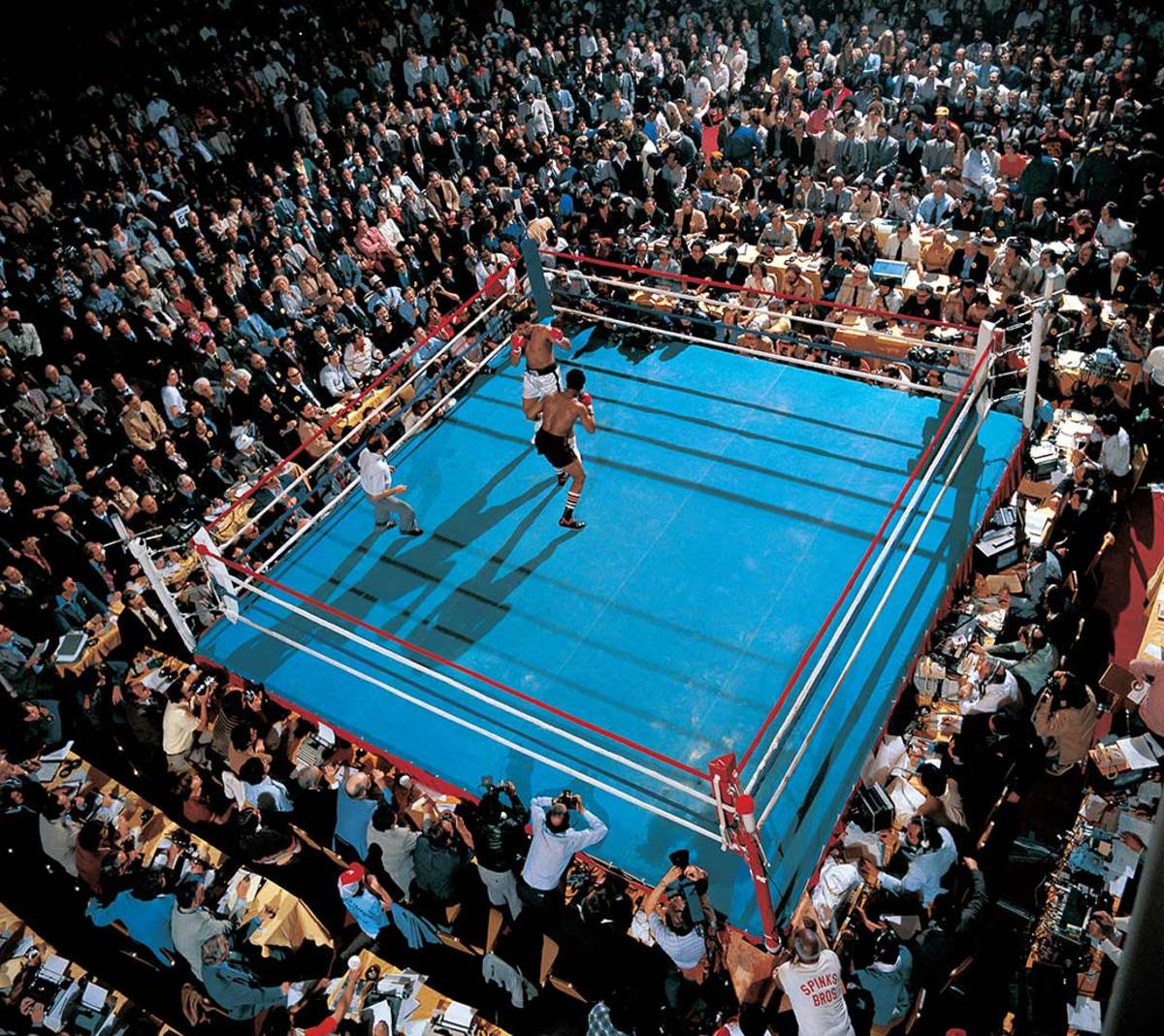
Ali squares off with Leon Spinks at the Las Vegas Hilton Hotel in February 1978. Spinks won the fight in a split decision, ending Ali's 3.5-year reign as the heavyweight champion. It was the only time in Ali's career that he lost his championship title in the ring.
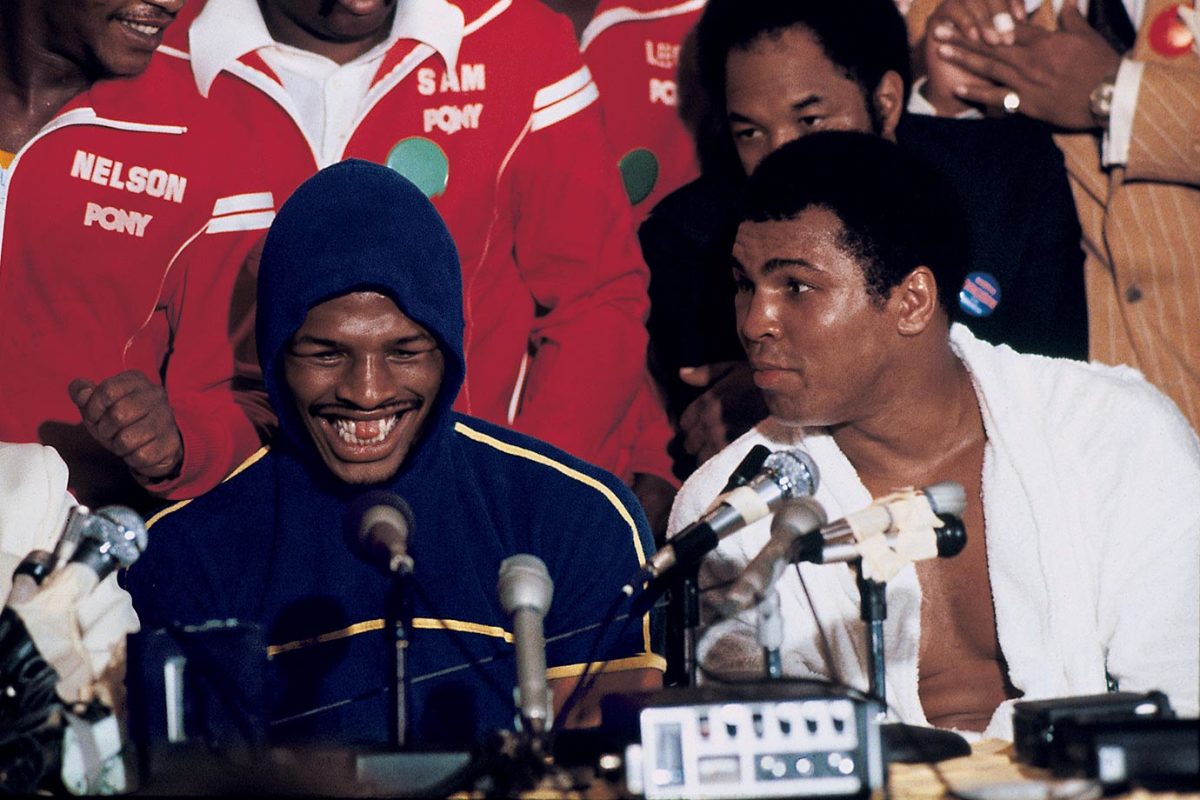
Leon Spinks took center stage over Ali at the press conference after their fight. The victorious Spinks and his gap-toothed grin were featured on the Feb. 19, 1978 cover of Sports Illustrated.
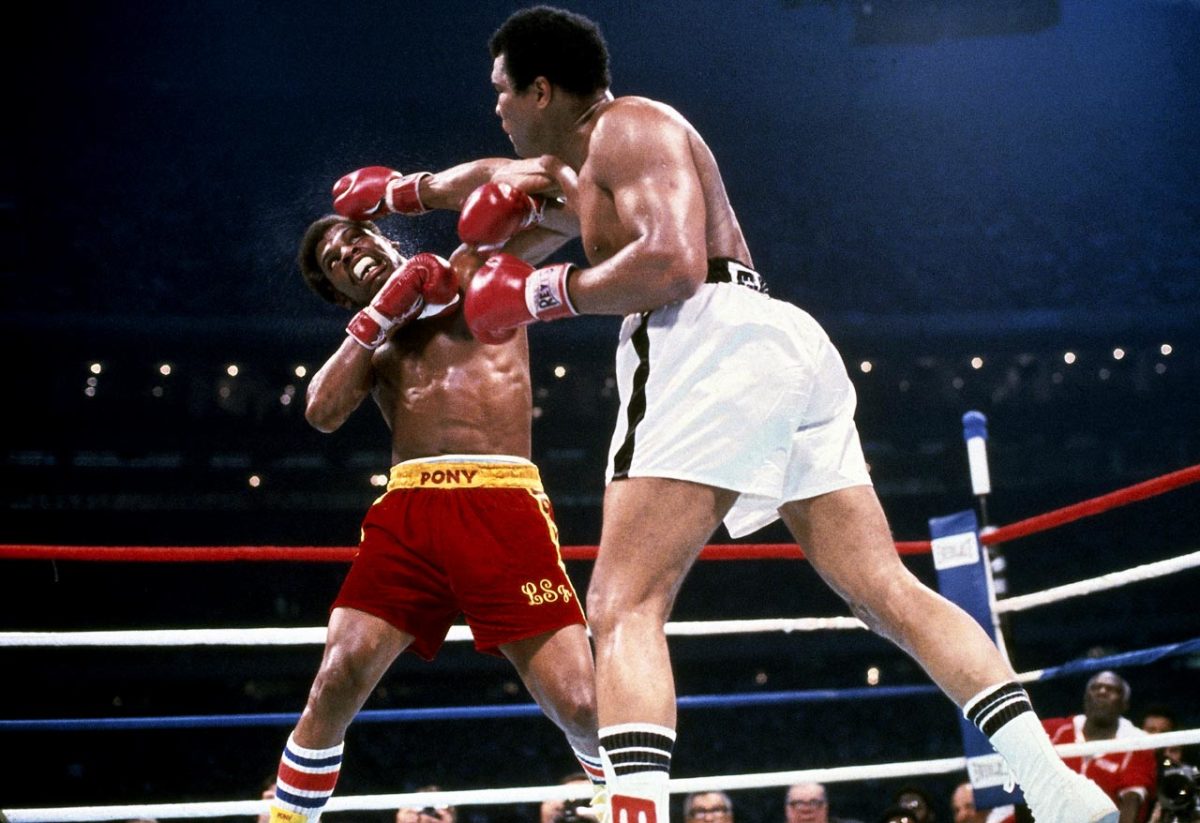
Ali lands a straight right hand to the head of Spinks in the rematch of their title bout in 1978. Ali won on a 15 round decision.
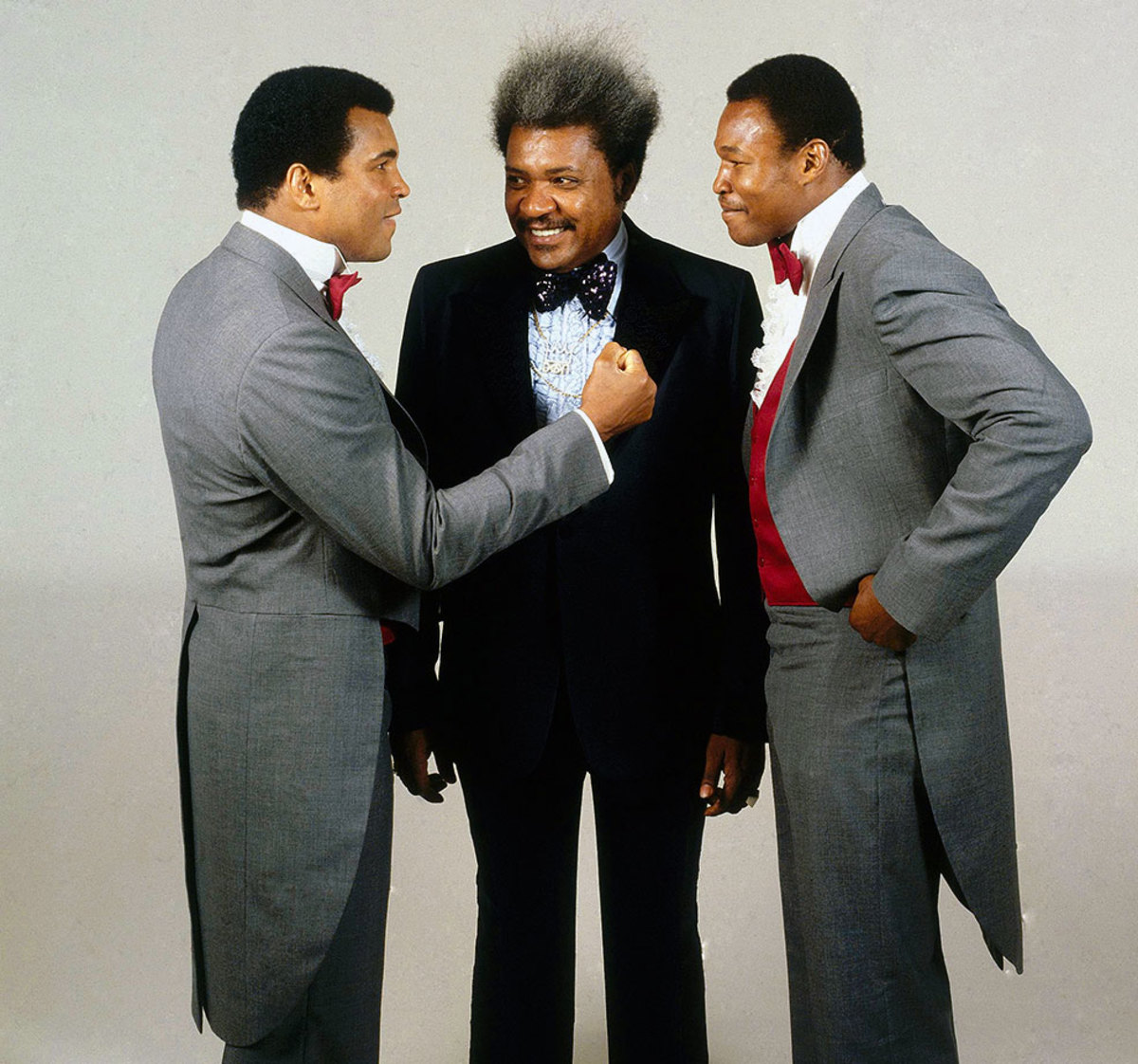
Don King pulled the strings again when Ali faced Larry Holmes before their November 1980 fight. King became a key figure in Ali's career, promoting his biggest fights, the Thrilla in Manila and the Rumble in the Jungle.
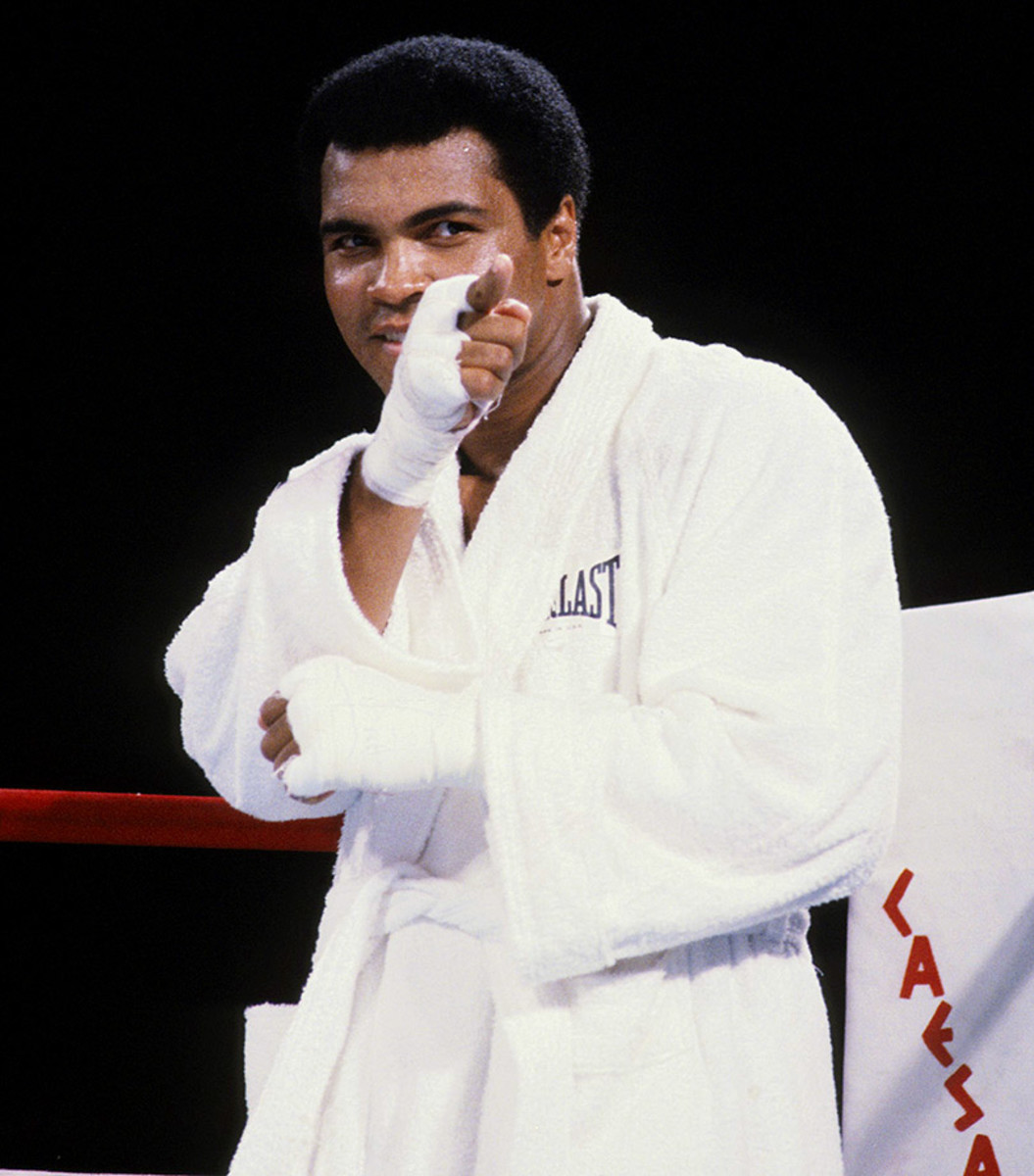
Ali points at Larry Holmes before their bout at Caesars Palace in 1980.
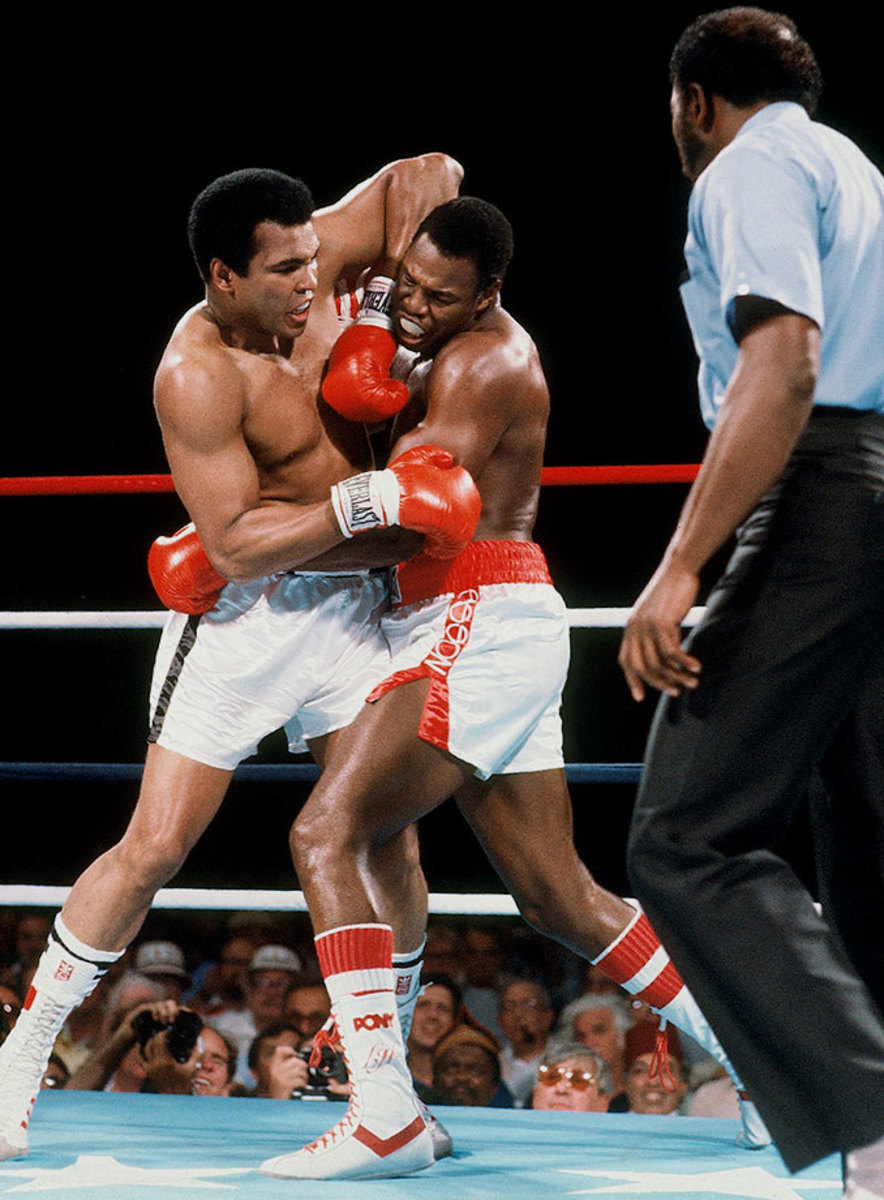
Ali grapples with Holmes during their bout in 1980. Trainer Angelo Dundee stopped the fight in the 11th round, marking the fight as Ali's only career loss by knockout.
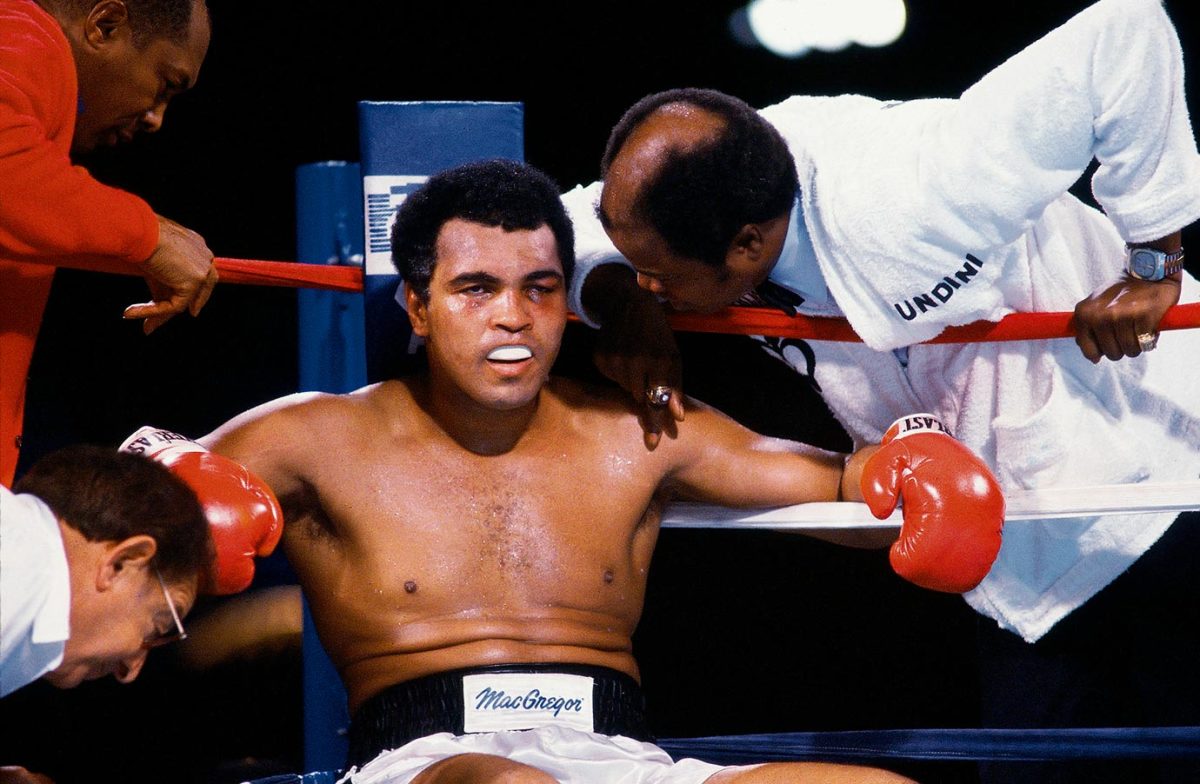
Drew Bundini Brown leans in to speak to Ali, who returned to fight Holmes after a brief retirement. By this time, Ali had already begun developing a vocal stutter and trembling hands and taken thyroid medication to lose weight that left him tired and short of breath.
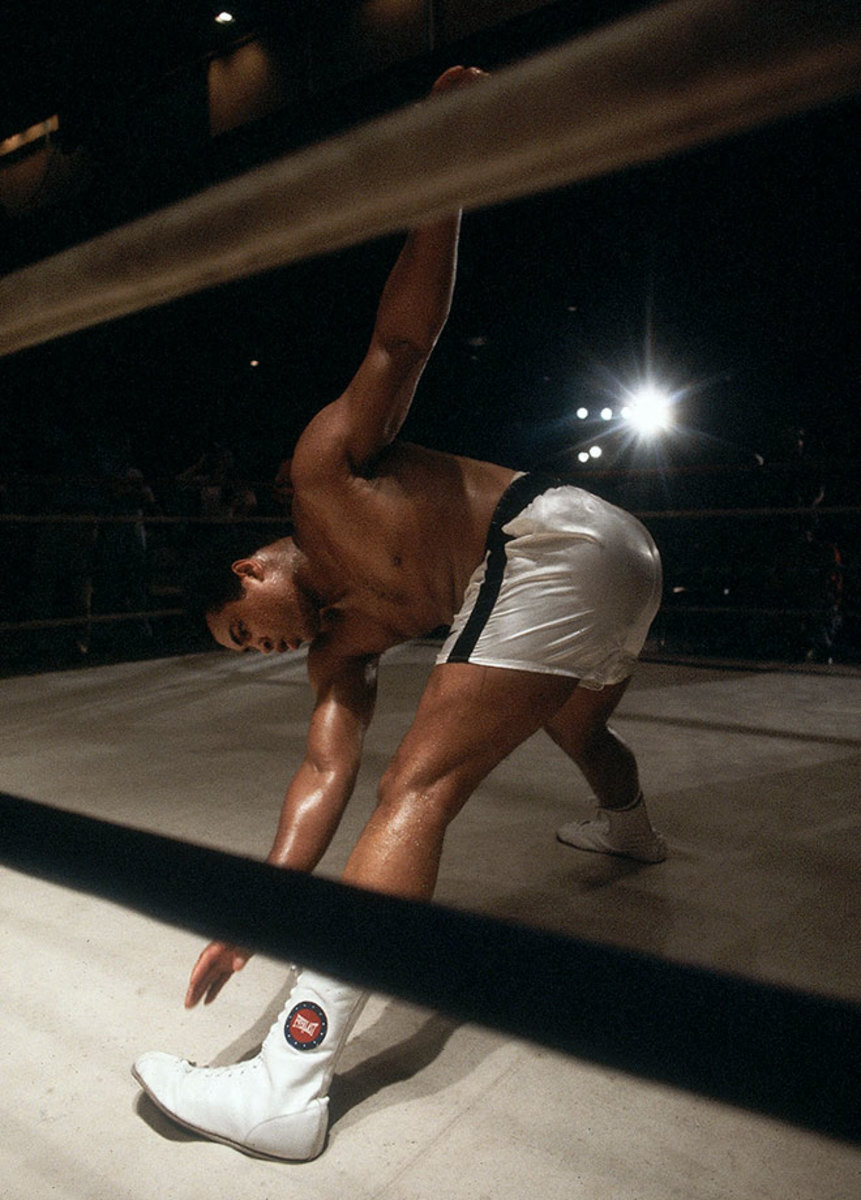
Ignoring pleas for his retirement, Ali stretches before a fight against Trevor Berbick in Nassau, Bahamas. Ali lost to Berbick in a unanimous decision and retired after the bout, the 61st of his career.
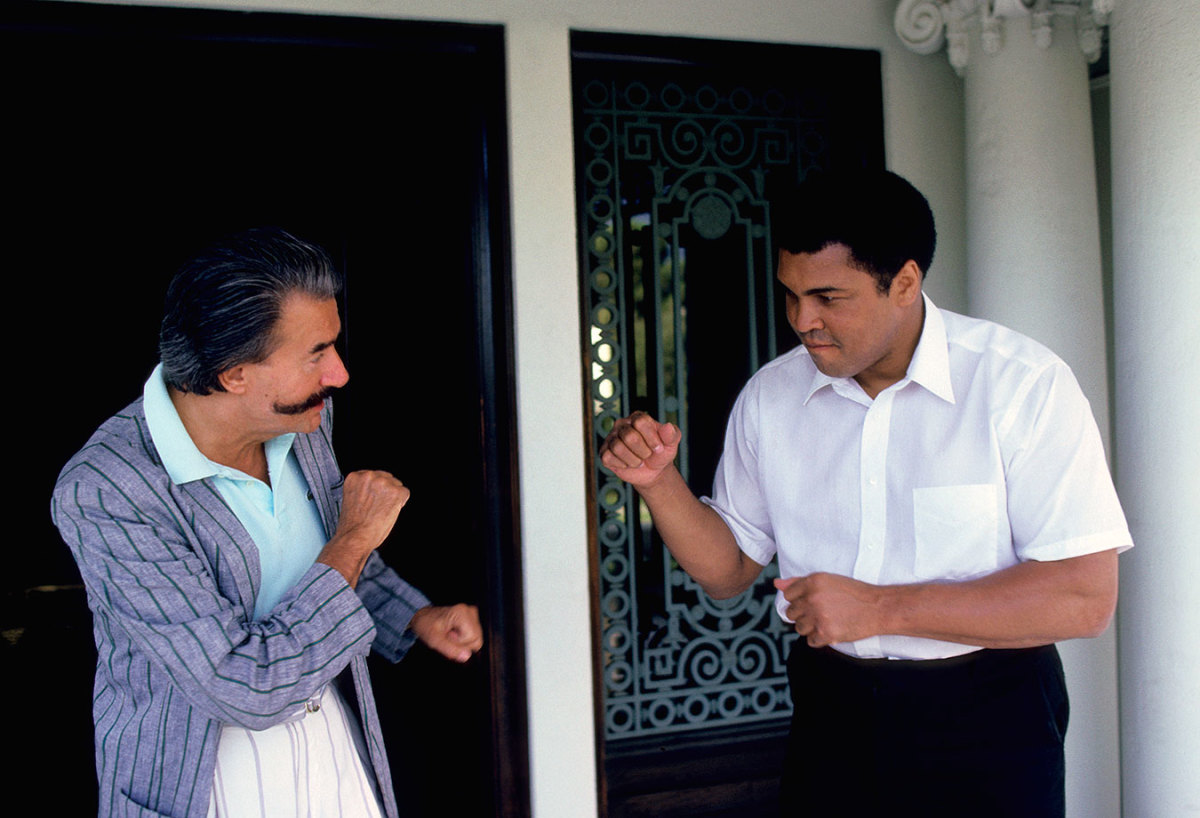
Ali pretends to spar with artist LeRoy Neiman at his home in Los Angeles. Neiman met Ali in 1962 and made many paintings and sketches from throughout Ali's life.
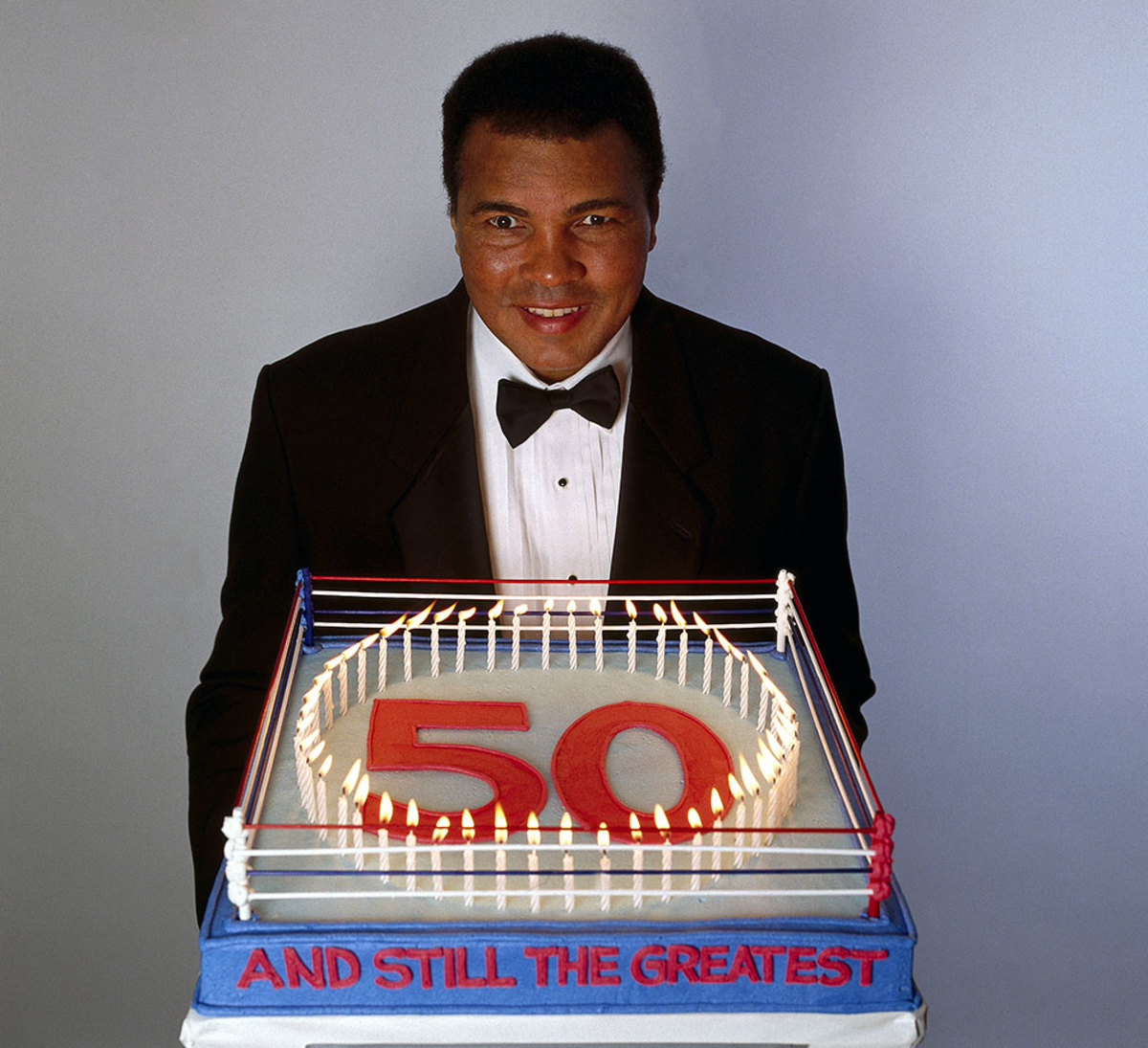
Cake in hand, Ali poses for a 50th birthday portrait in 1991. Although diagnosed with Parkinson's syndrome seven years earlier, Ali was still active, traveling to Iraq during the Gulf War to meet with Saddam Hussein in an attempt to negotiate the release of American hostages.
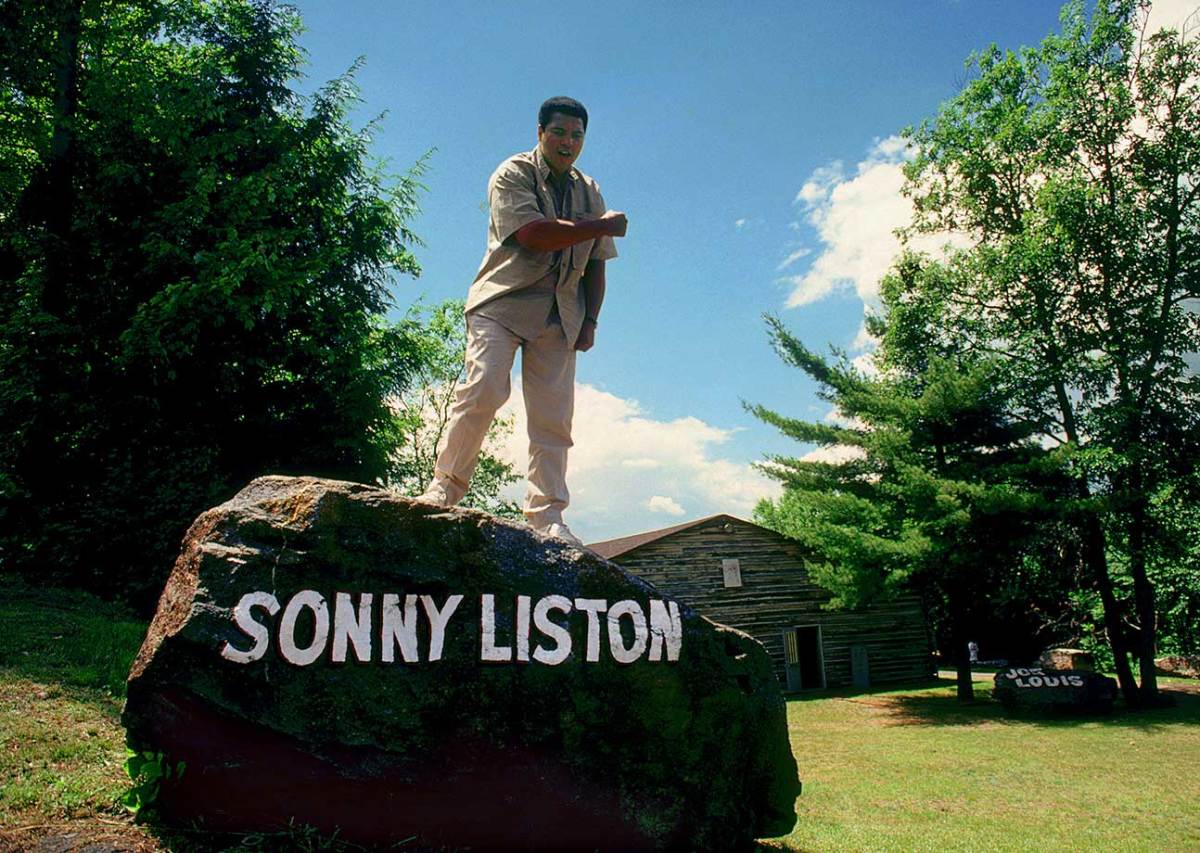
The same year, Ali stands atop of the Sonny Liston rock at his old training camp cabin. Ali and his father painted the names of famous boxers he admired on 18 boulders at the camp.
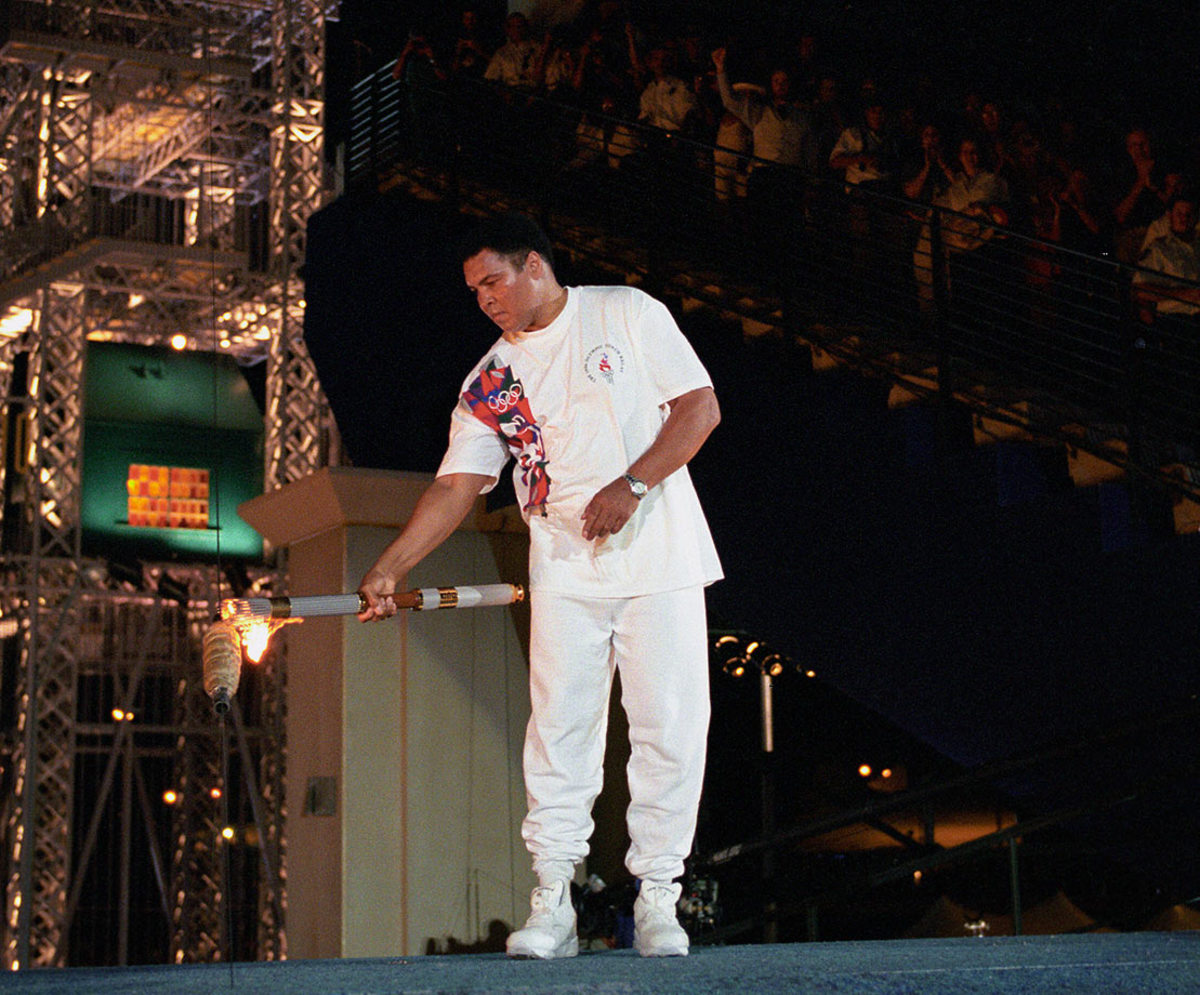
Ali carries the Olympic torch inside Centennial Olympic Stadium at the 1996 Atlanta Olympics. Despite trembling hands, Ali had the honor to light the Olympic flame in the stadium.
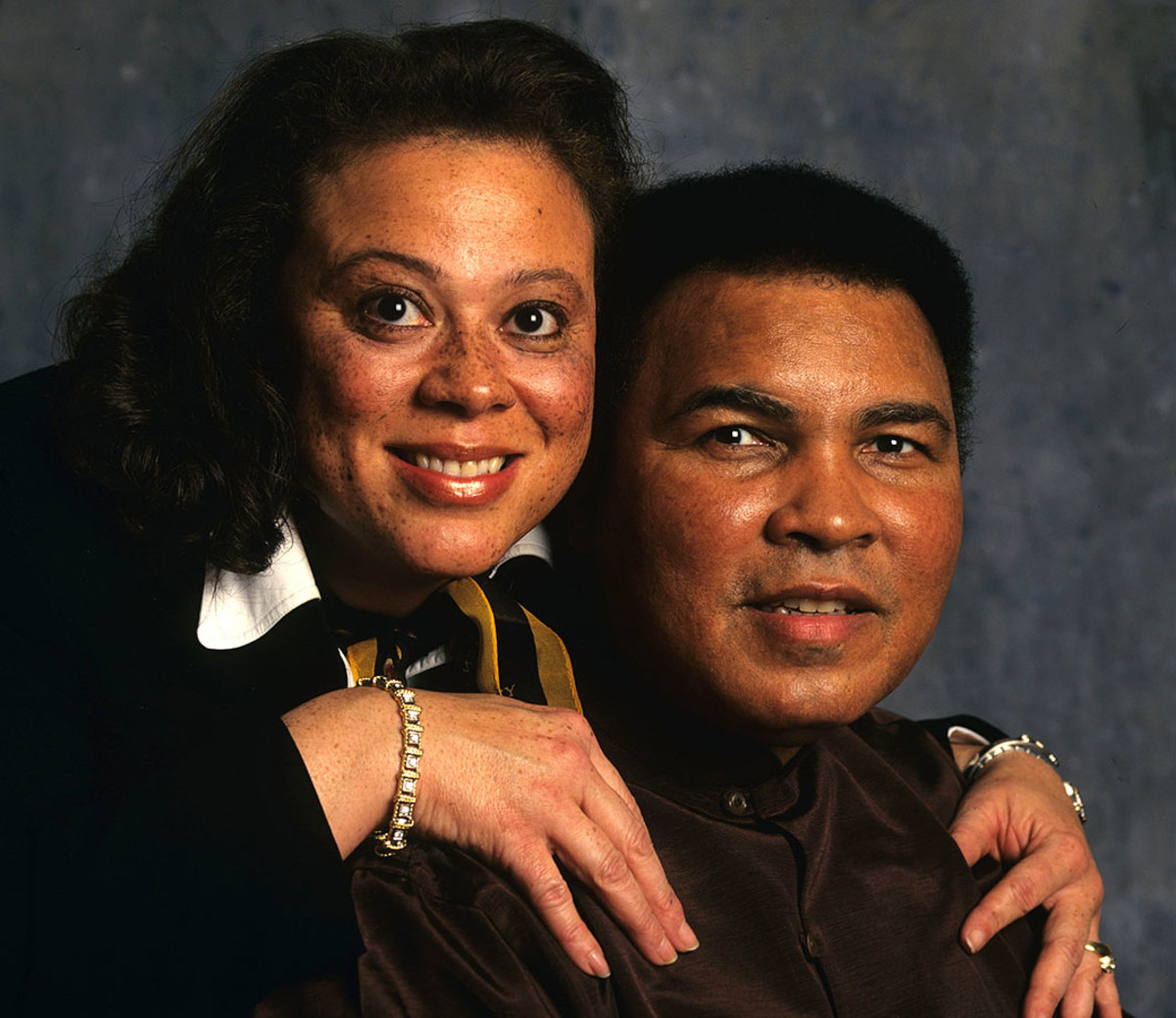
Husband and wife pose for a portrait during a photo shoot in 1997. Muhammad and Lonnie married in 1986 and have an adopted son together, Asaad Amin Ali.
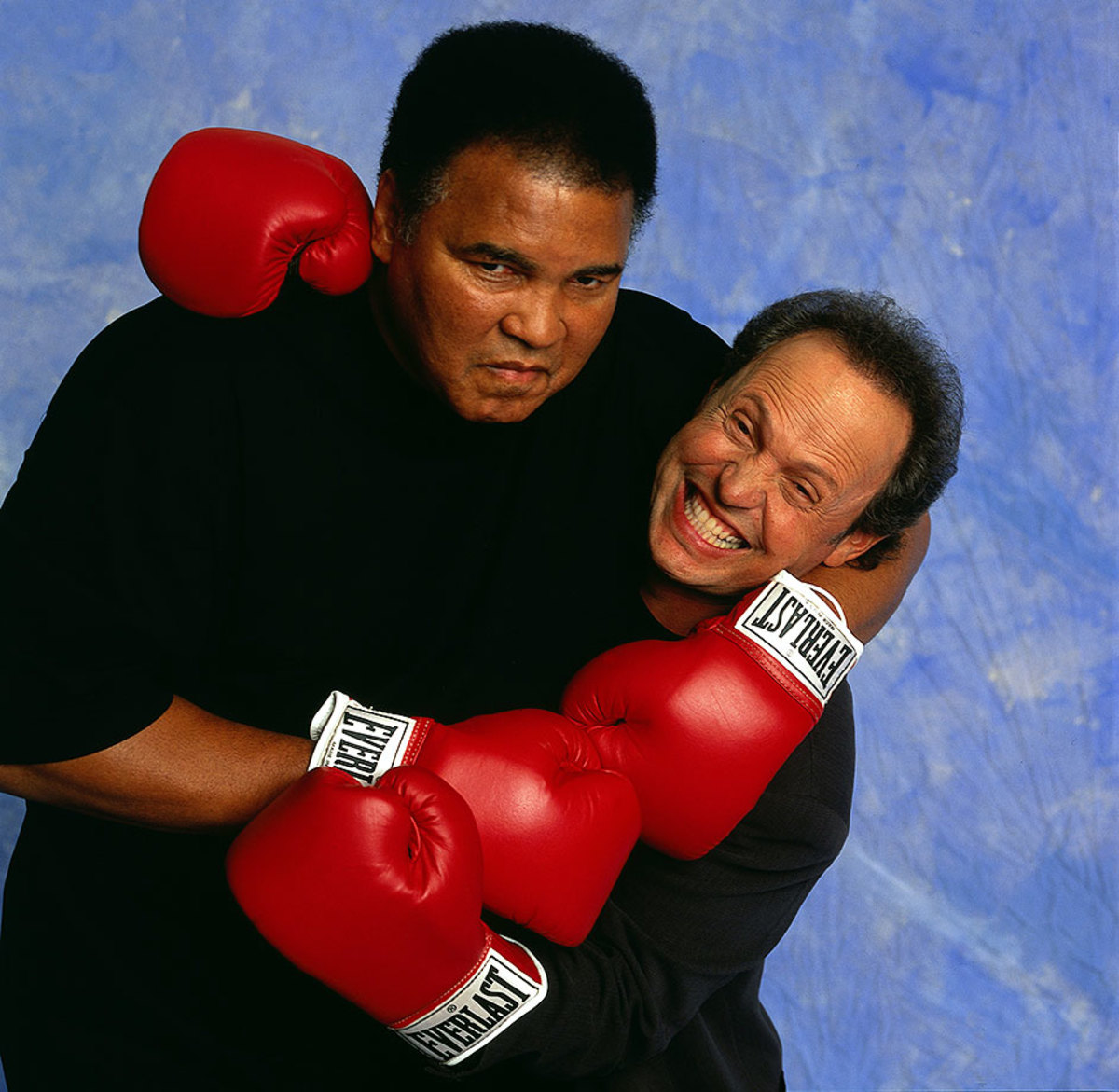
Ali messes around with actor Billy Crystal during a photo shoot in 2000. Crystal's impression of Ali was notorious, and he performed at a tribute to the boxer on his 50th birthday in December 1991.
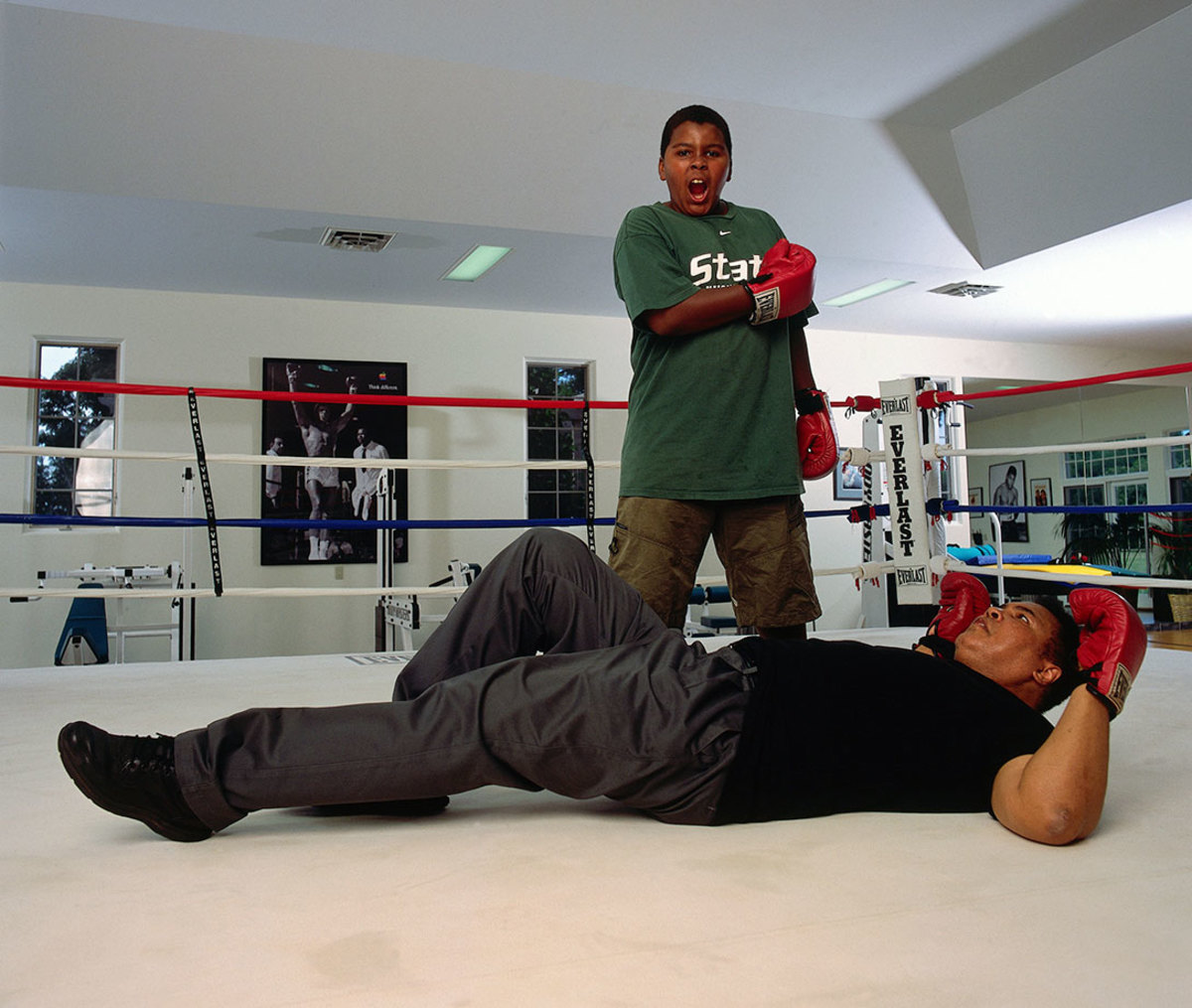
Ali lies on the canvas as his son, Assad Amin Ali, stands over him invoking memories of Ali's victory over Sonny Liston during a photo shoot in the gym at his farm on Kephart Road near Berrien Springs in 2001.
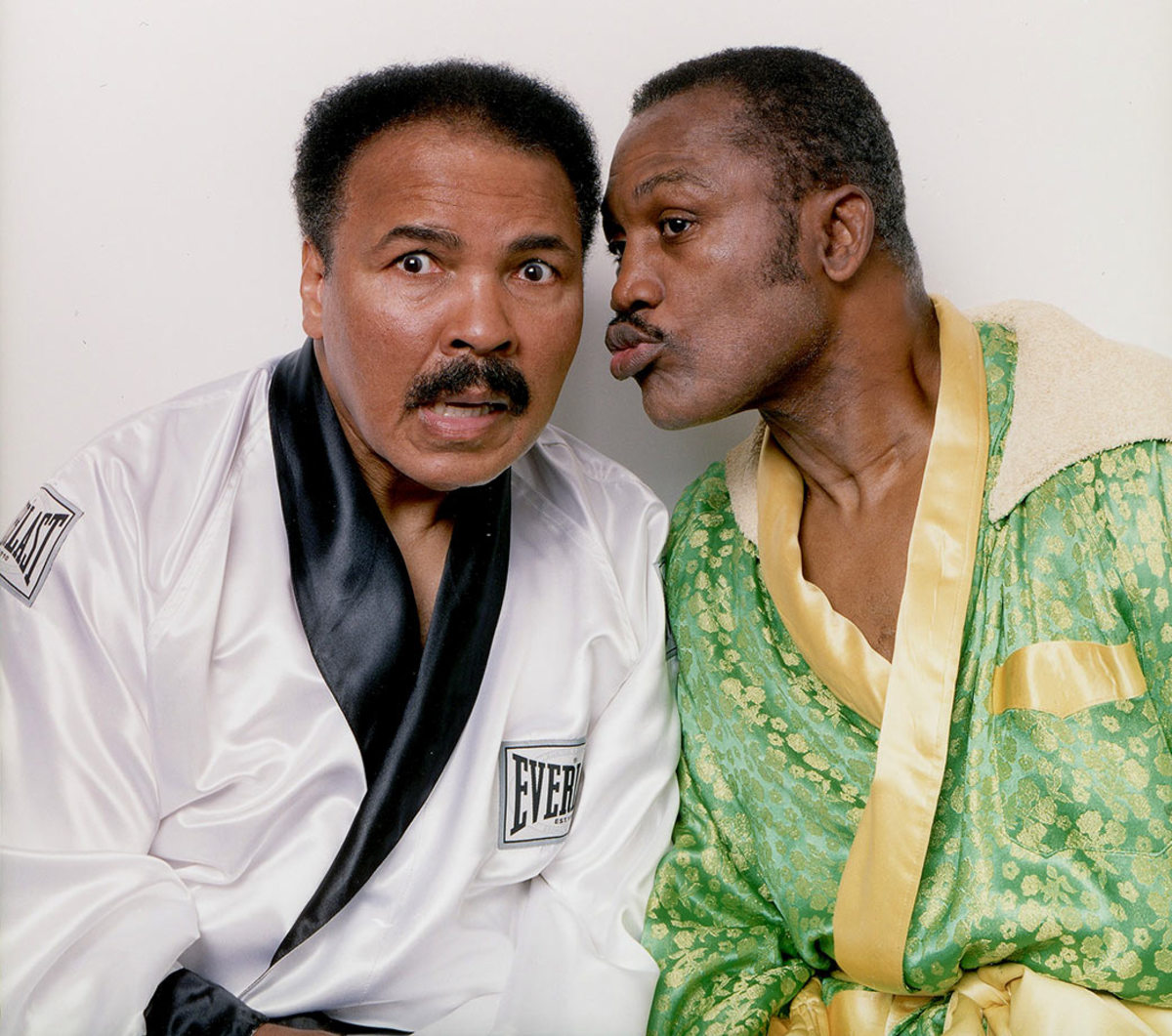
Fierce rivals in the ring, Ali and Joe Frazier pose for a portrait in the boxing robes they wore the night of their first bout at Frazier's Gym in 2003. Ali said after Frazier's death in 2011 that he was "a great champion."
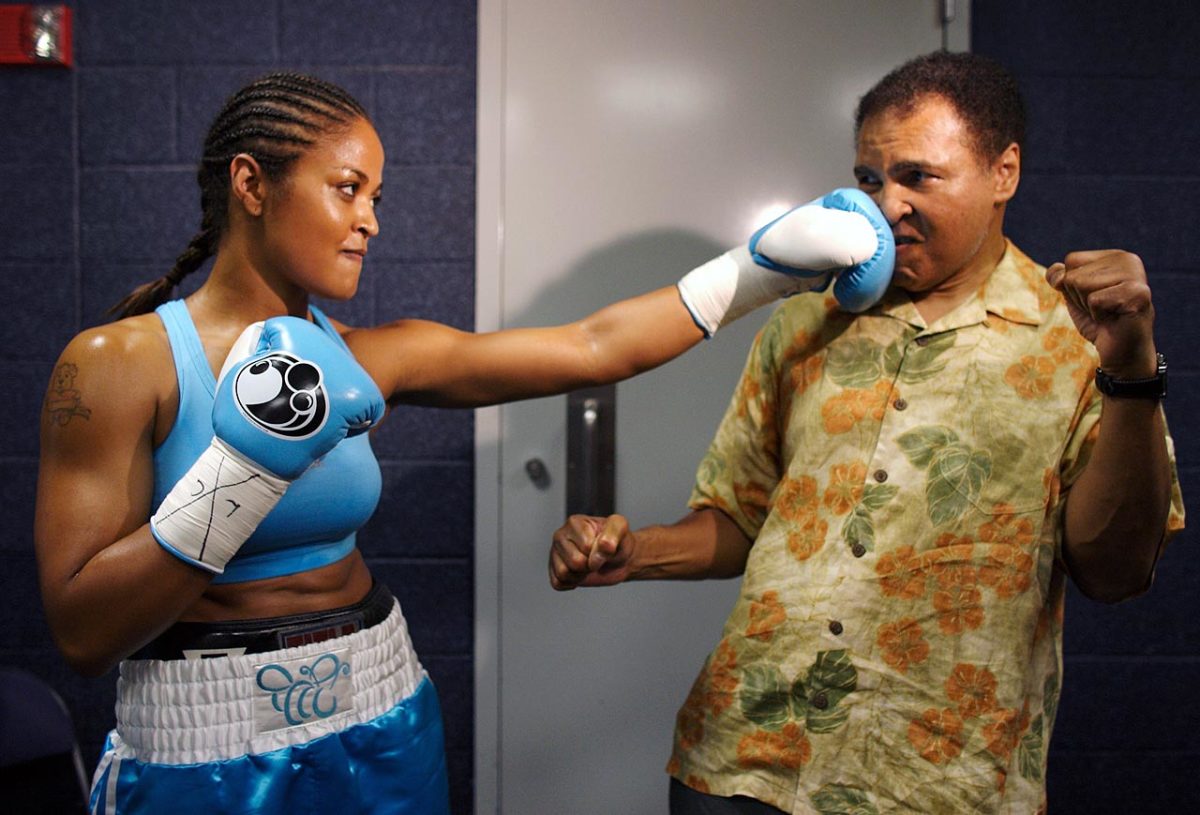
Ali takes a punch from his daughter Laila Ali while sparring before her fight against Erin Toughill in 2005. Laila retired from her own successful boxing career with a professional record of 24-0.
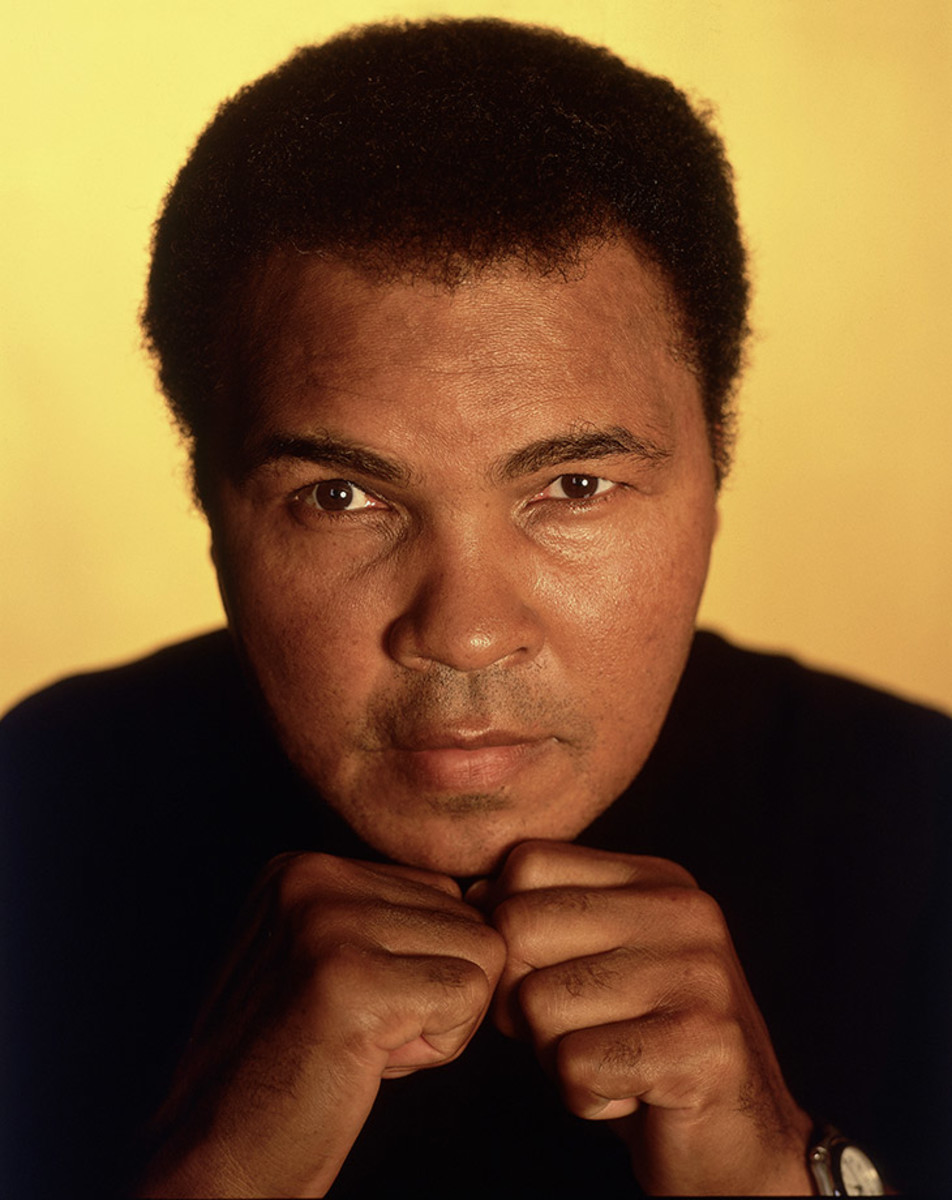
Ali poses with his fists up for a portrait in 2005.
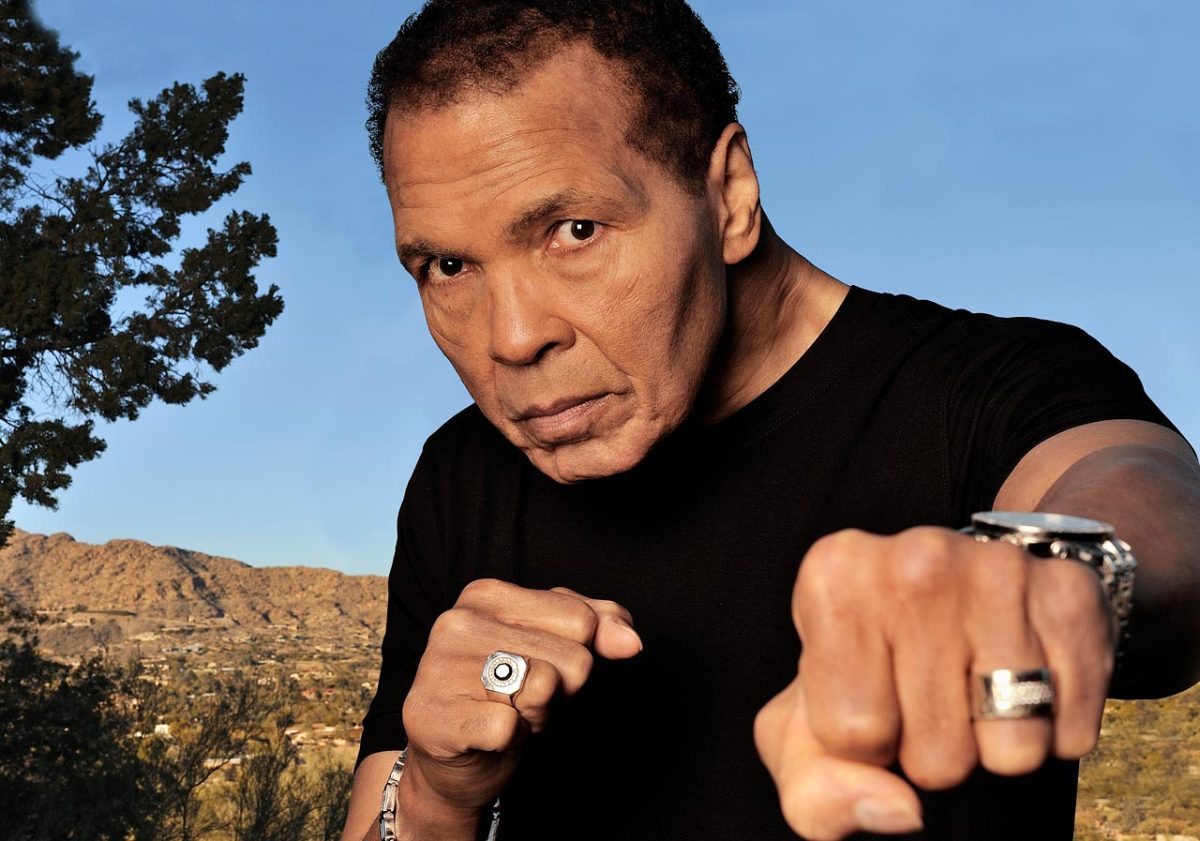
Ali poses with an extended punch in a 2012 photo shoot at his home in Paradise Valley, Ariz., to mark his 70th birthday.
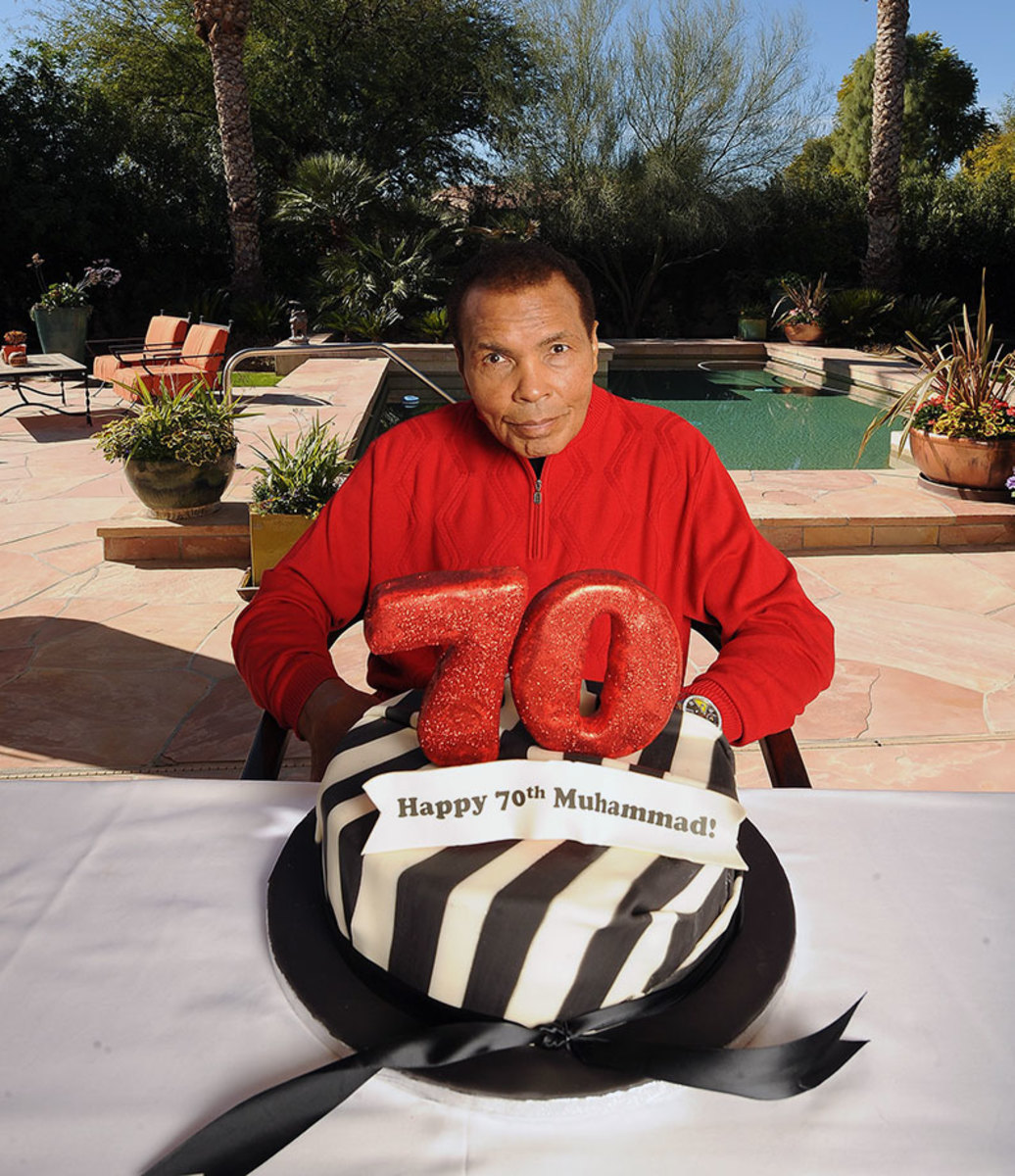
Ali sits in front of a 70th birthday cake in January 2012 at his Arizona home. Later that year he appeared at the opening ceremonies for the 2012 Olympics in London to escort the Olympic flag into the stadium, 52 years after he won gold in Rome.
